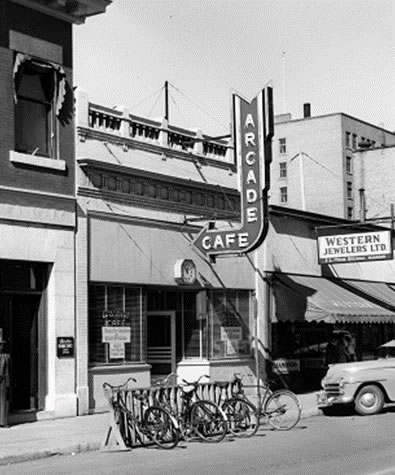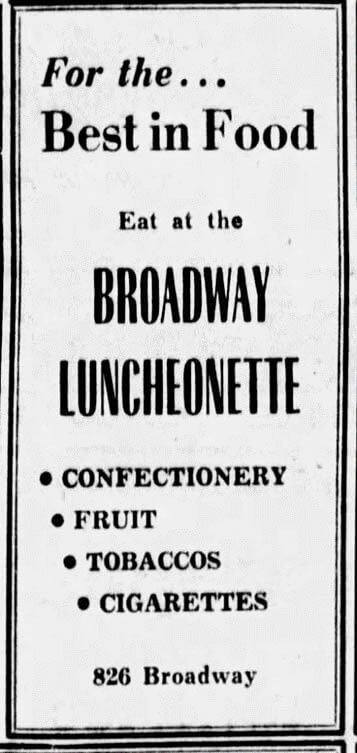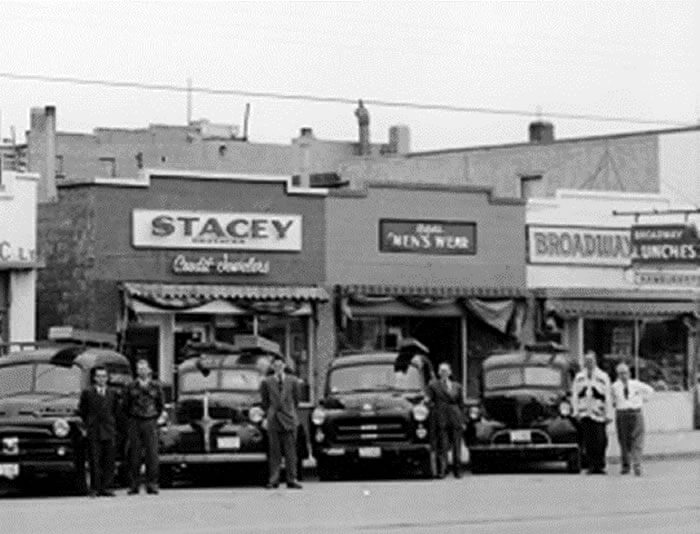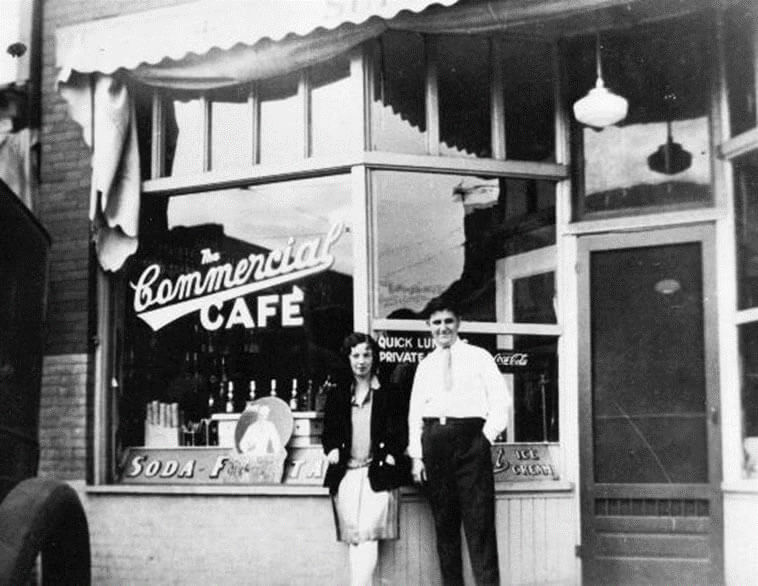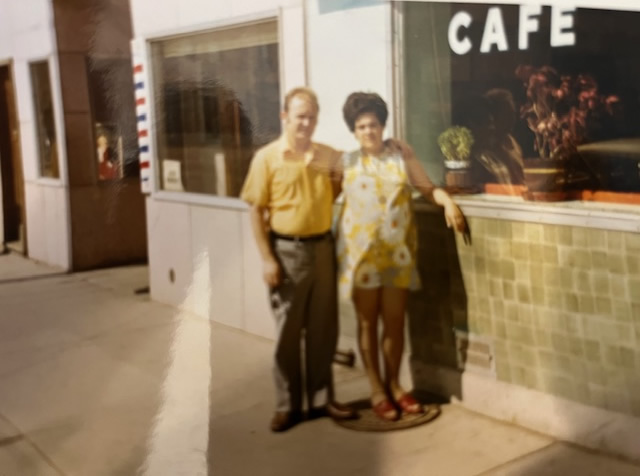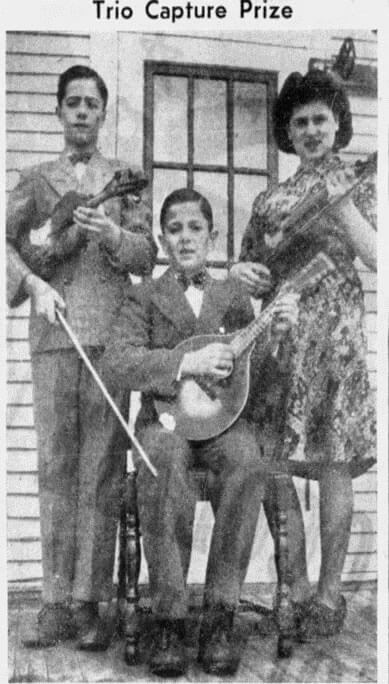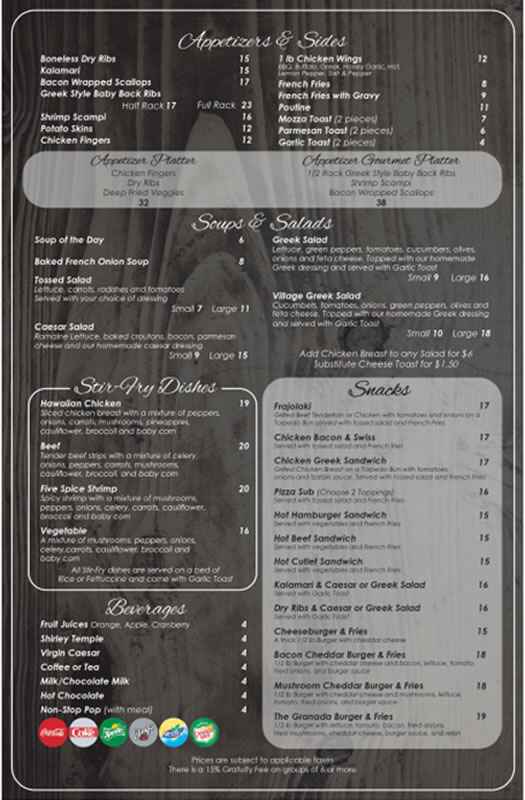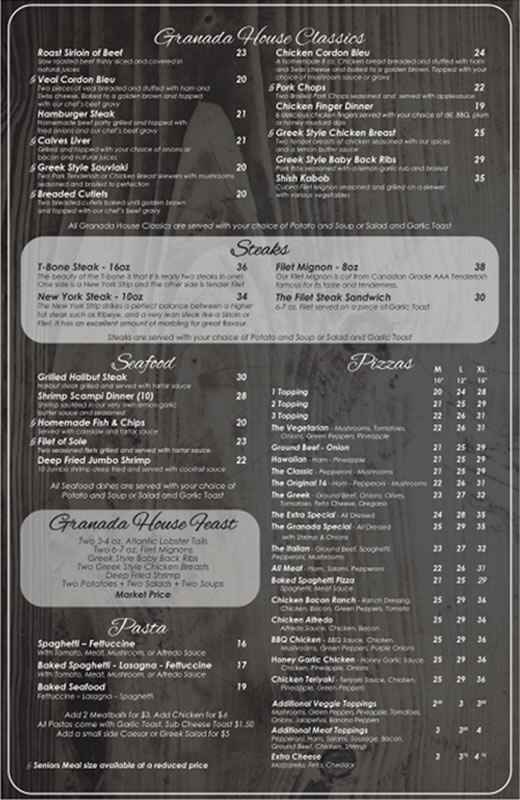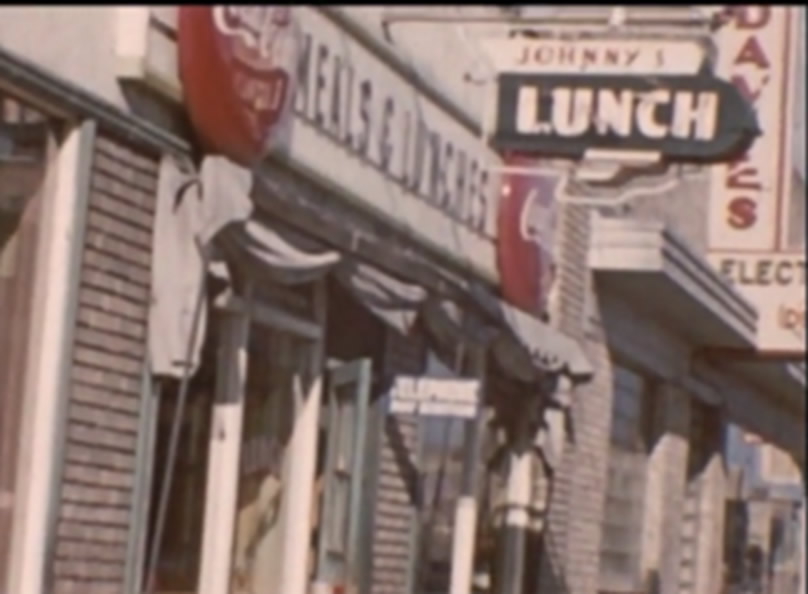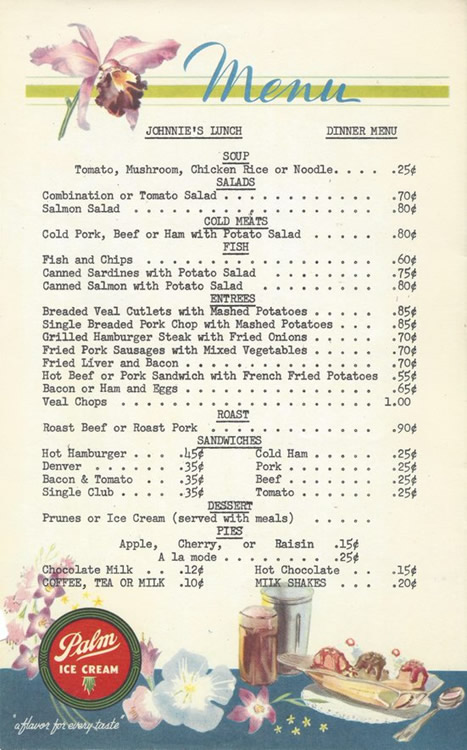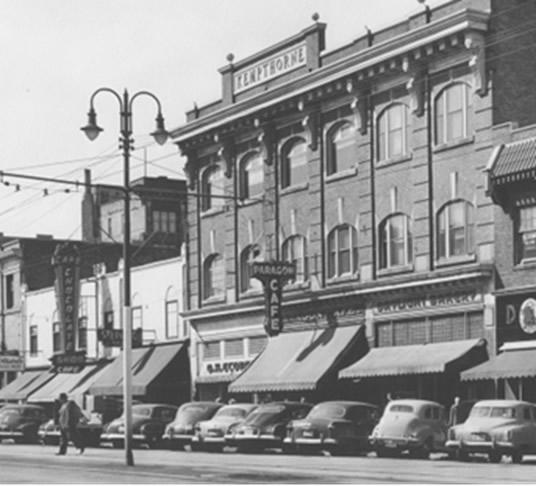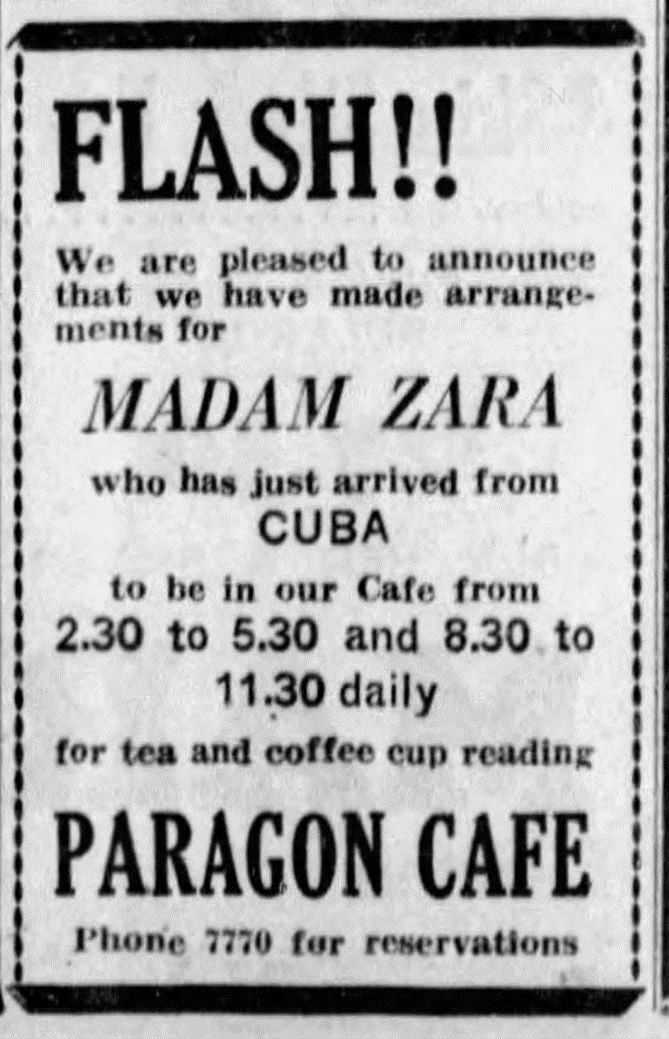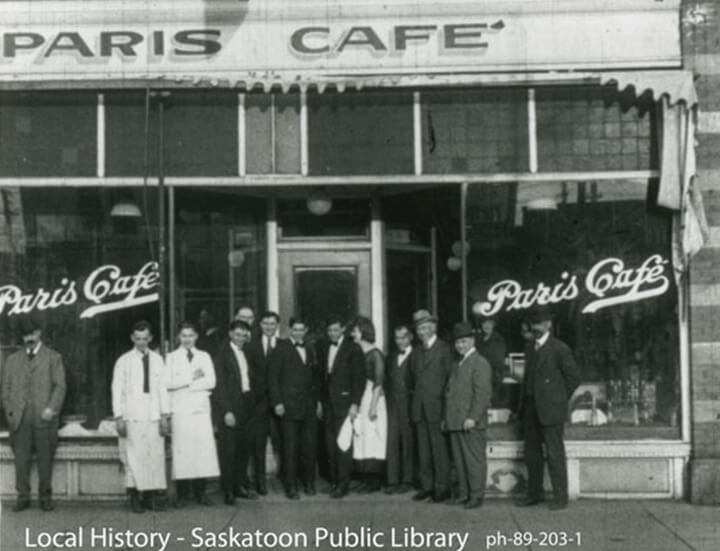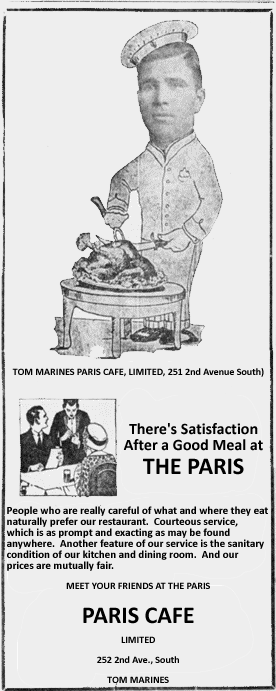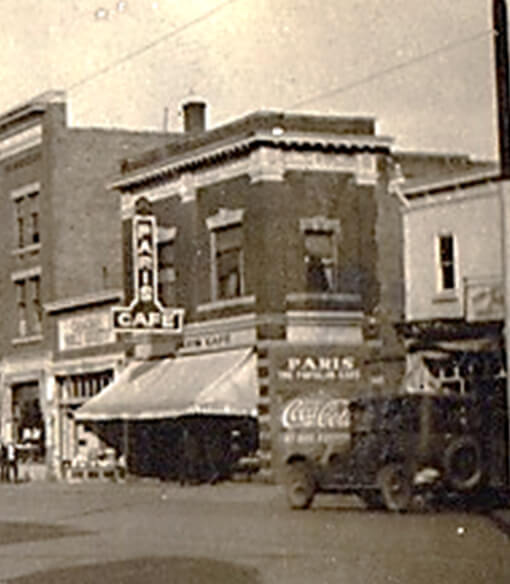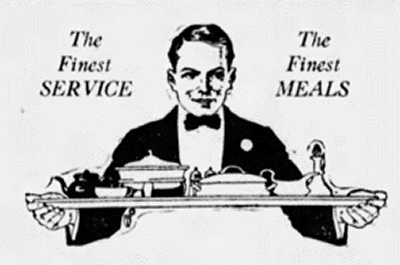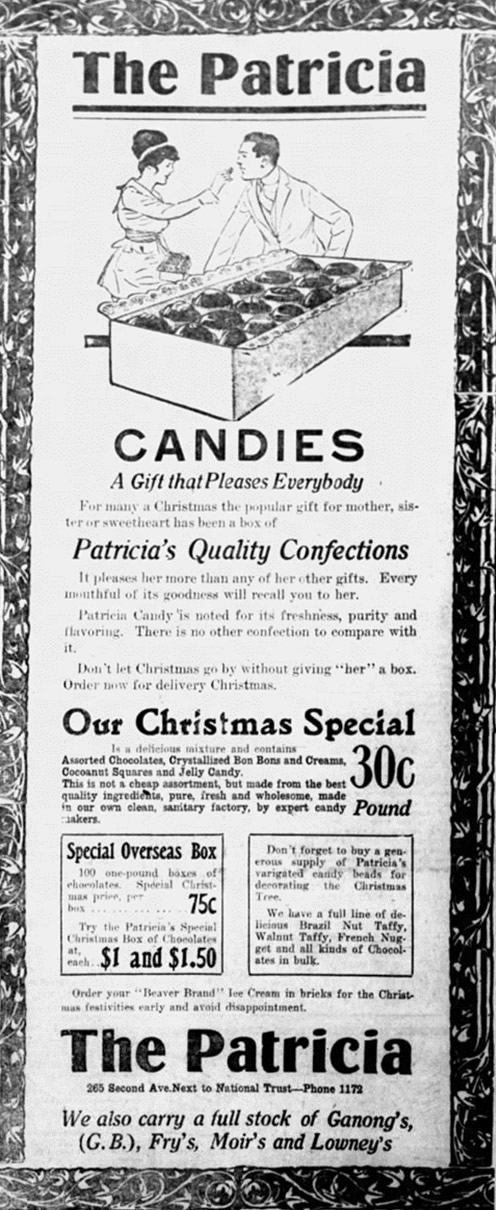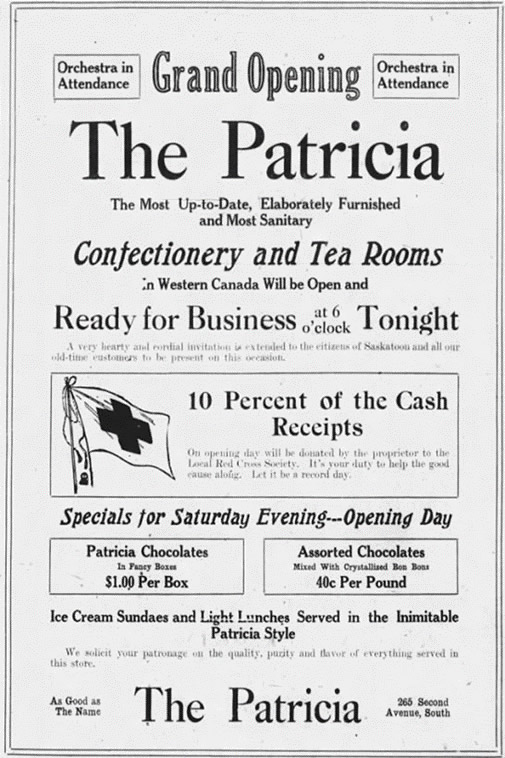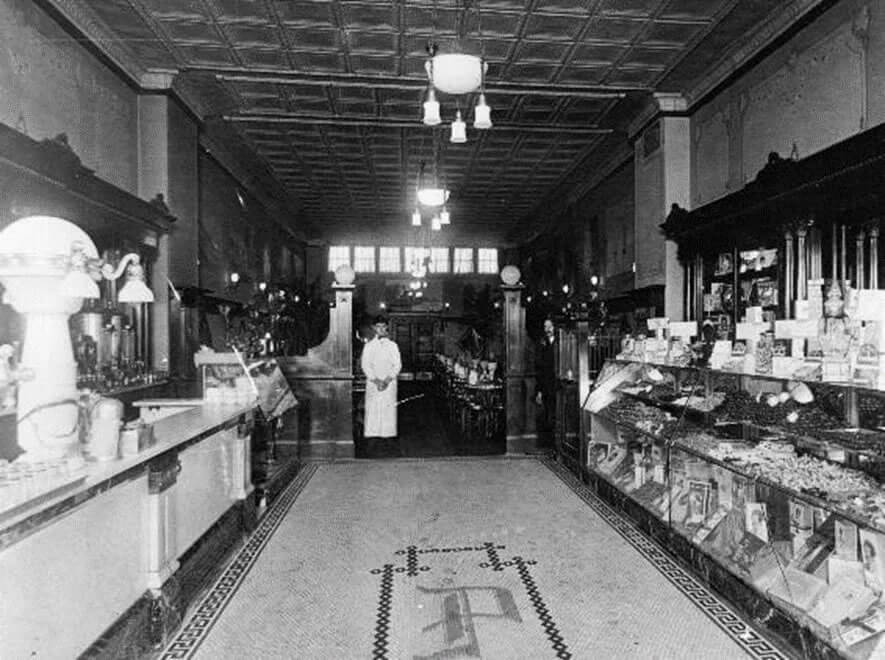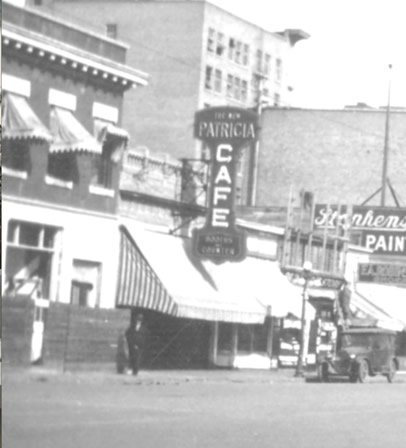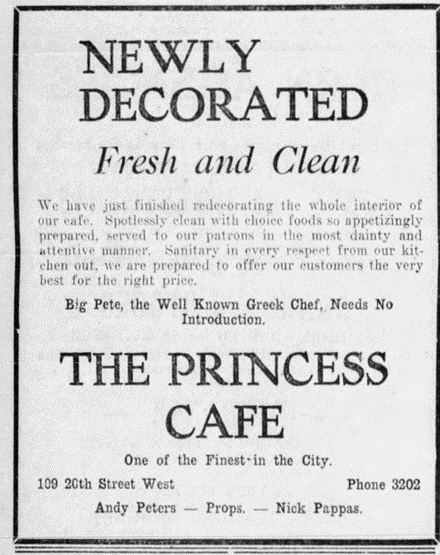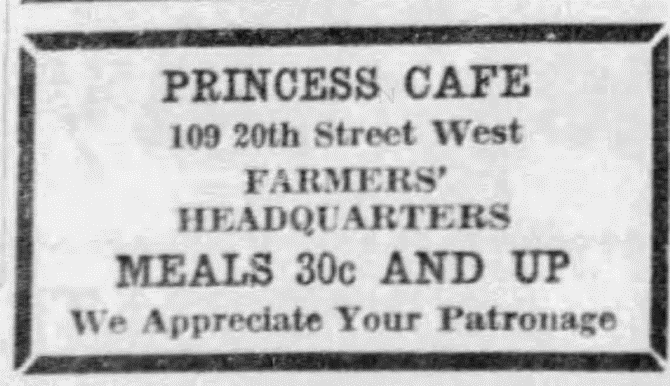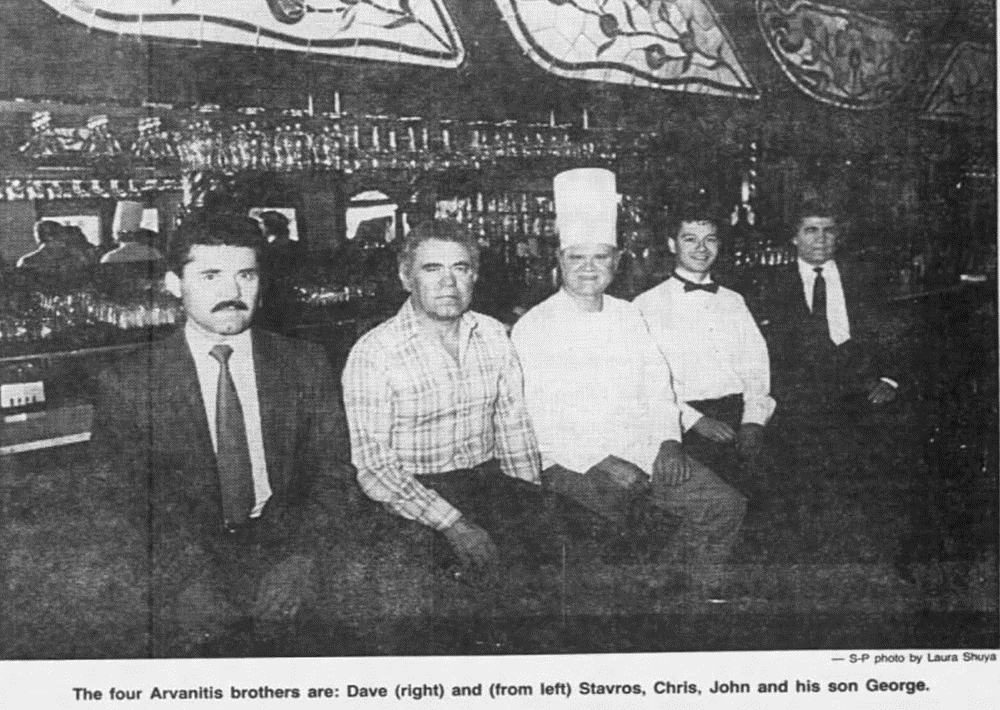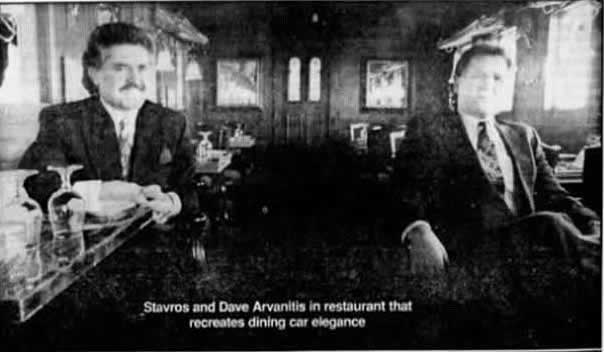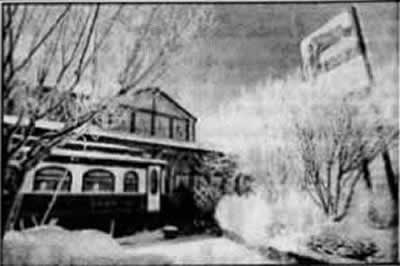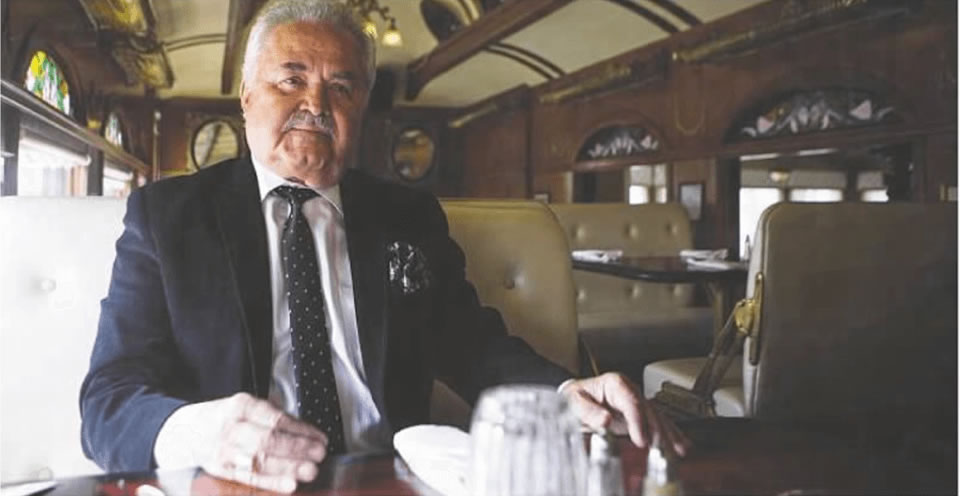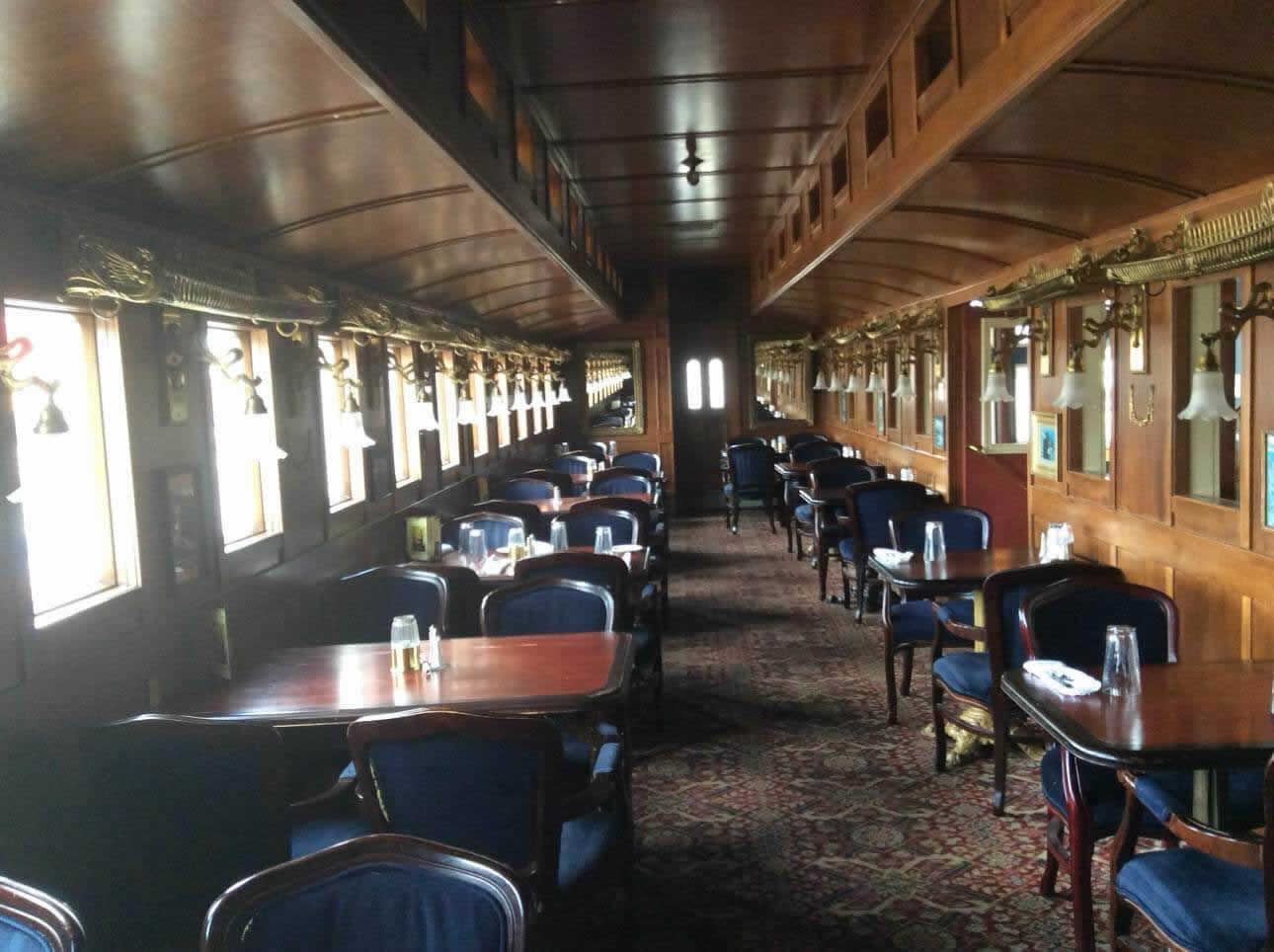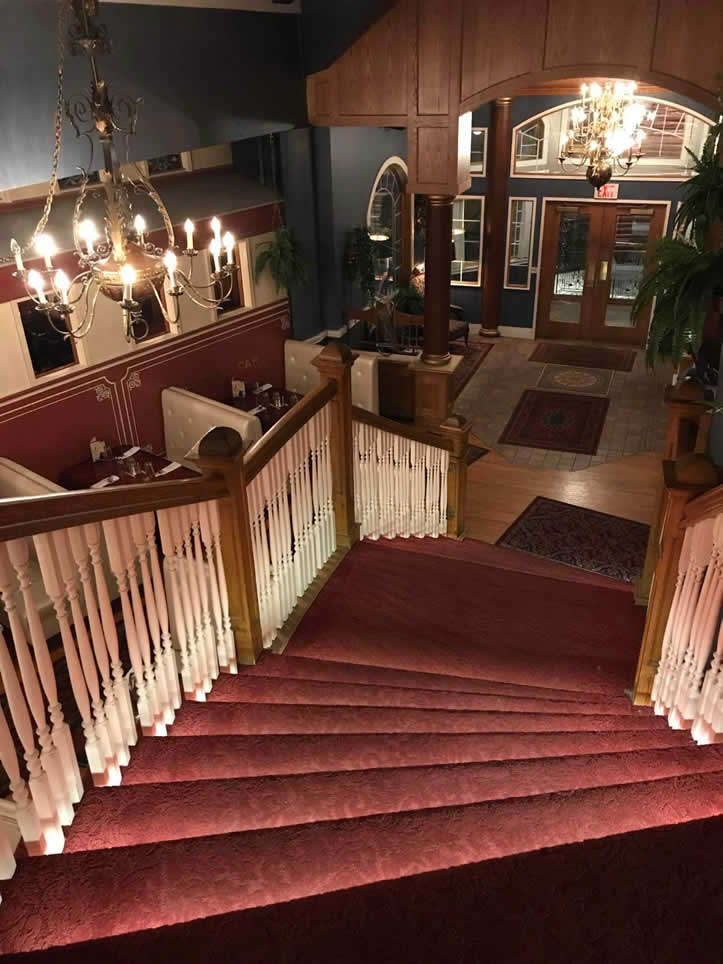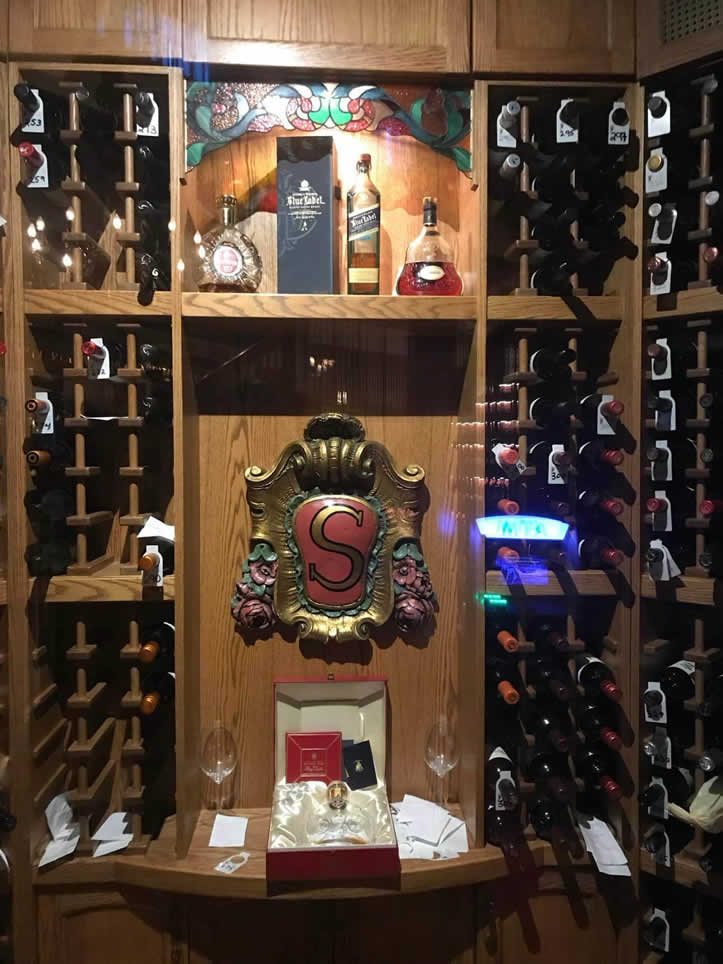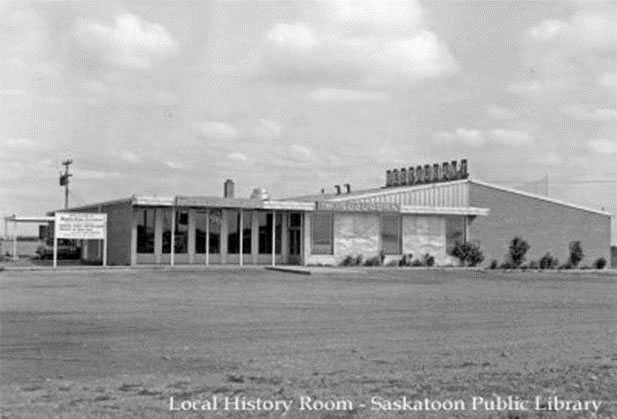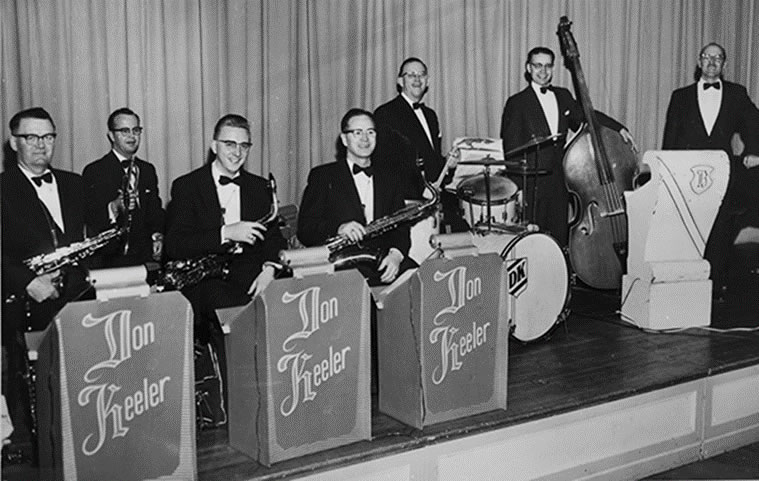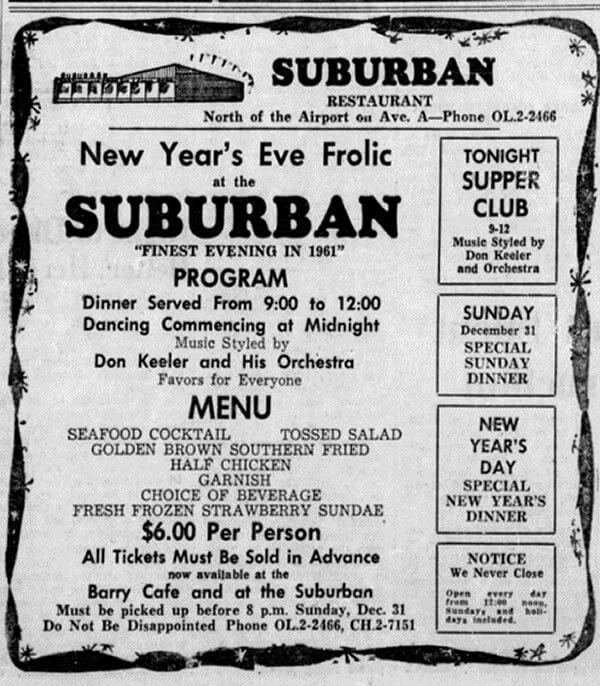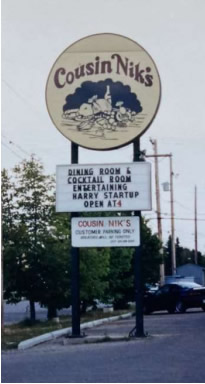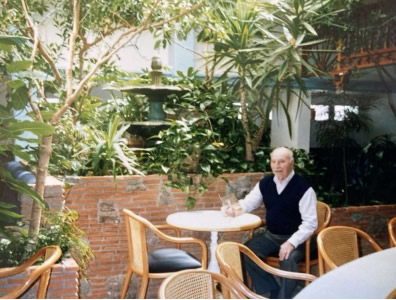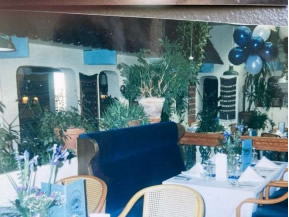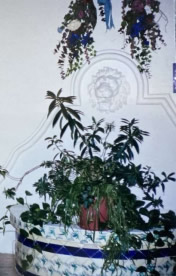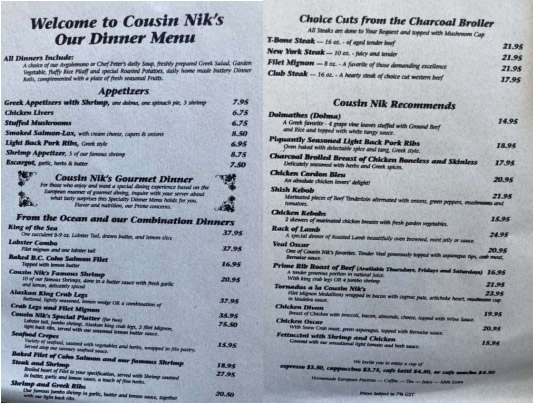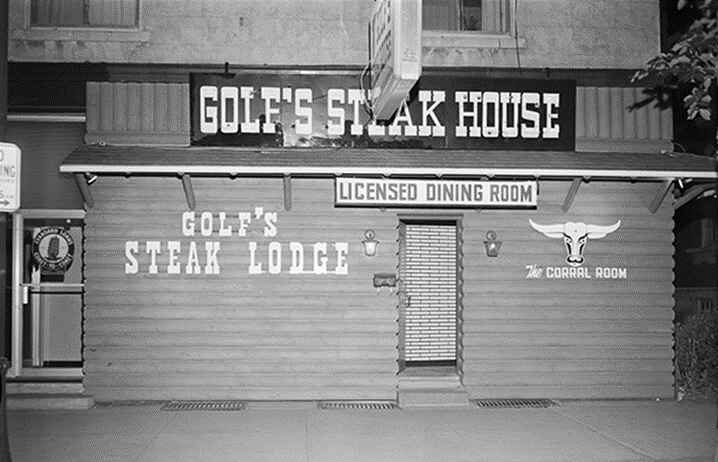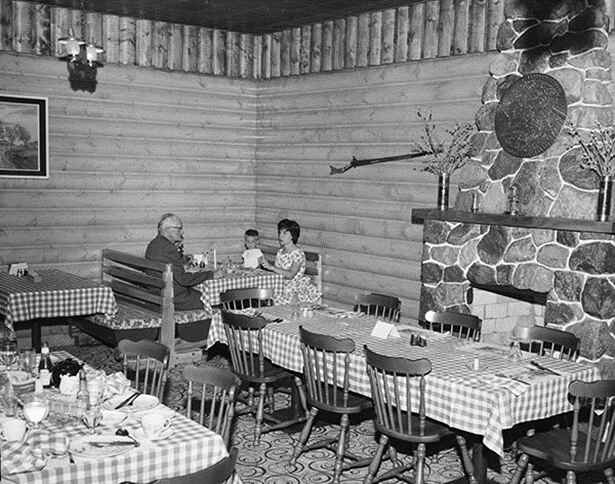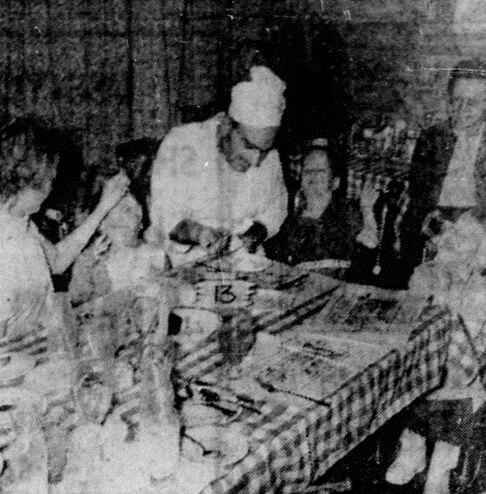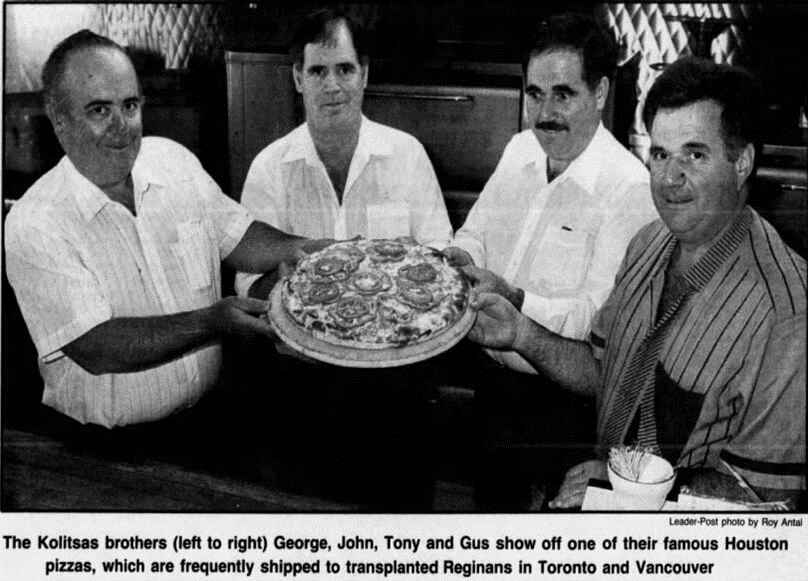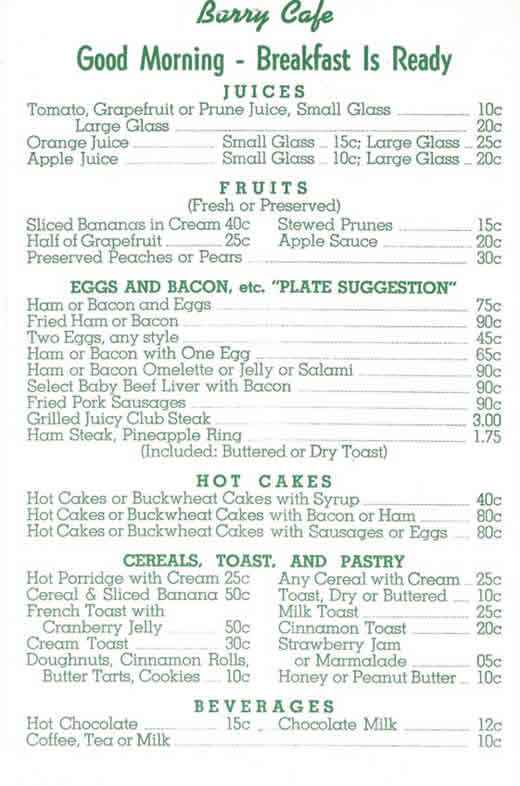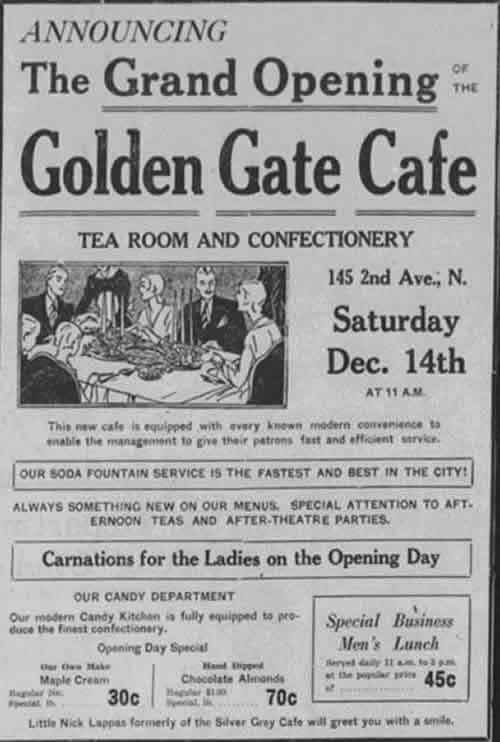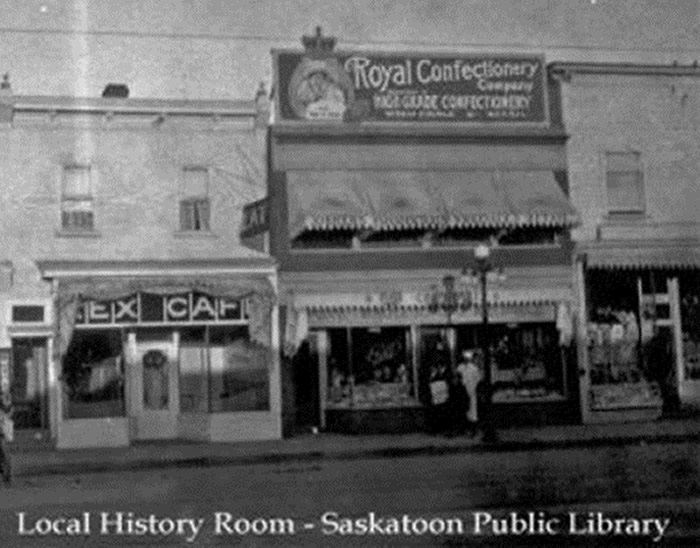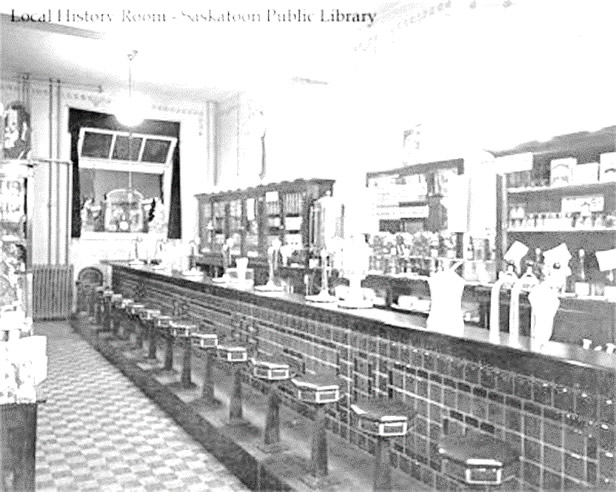Confectioneries, Cafes, and Restaurants
Saskatoon’s History Through the Lives and Experiences of It Greek Community
Many of Saskatoon’s earliest Greek cafes and restaurants started as confectioneries and tea rooms. The core of their operations was producing and selling chocolates, candies, and pastries, which they also marketed to department stores and other retailers in the city and beyond. They soon opened their own retail operations, in the form of tea rooms that often employed tea-cup readers. By the late 1920s and early 1930s, Greeks began converting their businesses or opening new businesses in the form of luncheonettes, coffee shops, cafes, and restaurants.
A feature of these businesses was a winding counter, often the length of the public space, and offering single seating in the form of swiveling stools. The counter, often referred to as “coffee row”, served customers from nearby businesses and offices who were on coffee breaks from work. Coffee rows provided customers with quick service, as well as lively discussions about local affairs. Some cafes and restaurants became known as the place to be for the latest news and gossip about specific issues and topics. Newspaper reporters would join in the discussion as they searched for leads and perspectives that could be included in their papers’ next edition. The Greek owners of these businesses were often identified in the newspaper articles and, therefore, were well known in the city.
Coffee Row, Elite Cafe
Ssskatoon Public Library, Local History Room (LH-6034)
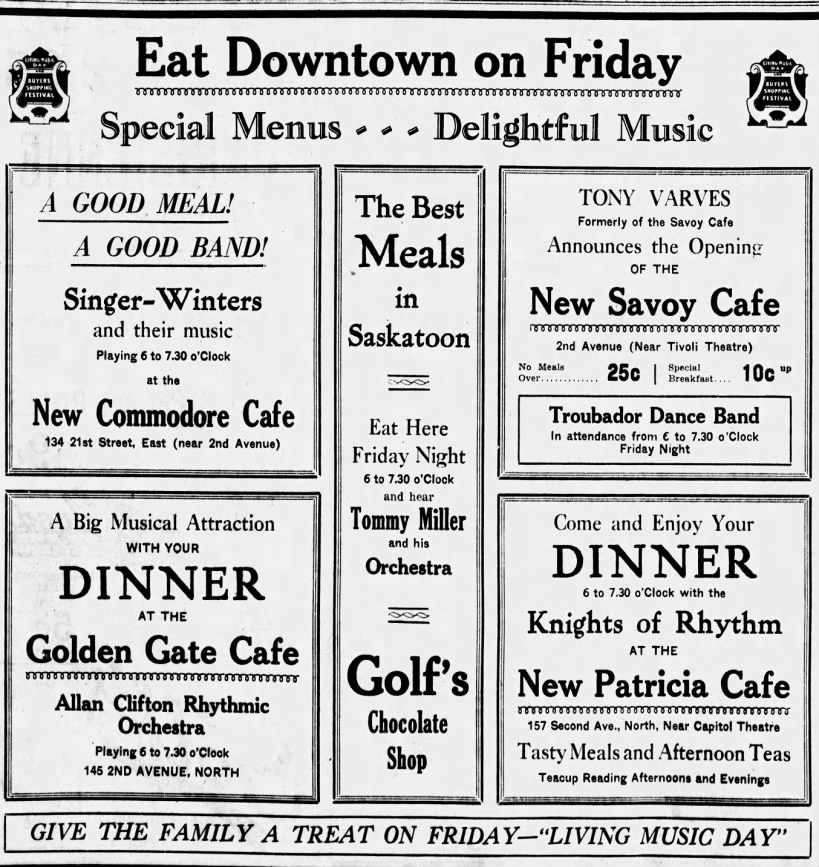
Downtown Greek restaurants participate in “Living Music Day” — A day when each restaurant offered performances of live music
Source: Saskatoon Star-Phoenix, October 5, 1933, p. 7.
Saskatoon's Greek Restaurants
Central Business District (north-south avenues, north of Twenty-second Street East)
108 Second Avenue North
- 1945 – 1980: Commodore Cafe (Second Location)
127 Second Avenue North
- 1914 – 1921: Princess Confectionery and Tea Room
132 Second Avenue North
- 1919 – 1924: Zenith Cafe (First Location)
136 Second Avenue North
- 1924 – 1938: Zenith Cafe (Second Location)
145 Second Avnue North
- 1921 – 1929: Princess Confectionery and Tea Room
- 1929 – ca 1934: Golden Gate Cafe and Confectionery
- 1936 – 1943: Cameo Cafe
Central Business District (north-south avenues, south of Twenty-second Street East)
142 Second Avenue South
- 1924 – 1931: Silver Gray Cafe and Gray Haven
- 1958 – ca 1969: Diana Grill
157 Second Avenue South
- 1933 – 1934: New Patricia Cafe (Second Location)
- 1934 – 1952: Paragon Cafe
167 Second Avenue South
- 1922 – 1952: Golf’s Chocolate Shop and Cafe
- 1953 – 1954: Golf’s Grill and Sweets
- 1954 – 1960: Golf’s Restaurant
213 Second Avenue South
- 1930 – 1939: Gem Cafe (First Location)
- 1939: Embassy Cafe
- 1939 – 1960: Shasta Cafe
224 Second Avenue South
- 1939 – 1971: Elite Cafe (Second Location)
242 and 244 Second Avenue South
- 1939 – 1971: Gem Cafe
246 Second Avenue South
- 1917 – 1939: Elite Cafe (First Location)
252 Second Aveue South
- 1920 – 1932: Paris Cafe
- 1932 – 1947: New Paris Cafe
265 Second Avenue South
- 1914 – 1926: Patricia Confectionery and Tea Room
- 1926 – 1933: New Patricia Cafe (First Location)
- 1942 – 1950: Arcade Cafe
351 Second Avenue South
- 1953 – 1956: Johnny’s Lunch
Central Business District (east-west streets)
123 Twentieth Street East
- 1947 – 1951: Club Lunch
118 Twenty-first Street East
- 1917: Main Cafe
- 1917 – 1931: Savoy Cafe
- 1931 – 1935: Ritz Cafe
- 1954 – 1984: Ritz Cafe
134 Twenty-first Street East
- 1917 – 1922: Golf’s Confectionery and Tea Rooms
- 1926 – 1945: Commodore Cafe (First location)
317 Twenty-first Street East
- 1961 – 1981: Golf’s Steak Lodge/Golf’s Steak House
Riversdale Business District
109 Twentieth Street West
- 1926 – 1931: Princess Cafe
118 Twentieth Street West
- 1928 – 1973: Commercial Cafe
201 Twentieth Street West
- 1954 – 1968: Barry Cafe
Broadway Business District
710 Broadway Avenue
- 1949 – 19564: Broadway Lunch
826 Broadway Avenue
- 1938 – 1949: Broadway Luncheonette
Other Locations (West)
904 Twenty-second Street West
- 1980 – 2021: Granada House Restaurant
Other Locations (East)
1110 Grosvenor Avenue
- 1979 – 1999: Cousin Nik’s
2911 Eighth Street East
- 1956 – 1959: Night Hawk Drive In
Other Locations (North)
221 Idylwyld Drive North
- 1985 2019: Saskatoon Station Place
Idylwyld Drive North (formerly Avenue A and Highway 11 and 12)
- 1959 – 1973: Surburban Restaurant
Arcade Cafe
Arcade Café
265 Second Avenue South
Owners/Operators: Chris, Tom, and Louis Kelles and Jim Stevenson (1942 – 1948);
Jim Boulis, Nick Cassios, and Ted Soromokos (1948 – 1950)
The Arcade Cafe opened in 1942 and occupied the space which previously housed the Patricia Cafe. This Cafe was operated by Tom, Chris, and Louis Kelles (Kelesides) and Mr. Jim Stevenson (Stavropoulos). They had been operating concessions for the previous 14 years at Crystal Beach, near Harris SK.
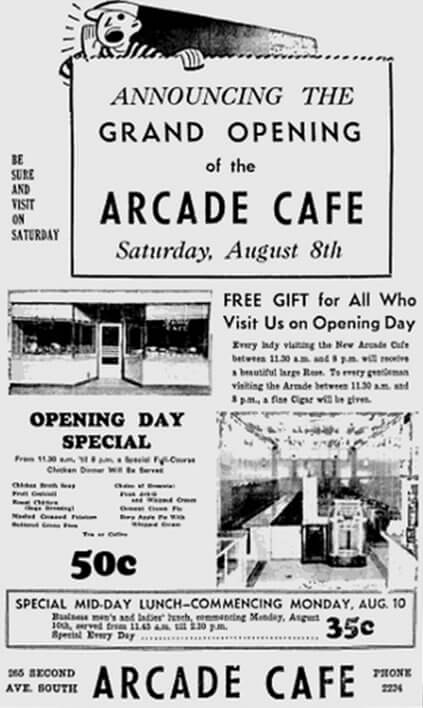
Source: Saskatoon Star-Phoenix, June 8, 1949, p. 6.
The Arcade Cafe (1948 or 1949)
Photo Source: Saskatoon Public Library, Local History
On opening day, the Saskatoon Star-Phoenix described the interior of the cafe:
“Spick and span in its renovated colors and equipment, the new Arcade Café presents an inviting atmosphere of cleanliness. The dining room has eight booths, each leather-backed and with smart pastel-colored tables as well as an open area of nine other tables. A 25-stool lunch counter, equipped with leather-covered stools trimmed with chromium, runs about three-quarters of the length of the building. There are sanitary washrooms on the main floor. Hot water always is provided.
A modern soda fountain and ice cream bar is another innovation.
The kitchen has modern facilities, including a refrigerator room for all perishable stock. The lighting fixtures are indirect-type chandeliers. Air-cooling facilities are also numbered among the conveniences installed for the patrons of The Arcade.
The cafe will also cater to the public with daily supplies of fresh fruits, considerably of the front premises having been given over to these purposes and attractively displayed. Some candles and boxed chocolates as well as a full line of tobaccos are purveyed from in-display cases.” (Saskatoon Star-Phoenix, August 7, 1942, p.5.)
Tom Kelles was described as the cafe’s “congenial manager” who was “very popular with the public and his pleasing manner and friendliness [made] the Arcade a popular eating place” (Saskatoon Star-Phoenix, March 9, 1946).
In November 1948, ownership of the Arcade Cafe had passed to Jim Boulis, Nick Cassios , and Ted Soromokos who were described as “experienced restaurant men with years of service in the business . . . .” (Saskatoon Star-Phoenix, April 22, 1950). Jim was the Cafe’s general manager, Nick was the head chef, and Ted was the assistant chef. They operated the Arcade Café until October 1950 when the business was sold to operators who were not members of the Greek community.
Researched by: Ken Pontikes, October 31, 2023.
Sources: Saskatoon Public Library, Local History; Saskatoon Star-Phoenix, various editions.
Broadway Lunch
Broadway Luncheonette/Broadway Lunch
826 Broadway Avenue and 710 Broadway Avenue
Owner/operator: Agellos George (“Charlie”) Kallops (1938 – 1954)
Agellos (“Charlie”) Kallops previously owned the Golden Gate Cafe and Confectionary. In 1935, he moved to Prince Albert and returned in 1938 to open the Broadway Luncheonette at 826 Broadway Avenue. In 1946, overheated pipes caused a fire and explosion which damaged the luncheonette on the main floor and several apartments on the second floor. The fire and water damage was repaired and the luncheonette reopened.
Source: Saskatoon Star-Phoenix, October 11, 1946, p. 6.
In 1949, Charlie relocated the luncheonette in renovated space at 710 Broadway Avenue. He renamed the business as the Broadway Lunch and continued to operate it until his death in 1954. The business was subsequently, in 1955, purchased by Percy Harvey, formerly of the Red Robin Cafe.
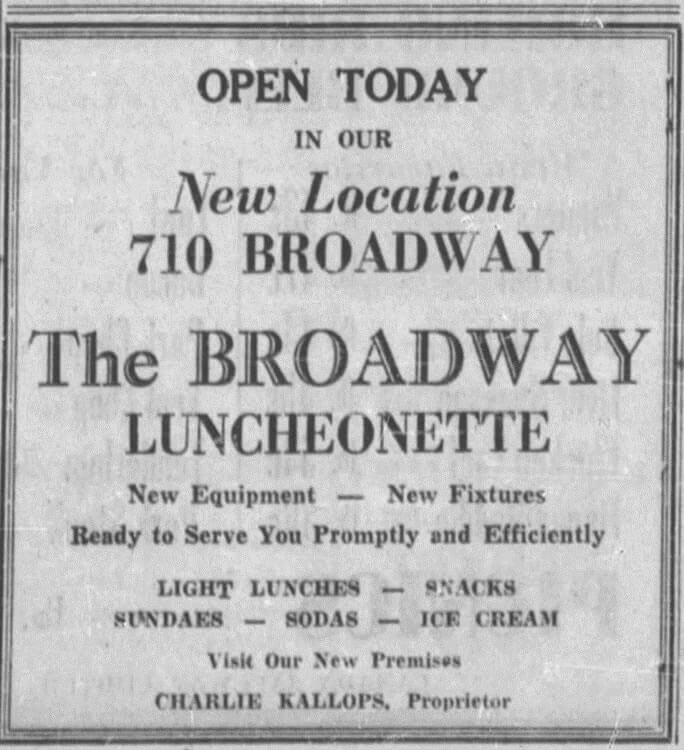 Source: Saskatoon Star-Phoenix, June 8, 1949, p. 6.
Source: Saskatoon Star-Phoenix, June 8, 1949, p. 6.
Broadway Lunch, 710 Broadway Avenue (early 1950s)
Source: Saskatoon Public Library, Local History Room (PH-97-30-10)
Researched by Ken Pontikes, December 14, 2023.
Sources: Saskatoon Star-Phoenix, various editions.
Commercial Cafe
Commercial Café
118 – 20th Street West
Owners: George Karabelis and George Chitsas (1928 – 1949); George Karabelis (1949 – 1962); Speros J. Kokonas and Nikitas (Nick) S. Kokonas (1962 – possibly 1969); and George Antonopoulos and Alex Liakopoulos (1969 – 1973)
George Karabelis came to Canada in 1911. He operated businesses in Weyburn and later in Chicago. He moved to Saskatoon in 1928 when he bought the Commercial Cafe. He operated the Commercial Cafe in partnership with George Chitsas and then on his own following Mr. Chitsas’s death in October 1949.
George Karabelis and his wife, Madge, are standing in front of the Commercial Cafe (1929)
Source: Saskatoon Public Library, Local History Room (LH-6002)
Shirley and Alex Liakopoulos were a Greek family that would buy into the Commercial Cafe as the years passed by.

Saskatoon Star-Phoenix, April 30, 1932, p. 16.
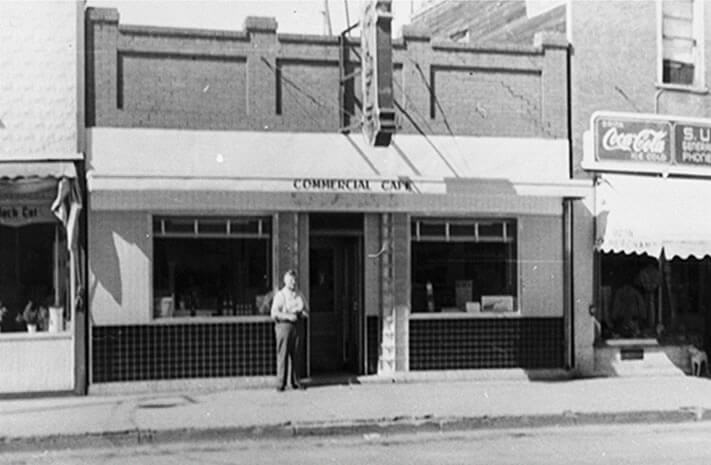
George Karabelis standing in front of the Commercial Café (1949)
Source: Saskatoon Public Library, Local History Room (LH-6023)
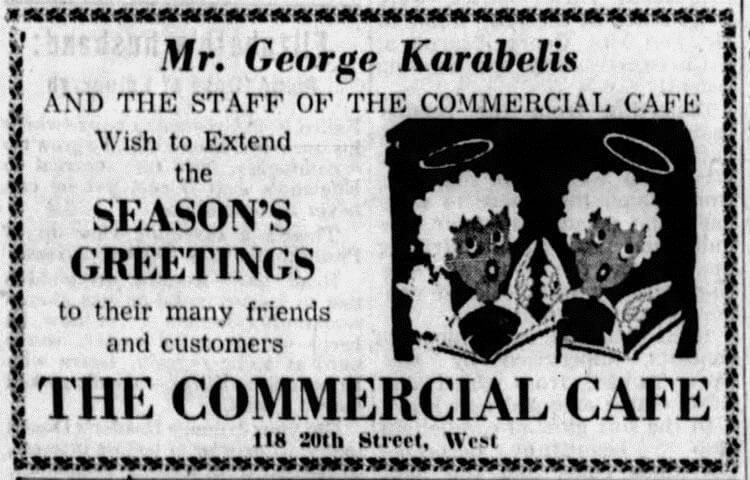
Saskatoon Star-Phoenix, December 24, 1951, p. 7.
Following George Karabelis ‘s death in 1962, the Commercial Café was operated by Speros J. Kokonas and Nikitas (Nick) S. Kokonas and later by George Antonopoulos and Alex Liakopoulos.
Researched by Ken Pontikes, September 28, 2023
Sources: Saskatoon Star-Phoenix, June 27, 1951, p. 10 and September 16, 1969, p. 17.
Commodore Cafe
Commodore /New Commodore Café
134 – 21st Street East and 108 Second Avenue North
Owners (Commodore /New Commodore): Harry Terzkis, Nick Giokas, and Gust Nantsos (1926 – 1929), Harry Terzakis and Nick Lappas (1929 – 1932), Steve Leakos and subsequently Spero Leakos (1932 – 1972), Nikitas (Nick) Kokonas and Alex Liakopoulos (1972 – 1980), and several subsequent owners.
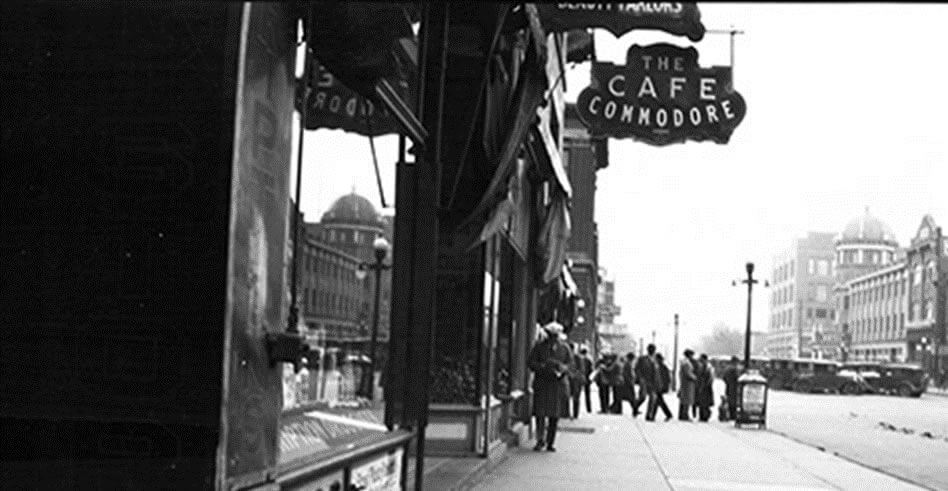
Commodore Café, located in the Bowerman Block on Twenty-first Street East, ca 1929
Source: Saskatoon Public Library, Local History Room (PH-88-970)
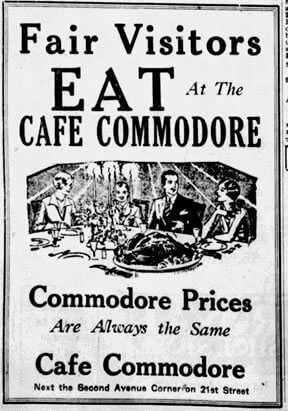
Saskatoon Star-Phoenix, July 15, 1930, p. 26.
Steve Leakos emigrated to the United from Greece in 1906. He was employed building railways in Alaska and then entered the restaurant industry in San Fransisco. Subsequently, in 1923, he lived in Vancouver where he married is wife, Agatha Kortes. Steve and his family moved to Moose Jaw in 1927 to help in a business started by Agata’s brothers. In 1932, Steve moved with his family to Saskatoon to take over the operation of the Commodore Café located in the Bowerman Block on Twenty-first Street East, between 1st and 2nd Avenues.
The Cafe was originally opened in the space (at 134 Twenty-first Street East) that was previously occupied by Golf’s Electric Bakery. The Electric Bakery had been replaced by the Commodore Cafe in 1926 which was being operated by a partnership consisting of Harry Terzakis, Gus Natsos, and Nick Giokas. At the time of the sale of the business to Steve Leakos, the partnership had dissolved and the business was being run by Harry Terzakis and Nick Lappas.
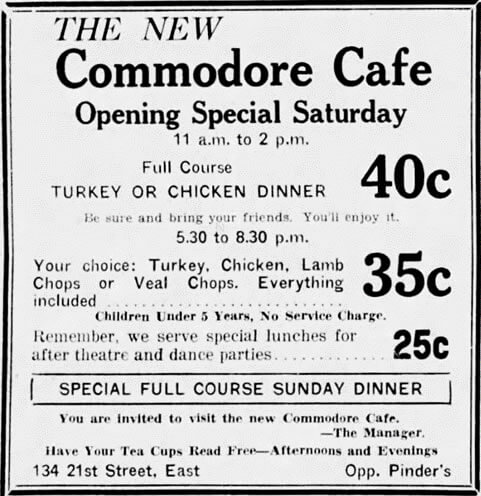
Saskatoon Star-Phoenix, November 4, 1932, p. 22
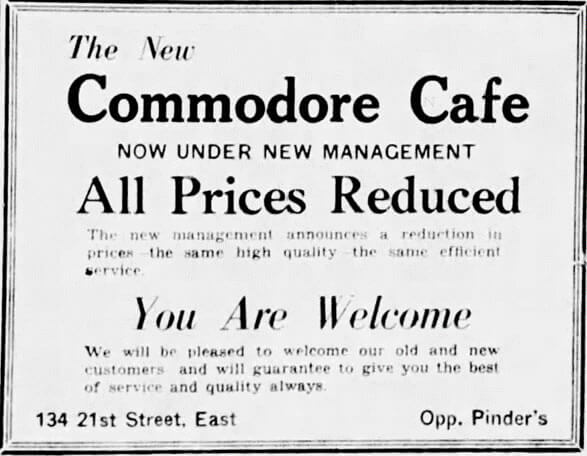
Saskatoon Star-Phoenix, November 3, 1932, p. 11.
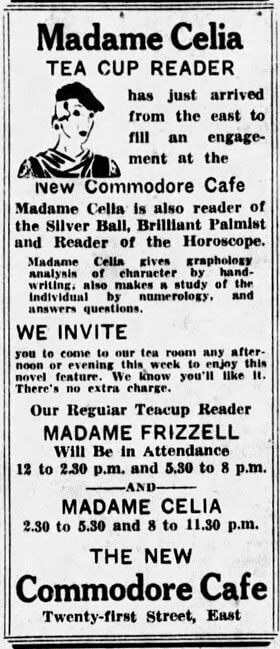
Saskatoon Star-Phoenix, January 24, 1934, p. 8
Steve Leakos’ three children – Evangeline, Spero, and James – formed the Leakos Trio and performed frequently at the Commodore Cafe. They won first prize in 1940 at an amateur night sponsored by the Saskatoon Lodge of the International Order of Foresters (I.O.O.F). For a while, they were the featured entertainment during Sunday evening dinners at the Café.
The Leakos Trio (right to left): Evangeline, Spero and Jimmy Leakos
Saskatoon Star-Phoenix, March 13, 1940, p. 6.
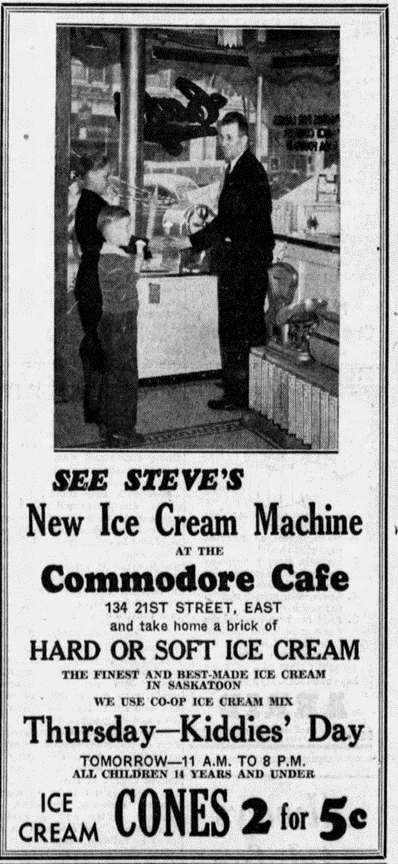
Saskatoon Star-Phoenix, August 14, 1940, p. 6.
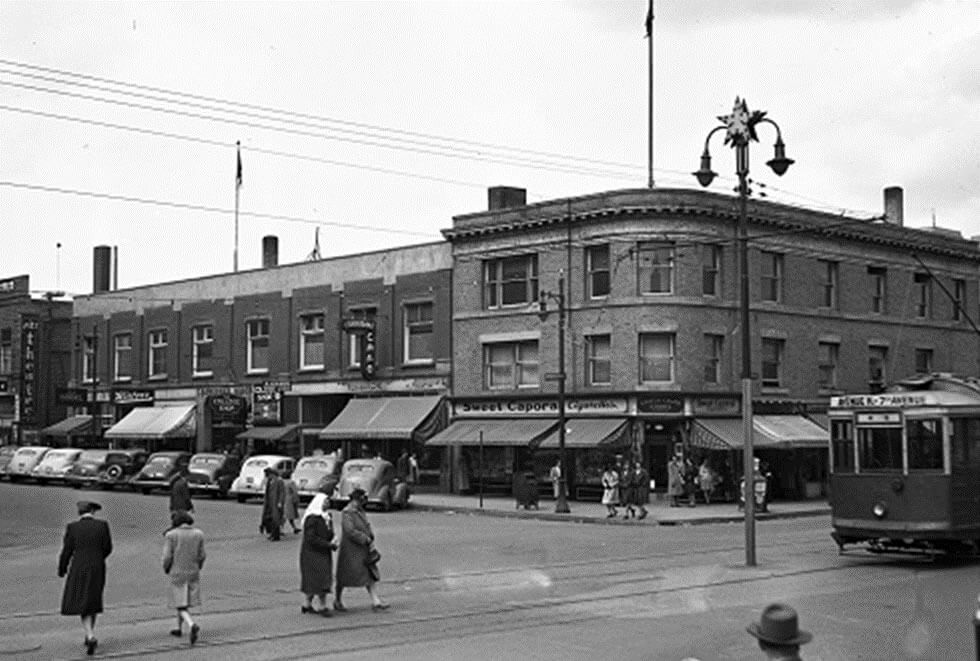
Commodore Café, located in the Bowerman Block on Twenty-first Street East between First and Second Avenues South, ca 1940
Source: Saskatoon Public Library, Local History Room (B-136)
In 1944, new owners of the Bowerman Block entered into an agreement with Caswells Limited (a men’s wear store) to relocate and occupy the entire building. This required ending leases with six existing businesses, including the Commodore Cafe; the lease with Caswells involved removing partitions that separated this business, as well as establishing a higher ceiling for the store by opening the main floor to the second floor.
On December 24, 1945, the Commodore Cafe relocated from the Bowerman Block to property he purchased at 108 Second Avenue North. A formal grand opening was delayed until March 1946. The new location involved alterations and an addition (to accommodate the kitchen) to an existing building.
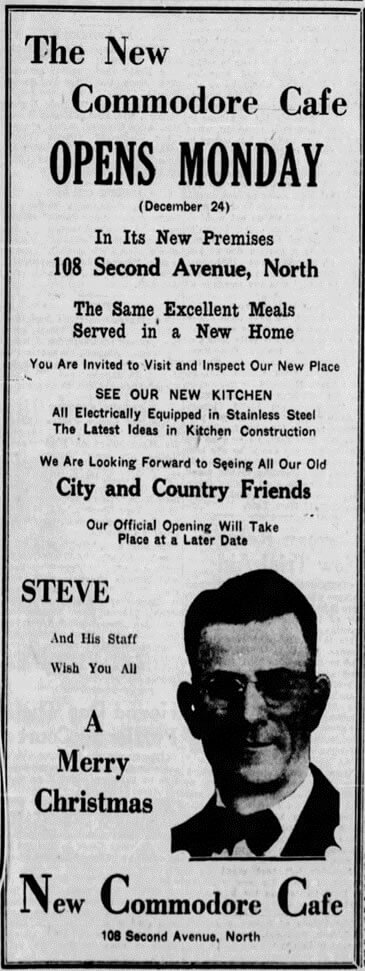
Saskatoon Star-Phoenix, December 22, 1945, p. 5.
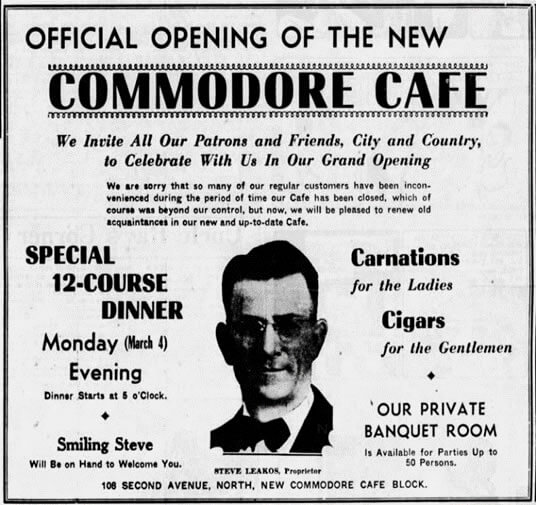
Saskatoon Star-Phoenix, March 4, 1946, p. 11.
In 1950, the café underwent further major renovation:
“[Leakos] changed the floor plan entirely, and all fixtures and equipment have been replaced with the latest and best procurable on the market today. Different booths of various sizes accommodate parties from six to 14 persons, giveing both privacy and good service. The counter down one side is equipped to satisfy busy customers. Modern materials have been used througout. The booth panels are of arborite; the table tops and counter are covered with formica; and the seats are beautiful leather, the best that money could buy. The table legs are chrome. The floors are terrazza, and in the well equipped kitchen the stam table and all utensils are stainless steel. The dishes are expensive and attractive. Everything from top to bottom is absolutely new, and provides for cleanliness and orderlilness” (Saskatoon Star-Phoenix, November 10, 1950, p. 21).
Nick Cassios left the Arcade Cafe and became the main chef at the Commodore.
In 1956, the cafe at the Second Avenue location added a banquet room known as the Corvette Room.
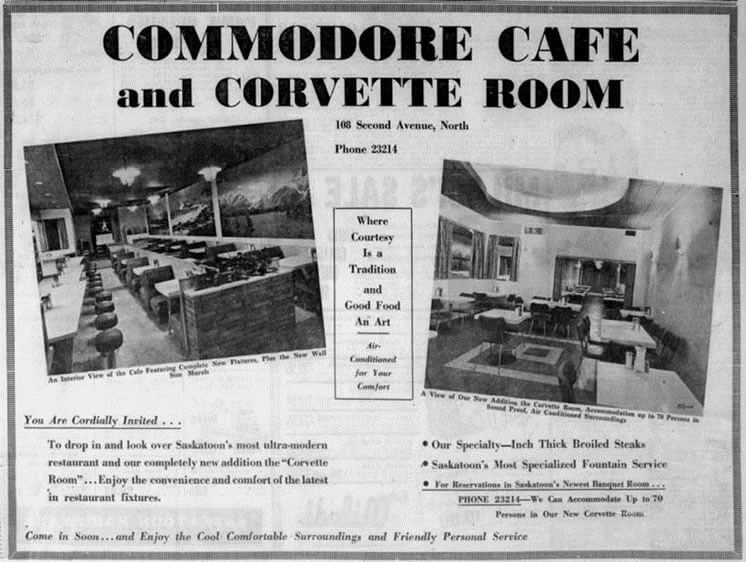
Saskatoon Star-Phoenix, July 6, 1956, p. 10
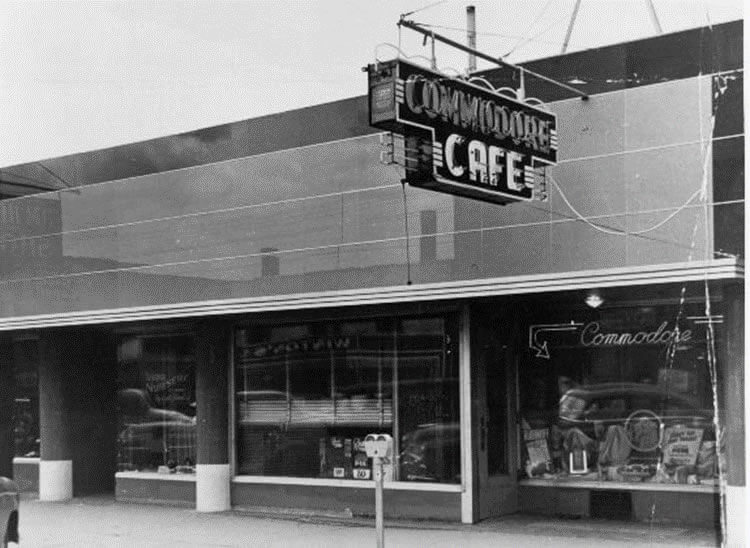
Commodore Café, 108 Second Avenue South location (1952)
Source: Hillyard Photographs Collection, Saskatoon Public Library (B-8700)
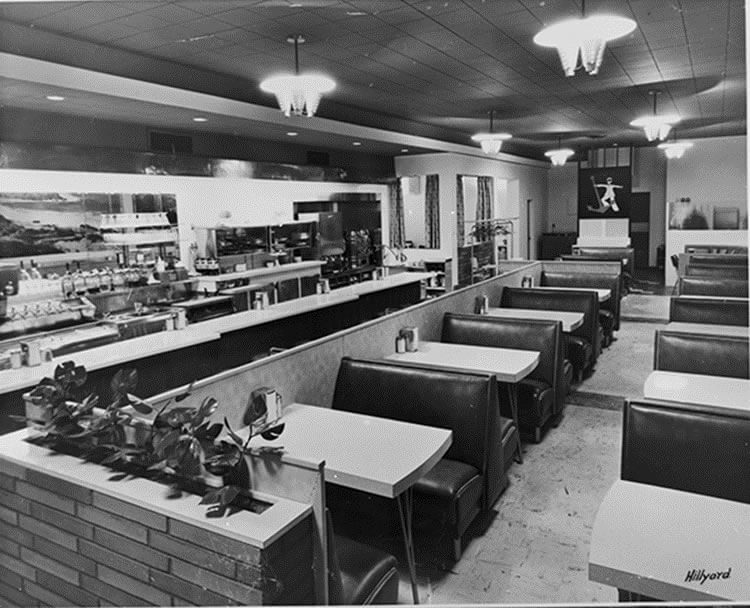
Commodore Café, 108 Second Avenue North (1968)
Source: Saskatoon Public Library, Local History Room (LH-6076)
Throughout their operation of a café in both locations in downtown Saskatoon, the Leakos Family and the Commodore Café were responsible many sports sponsorships and the nurturing of many young athletes in Saskatoon. Most notable was the family’s administrative involvement with the Saskatoon Gems baseball team which evolved into the family’s ownership of the Saskatoon Commodore’s semi-pro baseball team. However, the family’s support also extended to include the local hockey, basketball, and soccer communities.
Nikitas Kokonas and Alex Liakopoulos purchased the Commodore Cafe in February 1973. The Leakos family sold the Commodore after forty-one years of continuous ownership and operation. The new owners renovated the café in 1975.
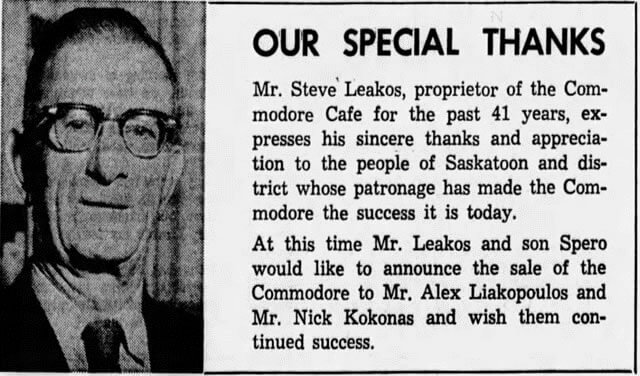
Saskatoon Star-Phoenix, February 3, 1973, p. 4.
In 1980, Nikitas and Alex sold their interest in this business and entered into a partnership with Bill Kondos and George Kondos in the Granada House Restaurant (904 Twenty-second Street West).
Researched by Ken Pontikes, September 24, 2023 and July 15, 2024 (most recent update).
Sources: Saskatoon Star-Phoenix, May 15, 1930, p. 6; May 28, 1932, p. 3; April 22, 1945, p. 3; November 3, 1944, p. 3; December 22, 1945, p. 5; November 10, 1950, p. 21; and July 15, 1975, p. 10; Ned Powers, “Spero Leakos”, Saskatoon: The Powers Interviews (Saskatoon: Thistledown Press, 2006, pp. 79 – 83.
Elite Café
Elite Café
246 Second Avenue South (1917 – 1939)
224 Second Avenue South (1939 – 1971)
Owners/Operators: Sam Serif (1917 – 1919); William K. Shourounes, Tony Varvis, and James Gourgoules (Girgulis) plus William H. Gourgoules, Tom Varve, and James Pontikes (1919 – 1922); Willam H. Girgulis and James H. Girgulis plus Sam H. Girgulis (1922 – 1971)
The Elite Café opened in June 1917 at its first location in the Kerr Block (246 Second Avenue South) and was under the ownership of Sam Serif. In 1919, Sam sold the café to the owners of the Savoy Café Company, a partnership consisting of William K. Shourounes, Tony Varves (Varvistsoitis), and James Gourgoules (Girgulis). This partnership therefore operated two cafes at the same time – the Elite Café (on Second Avenue South) and the Savoy Café (on Twenty-first Street East).
The Elite Café occupied 1,900 square feet and employed a staff of 15. It had 13 booths, with a seating capacity of 52. The lunch counter could accommodate 22 customers.

Saskatoon Daily Star, March 8, 1919, p. 16.
By 1922, the ownership of the Savoy and Elite Café was reported to have expanded to six partners. Athanasios (“Tom”) Varves (who was Tony’s brother), William H. Gourgoules (who was James’ brother), and James Pontikis. In May of that year, the partnership was dissolved and the ownership of the two cafes was split. The Girgulis brothers became the sole owners of the Elite Café.
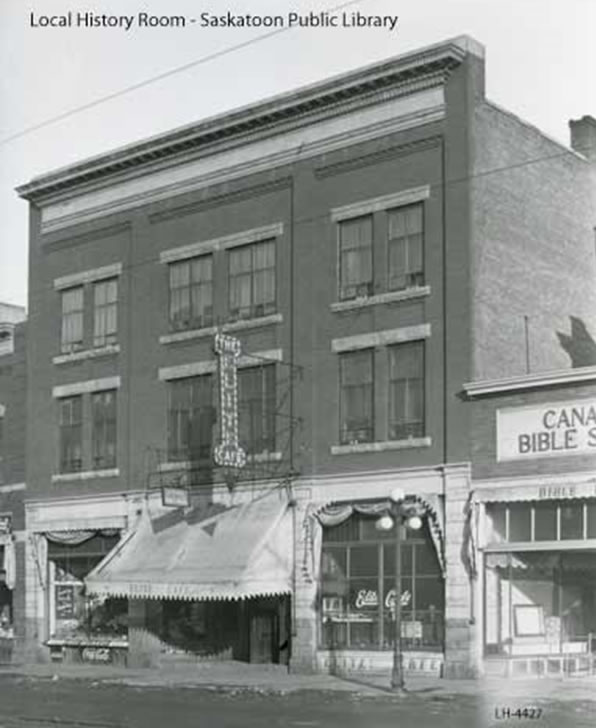
Elite Café (ca 1930), 246 Second Avenue South
Source: Saskatoon Public Library, Local History (LH-4427)
James and Williams’ younger brother, Sam, came to Saskatoon with their father in 1922. Sam worked his way into the business – from dish boy to head waiter – before joining the partnership.
In April 1931, suspicious fires in three locations on the second floor and a fourth in the basement of the building caused considerable damage to the Elite Café. While arson was suspected, police were unable to arrest anyone and an inquiry by the Fire Commissioner adjourned indefinitely without concluding the cause of the fires. After rebuilding from the fires, the Elite reopened in May 1931. To emphasize its around-the-clock operation, the Saskatoon Star-Phoenix reported that at 5:00 a.m. on May 23, 1931, William Girgulis (“restauranteur, golfer, hunter, and man of the world”) planned to “unlock the door of the Elite Café, rush down to the river, and throw the key into the Saskatchewan [River], while the early morning breakfast crowd flocks into its old and favorite stand” (Saskatoon Star-Phoenix, May 22, 1931, p. 3).
The renovated lunch counter was light and airy – the dark woodwork was replaced with mirrors and walls painted in creams, gold, and blue. The banquet hall was paneled in blue, cream, ivory, and brown.
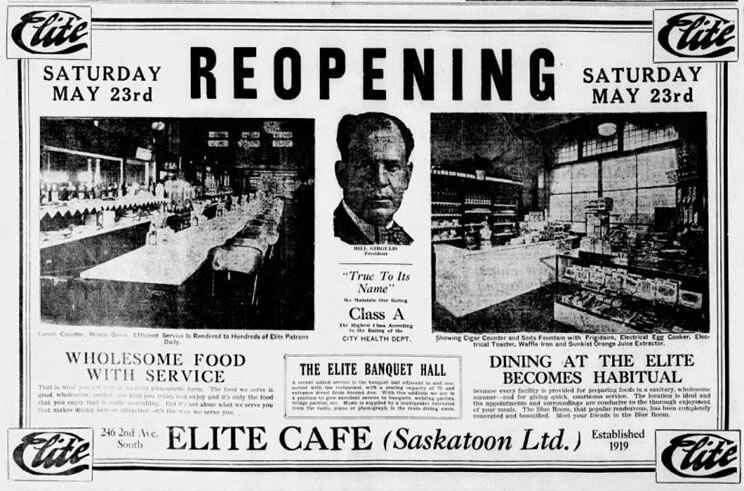
Saskatoon Star-Phoenix, May 22, 1931, p. 4.
The business prospered. It expanded to 9,425 square feet by 1935 and included two banquet rooms.
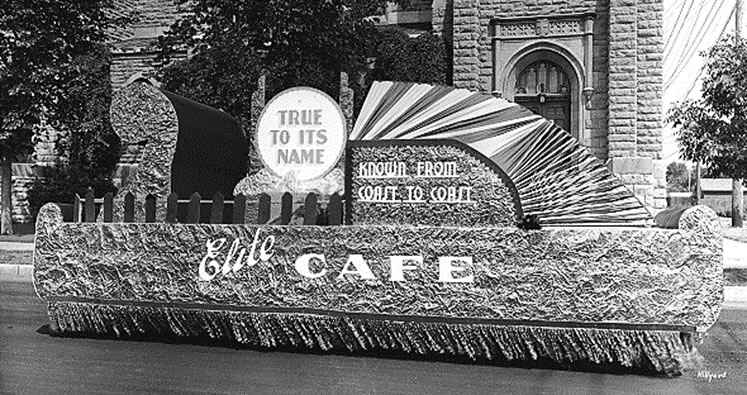
Elite Café parade float in the July 1938 Saskatoon Traveler’s Day Parade
Photo source: Saskatoon Public Library, Local History Room (A-427)
In December 1939, the Elite Café relocated to a newly constructed building at 224 Second Avenue South. The three Girgulis brothers leased the building from Dr. P. D. Stewart. (After the doctor died, the Girgulis brothers bought the property from the estate.) The building was air-conditioned and was able to filter and exchange air every ten minutes. The building was also one of the first in Saskatoon to install acoustic material to block sound between its rooms.
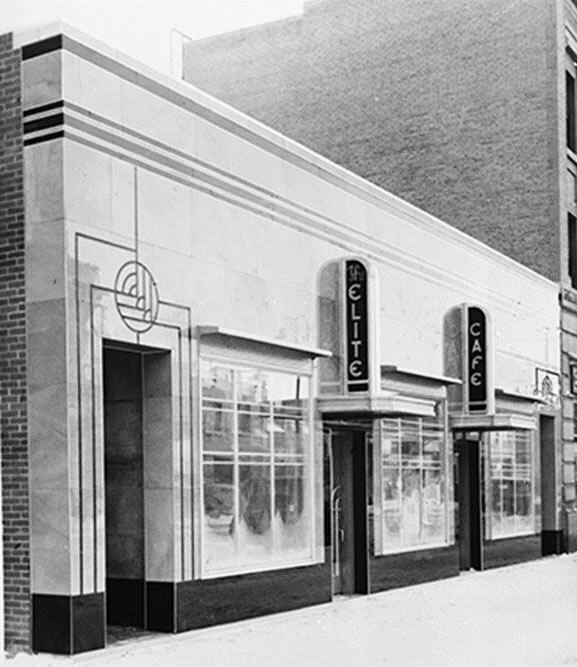
Elite Café (ca 1940), 224 Second Avenue South
Photo Source: Saskatoon Public Library, Local History Room (LH-6033)
The building was designed with the kitchen located centrally; separate serving exits led to the lunch room, dining room, and banquet room. A public lobby and cashiers’ desk was located between the separate entrances to the dining room (at the north end of the building) and the lunch counter (at the south end). The banquet room (“Blue Room”) extended across the entire back of the building; it could be accessed through the dining room or through a dedicated street entrance which led to the basement where coats could be checked and then to a red carpeted staircase to the main floor.
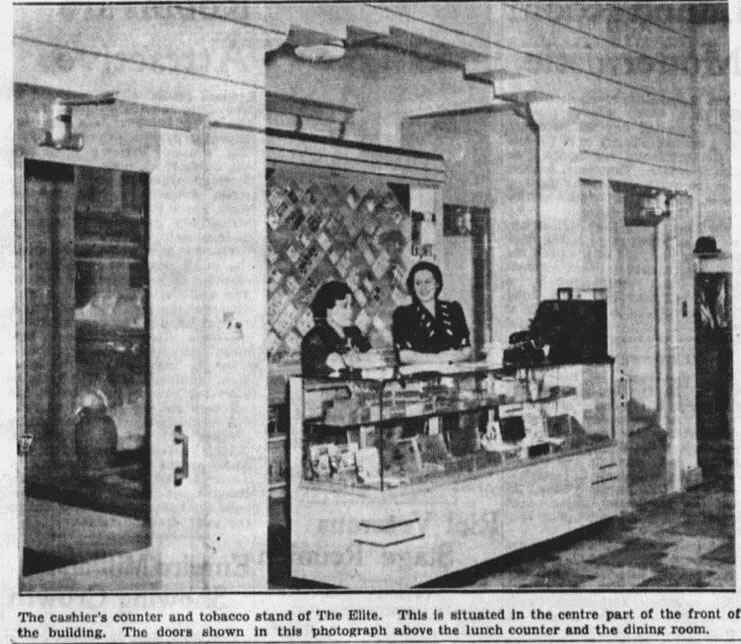
Saskatoon Star-Phoenix, January 13, 1939, p. 7.
The lunchroom had a seating capacity of 30 people. Red-topped Formica counters, mirrors and neon accent lighting, chrome chairs and light fixtures, and maple and walnut woodwork gave the room a contemporary look. The walls were painted in two shades of buff, separated by silver bands. The linoleum floor’s design was red, gray, black and white.
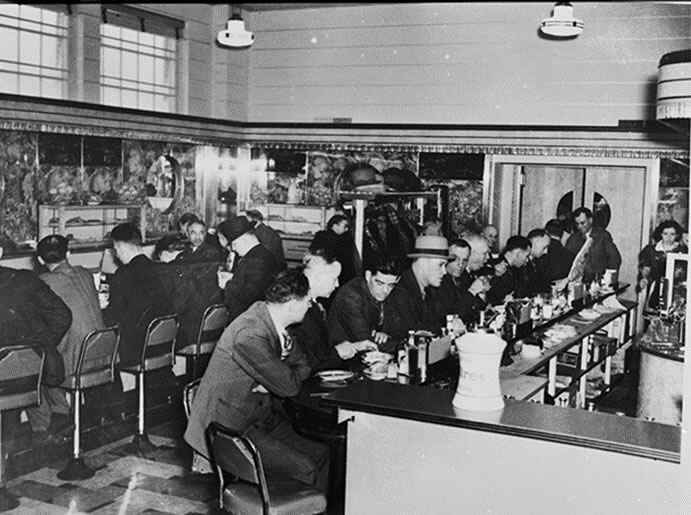
Lunchroom at the Elite Café
Saskatoon Public Library, Local History Room (LH-6034)
The dining room seated 104 people in booths accommodating two, four or six customers. The walls were painted in four shades of cream and buff. The partitions between the booths were made of maple and trimmed with walnut. Each table had a mirror, wall lamp, and “service buzzer” to call the serving staff. The seats were upholstered in red leather and the tables were topped with red and black sliver patterned Formica. The floor was the same as the lunchroom, but rugs were added to enhance the ambiance of the room.
The dining room featured prime rib of beef. White tablecloths covered the tables and the service included silver cutlery and finger bowls.
The Blue Room was decorated with layered wall panels in four shades of blue, separated by silver bands. The ceiling consisted of a cream-coloured acoustic board. Six windows, with Venetian blinds, were set high on the east wall. The floor was polished maple and ideal for dancing. The Elite became one of the first restaurants in Saskatoon to offer a dine-and-dance package. Instead of a live band or orchestra, recorded music was offered by a Wurlitzer.
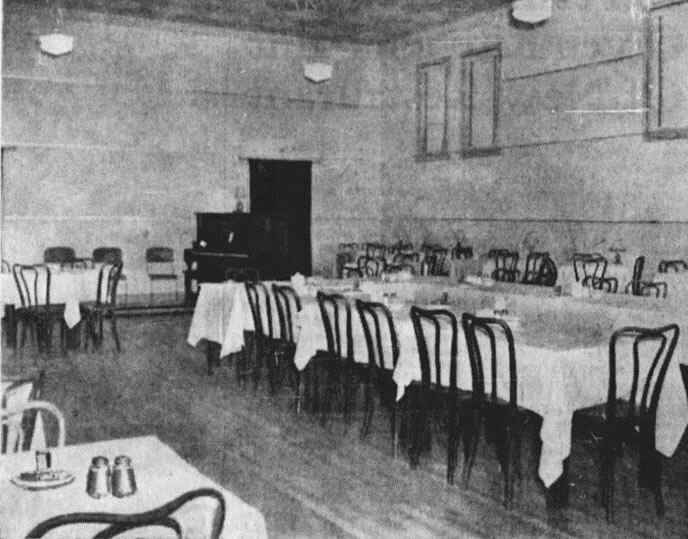
The Blue Room at the Elite Café
Saskatoon Star-Phoenix, January 13, 1939, p. 8.
The basement contained the building’s mechanical equipment and storage rooms, as well as an in-house laundry and employees’ dressing rooms and shower facilities.
With the outbreak of World War II, the Girgulis brothers incorporated patriotic themes in their newspaper advertisements. The Canadian Army’s recruitment center was in the basement of the Elite Café.
Labor shortages compelled the Elite to reduce its hours of business. In February 1942, the 24-hour operation was forced to close between 2:00 a.m. and 6:00 a.m. Then, in November of that year, the Elite agreed with other restaurants in Saskatoon to close one day a week.
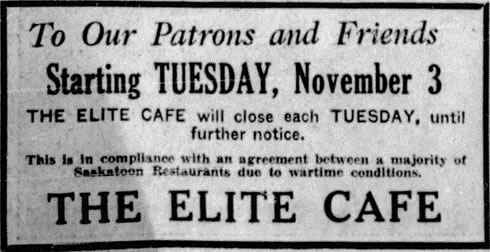
Saskatoon Star-Phoenix, November 2, 1942, p. 8.
In the 1950s the Elite Cafe was renovated in several stages. The lunchroom/coffee shop was the first to be redecorated. The dining room and the Blue Room were subsequently redecorated, A cocktail bar was added in response to changing liquor laws. By 1960, the exterior of the building facing Second Avenue was dramatically altered.
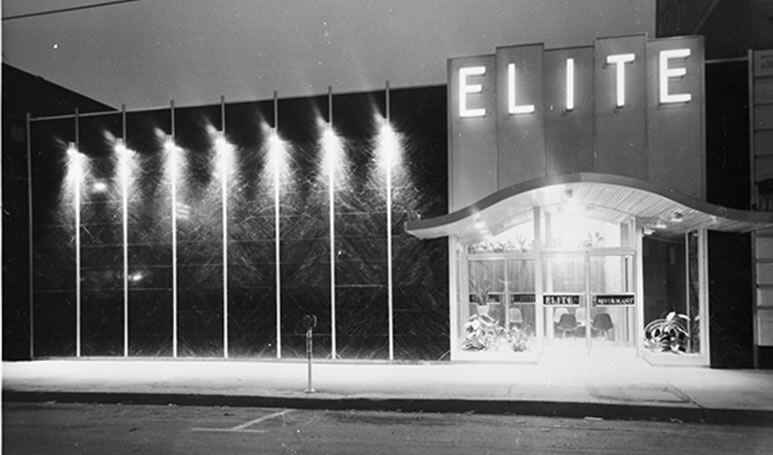
Elite Café (1960), 224 Second Avenue South
Photo Source: Saskatoon Public Library, Local History Room (LH-6075)
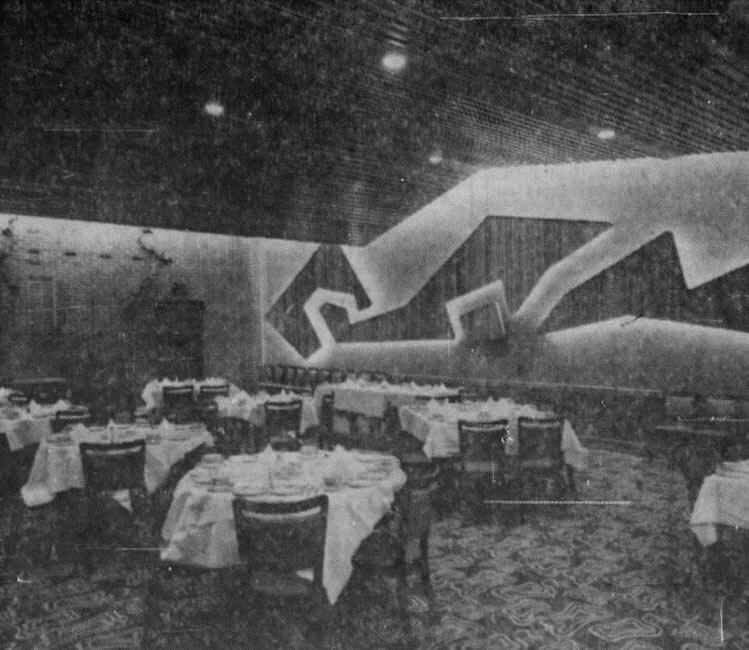
The Blue Room at the Elite Café
Saskatoon Star-Pheonix, January 25, 1957, p. 5.
The Girgulis brothers decided in 1971 to retire and therefore, close the Elite as a business, although they continued to own the property. The building subsequently was operated as nightclubs and restaurants, first by Y & D Yip Investment Ltd. and later by the Chicago Cattle Company. The latter closed its business, Outlaws Restaurant, due to financial difficulties in August 1982. Shortly afterward, a fire in the vacant restaurant severely damaged the building, as well as several adjacent properties. An employee of Outlaws Restaurant was subsequently charged and convicted of setting the fire.
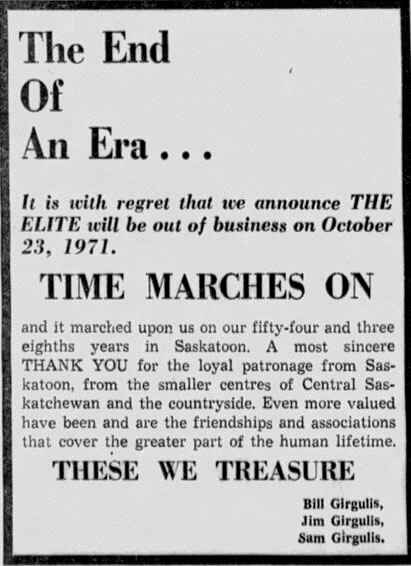
Saskatoon Star-Phoenix, October 20, 1971, p. 2.
The fire-damaged building was demolished in 1983. A cornerstone, containing mementos from the days when the building was constructed, was found and opened. The mementos included a newspaper a menu and engraved silverware from the Elite Café.
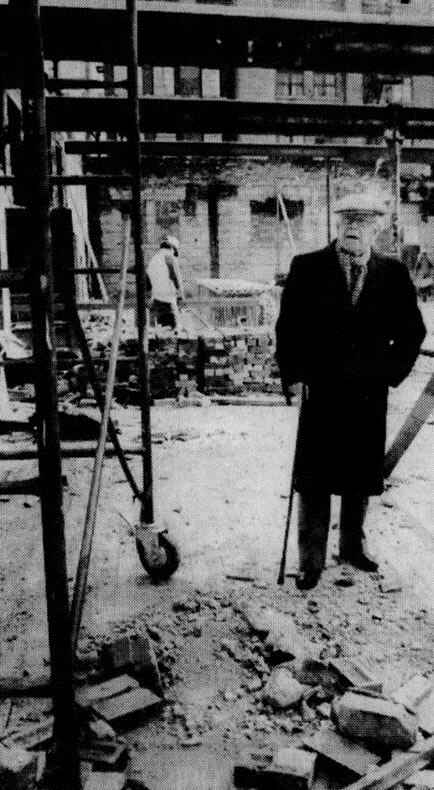
William Girgulis visits the site of the Elite Café as the building is being demolished.
Saskatoon Star-Phoenix, October 22, 1983, p. 41.
Researched by Ken Pontikes, April 10, 2024.
Sources: Saskatoon Phoenix/Star-Phoenix, June 23, 1917, p. 3; July 9, 1920, p. 4; April 20, 1931; May 22, 1931, p. 3; January 13, 1939, p. 6; March 21, 1942, p. 3; October 27, 1971, p. 27; August 4, 1982, p. 3; October 22, 1983, and February 14, 1984, p. 3.
A Tribute to the Elite Cafe
If you ask a discerning man what the important things in his life are, he’ll tell you good food is high on his list.
If you want to know good food, a chef or cook or café man will tell you; and since James Harry Girgulis is all these in one, we asked him. Not only did he tell us, but he had this writer to a dinner of crab fish and cocktail sauce. It was more effective than words.
In recent days, we’ve been hob-knobbing with the Brothers Girgulis, James, Bill, and Sammy, because on Thursday, August 15, they observe 40 years of service in the restaurant trade in this city. So, it seemed timely to us to learn a little of the story of the Elite Café, the house of fine food that these brothers built.
This cafe story marks the Girgulis family in Saskatoon and their relatives in Regina, Nick Kangles and his sons Harry and Jimmy, and Albert Lallas as among the foremost in Saskatchewan’s restaurant business. They’ve built a dynasty in the kingdom of good, or perhaps more accurately, better eating.
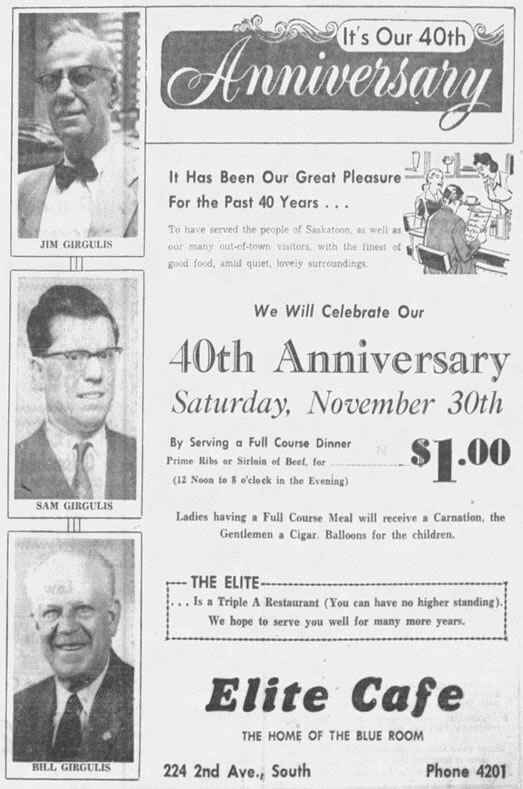
Saskatoon Star-Phoenix, November 28, 1957, p. 6.
Even though the Girgulis men have given years in service and in quality food to thousands, they appreciate the support Saskatoon and district have given them. To show their thankfulness, Jimmy Girgulis said:
“In the fall, sometime in September, we’re going to observe our fortieth anniversary in a special way by serving special prime ribs of roast dinners at $1 a plate to Saskatoon families after they’re home from holidays, and back to work and school.” This gesture by Jimmy Girgulis, the founder of the Elite, typifies the sportsmanship of a man who is as well known in trap-shooting circles as he is in the cafe business. He won the Mid-west International in Winnipeg in 1933, and Manitoba-Saskatchewan singles and doubles in trapshooting several times. He hasn’t missed a hunting season in 45 years. Besides, he also plays a “friendly” game of golf.
His formula for good eating takes you by surprise for its keynote is simplicity and quality. Thus, the man whose cafe is the only one rated Triple A in the restaurant Red Book for northern Saskatchewan recommends old fashioned breakfasts of oatmeal, and ham or bacon and eggs, with toast and coffee.
Lunch or dinner: roast prime ribs of beef. For supper, Mr. Girgulis offers beefsteak or his favorite crab fish with cocktail sauce.
“I seldom eat desserts, but my favorites are rice-raisin pudding and ice cream. I don’t believe in too many sweet things. Variety in food is the best for a person because it keeps the system tuned up,” he advises.
The Elite is famous in the West for its delicious prime ribs of beef and it’s the dish that tops Mr. Girgulis’ list, with succulent steaks a close second.
Over the 40 years, Jimmy figures they’ve served 30,000,000 meals to several million people. But they’ve taken their bumps in that time, losing $20,000 in bad debts.
Bill and Jimmy started with a modest $5,000 in 1917 and, with their youngest brother, Sammy, developed their business until the Elite has an estimated worth today of $175,000. Sammy has been associated with his brothers for almost his lifetime – for more than 30 years. Their policy of continuous remodeling gave the Blue Room a new lift four years ago. Three years earlier the counter was rebuilt.
Jimmy, who observed his 62nd birthday June 22, is a spare, active man, weighing 150 pounds. He’s five feet eight inches tall. “Look at me,” he says, “I keep in shape largely because of good eating habits.”
A native of Kastrion, 30 miles from Sparta, Jimmy left his homeland when he was 15, spent six months in Coney Island, New York, selling peanuts, popcorn, and candy for “a distant uncle.” His brother Bill had gone to Texas a year earlier, then moved up to Regina where Jimmy joined him.
“When I arrived at the old Grand Trunk station, I was wearing my straw hat, and the ground in Regina was covered with snow. Imagine that!” Jimmy exclaimed.
In Regina, he worked for his uncle Peter Girgulis at the Elite Cafe on Scarth Street, just south of the old post office. He said it was one of the finest restaurants in the West, a fact to which this writer can testify. The old mahogany fixtures now make up altar panels at Father Athol Murray’s college chapel at Notre Dame, Wilcox.
“My uncle had a headwaiter, Spero Miller, a Greek. He taught me an awful lot and when he left. there, I took over his place as head waiter,” Jimmy recalled.
He left his uncle and in August 1917 started at the old Savoy Cafe here, on Twenty-first Street, near the old post office and next to the Bijou theatre. His partners were Tom Varvas and William Scherounis. Then in 1919, he and his brother Bill bought the Elite Cafe, with Bill as manager. Jimmy sold his interest in the Savoy in 1922, joined Bill in operating the Elite where the Gem Cafe is now, and moved in 1929 to their present location. Jimmy said there was just a shack at the present Elite site, owned by Dr. P. D. Stewart. “He built a place for us, and we rented from him until his death, then bought this building from his estate,” Jimmy said.
In common with the majority of Saskatonians. Jimmy takes pride in the University of Saskatchewan which he thinks is the finest on the continent. His daughter, Christine, who is presently on the continent and visiting Greece as well, is a Saskatchewan Arts graduate of ’52, a Toronto University graduate of ‘54, and a member of this city’s library staff. His son, Billy, graduate in Law of ’55 here, is practicing in Edmonton; and his son Harry, graduate in Engineering of ’57 here is a mechanical engineer with Ford Company of Canada in Windsor.
Jimmy explains his great interest in the cafe business and sports is because he enjoys meeting people. “And always lots of people came in to see who I was when I was trapshooting,” he said.
In the long years, Jimmy has observed a great improvement in the quality of food and has experienced soaring prices, especially for greens imported from California. Besides, he imports from Montreal special grade olive oil and spices not attainable locally.
The late Sid Johns, longtime manager of the Saskatoon Exhibition board, is credited by Jimmy with being responsible for the big improvement in beef quality back in the 1930s. Mr. Johns, he said, got calf clubs started, and as a result, there was a noticeable betterment in the quality of beef.
“The farmers are the biggest trade we’ve got here. At first, we had to train people to use the cafes back in the early 1920s,” he reminisced.
“We train our cooks to our specifications, and we insist on quality. It is the cheapest in the long run in the restaurant business,” according to Jimmy. Jimmy said he thinks wines with meals are necessary, especially for the traveling public, and cocktail bars properly managed would make for greatly improved observance of the liquor laws. “They’re breaking the law now anyway,” he said.
Jimmy gives a big assist to his wife, the former Mary Ballek, for his success. This happy team has seen the Elite move to the top rank in the cafe business. They’ve served such notables as the Duke of Windsor when he was Prince of Wales in 1919, Premier T. C. Douglas, Lieutenant Gov. W. J. Patterson, Rt. Hon. Jimmy Gardiner, and of course, Canada’s new Prime Minister, John Diefenbaker.
Mr. Girgulis, a keen student of the cafe business, says, “I keep up to date. I hope I live another 10 years to have a good golden anniversary.”
Saskatoon hopes so too.
Source: Pat O’Dwyer, “On the Town”, Saskatoon Star-Phoenix, August 14, 1957, p. 12.
Granada House Restaurant
Granada House Family Restaurant and Lounge (904 – 22nd Street West)
Owners/Operators: Nikitas Kokonas, Alex Liakopoulos, Bill Kondos, and George Kondos (1980 – 1993); Nikitas Kokonas, Alex Liakopoulos, George Kondos, and Evangelia Kondos ( 1993 – 1994); Alex Liakopoulos, George Kondos, and Evangelia Kondos (1994 – 1997); Alex and Shirley Liakopoulos (1997 – 2021)
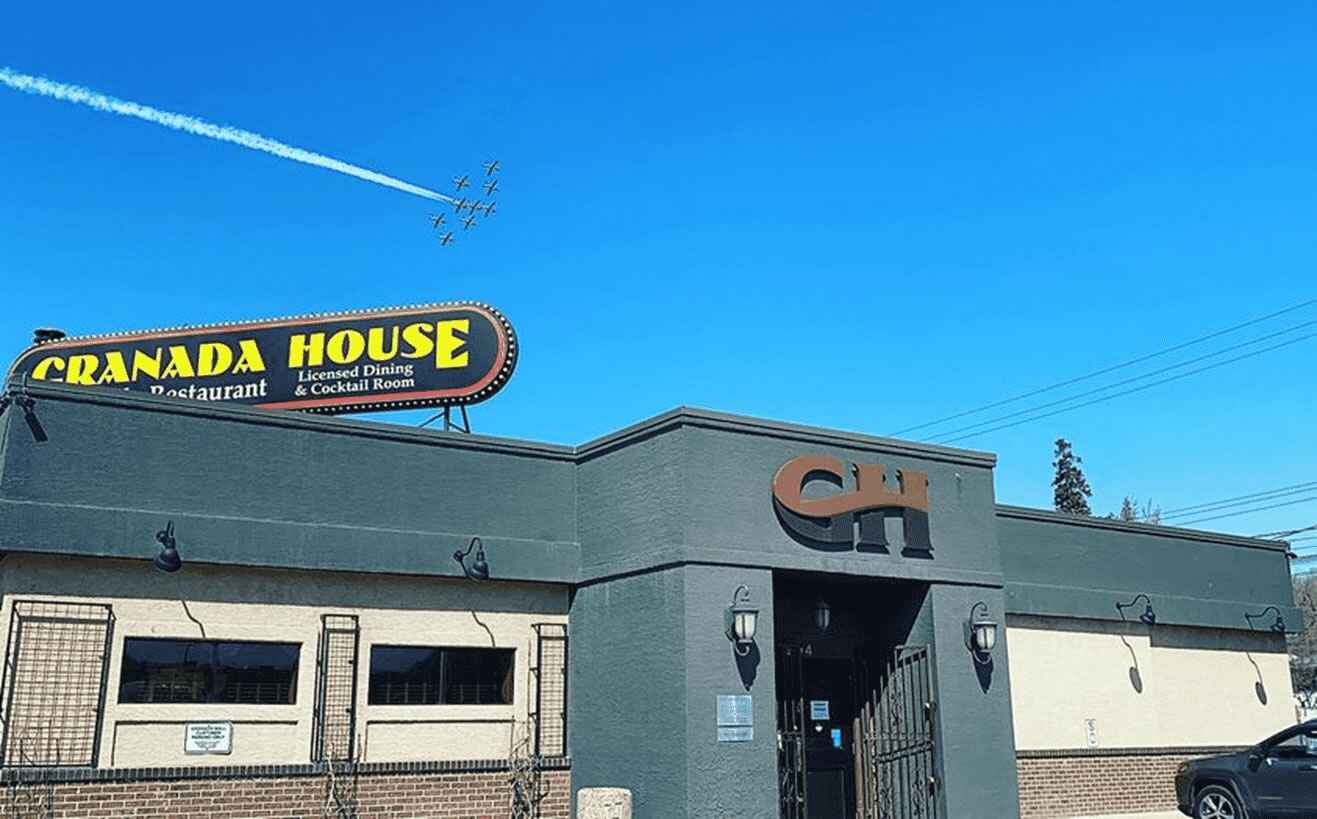 Source: Granda House Restaurant and Lounge, Facebook, May 14, 2020.
Source: Granda House Restaurant and Lounge, Facebook, May 14, 2020.
In 1980, Nikitas (Nick) Kokonas and Alex Liakopoulos sold their interest in the Commodore Café and entered into partnership with Bill Kondos and George Kondos in the Granada House Restaurant.
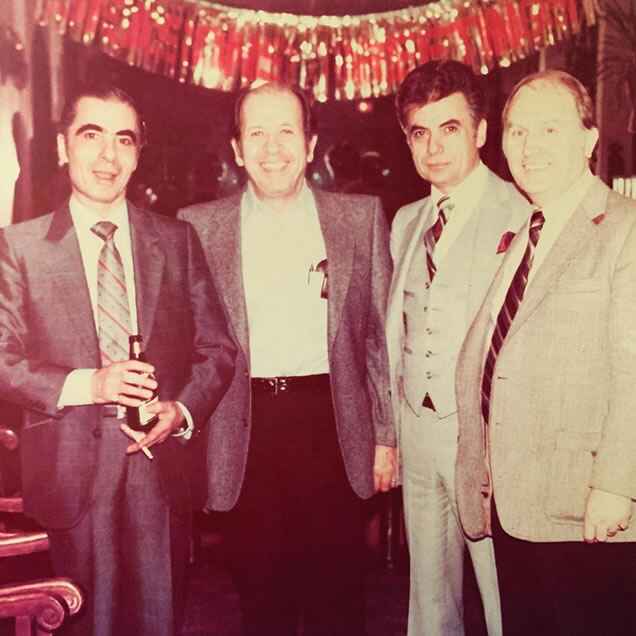
Granada House Restaurant and Lounge – Original Owners (not dated)
Left to Right: George Kondos, Nikitas Kokonas, Bill Kondos, and Alex Liakopoulos
Source: Granada House Restaurant and Lounge
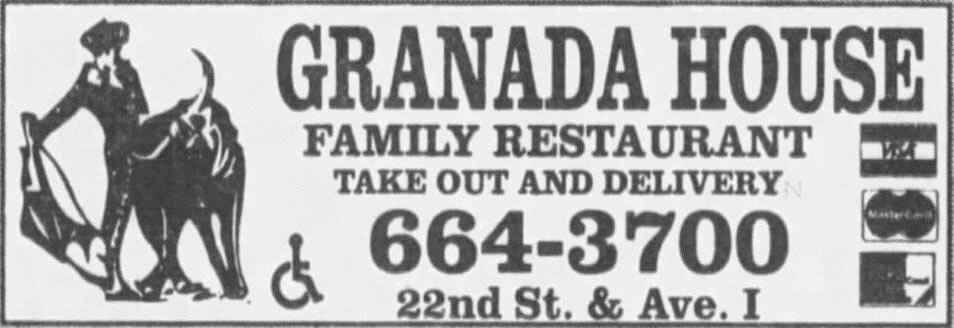
Source: Saskatoon Star-Phoenix, April 2, 1993, p. 51
When Bill Kondos passed away in 1993, his wife, Evangela Kondos, took over his partnership. Nikita Kokonas retired in 1994. George Kondos and Evangela Kondos retired in 1997.
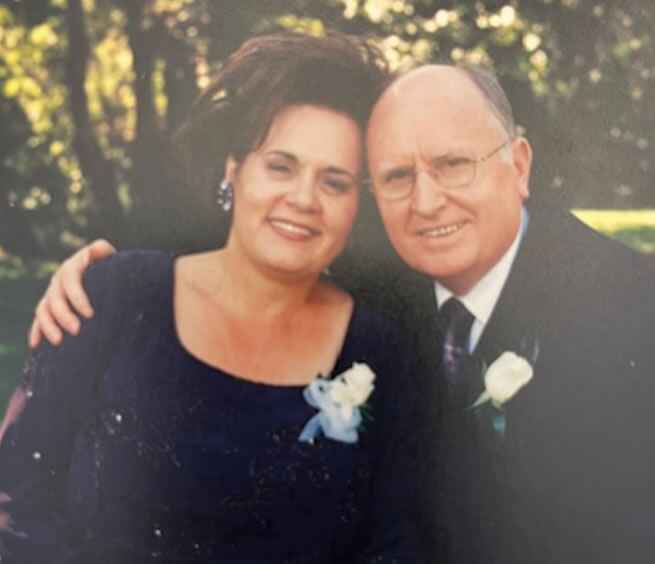
Alex and Shirley Liakopoulos
Source: Tony Antonopoulos
When the business celebrated its 20th anniversary in 2020, the Granada House was owned and managed by Alex and Shirley Liakopoulos. In a newspaper article about the 20th anniversary, Alex said:
“Granada has survived for so long because of the quality of the food and the service we provide to people. We always have and always will treat customers as if they are our friends and family. We certainly appreciate the support we receive from all our customers, not only the ones from Saskatoon, but the man outside the city who visit us on a regular basis.”
At that time, the restaurant could seat 167 customers and the lounge could accommodate up to 50 people.

A “wall of fame” in the Granada House contained photographs of personalities who had visited the restaurant, including singers Celine Dion, Leona Boyd, Nana Mouskouri, and Marie Osmond and hockey player Eddie Shack. However, the photo that gained the greatest attention was the Liakopoulos family’s tribute to Saskatonian George Adilman, a well-known and colourful personality who lived in the city from 1928 until he died in 2000.
Check out Granada House’s great menu…
Johnny's Lunch
Johnny’s Lunch
351 Second Avenue South
Owners/Operators: John P. Pontikes and Peter K. Pontikes (1953 – 1956)
(Source: Pontikes Family Video – Screen Shot)
In 1953, cousins John P. Pontikes and Peter K. Pontikes purchased the Log Cabin Inn, a 23-stool lunch counter located at 351 Second Avenue South in Saskatoon. Isaac Brown and James Forsyth had owned the business. The business’s name was changed to Johnny’s Lunch.
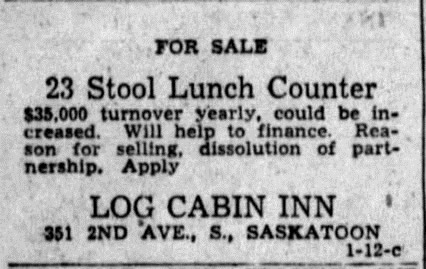
Source: Saskatoon Star-Phoenix, January 10, 1953, p. 21.
Johnny’s Lunch occupied a portion of the main floor of a two-story building owned by local auto dealer, Automobile Clearing House Ltd. The lease provided access, by an interior staircase, to washroom facilities on the second floor.
Several family members recently arrived from Greece, and worked at Johnny’s Lunch. They included Kiki Pontikes (John’s sister) and John Pappas (uncle to Peter’s wife).
On July 8, 1956, an early Sunday-morning fire extensively damaged the building’s roof and interior stairs. By the time firefighters arrived, flames were visible on the roof and thick black smoke engulfed the immediate area. To prevent the fire from spreading (particularly to a nearby auto paint shop), fire hoses were inserted into holes chopped into each side of the roof. Johnny’s Lunch, below on the main floor, suffered smoke and water damage.
Peter and John were forced to close Johnny’s Lunch from July 8 to July 15. On July 16, they managed to reopen their business “in a limited manner”. However, City inspectors declared the building as “hazardous” and ordered the owner (Automobile Clearing House) to repair the roof or take “some similar action”. In August, the owner informed Peter and John that instead of repairing the roof, the building would be demolished, and their lease would be terminated. Johnny’s Lunch continued operating until September 30, after which the demolition was scheduled to proceed. Peter and John sought a court injunction to give them time to obtain a court order to force the owner to maintain the lease by repairing, rather than demolishing, the building. With the demolition on hold, a judge heard the injunction application on October 29, 1956, and decided the next day, to tear it down. The lease was terminated, and the building was demolished.
Researched by Ken Pontikes, October 4, 2023
Sources: Saskatoon Star-Phoenix, July 9, 1956, p. 2 and October 29, 1956, p. 3; Henderson’s Greater Saskatoon Directory, 1953 (Winnipeg: Henderson Directories Limited, 1953), p. 417.
Paragon Cafe
Paragon Café
157 Second Avenue South
Owners/Operators: Thomas Kortes and Joseph Weimer (1934 – 1935); Achilles, Gust, and Thomas Kortes (1035 – 1949); Gust and Thomas Kortes (1949 – 1952)
Paragon Café, located north of Golf’s Chocolate Shop and Café and next door to the OK Economy grocery store (1951)
Source: Saskatoon Public Library, Local History Room (B-4239)
In March of 1934, the New Patricia Café (located in the Kempthorne Block at 157 Second Avenue South) was sold by the Barootes family to Thomas Kortes and Joseph Weimer. At the time of the sale, Thomas was employed at the Commodore Cafe, which was owned by his brother-in-law, Steve Leakos.
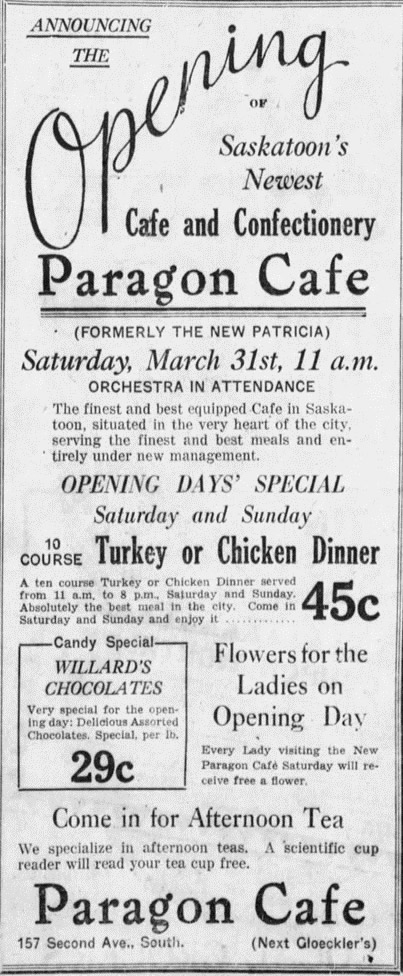
Saskatoon Star-Phoenix, March 29, 1934, p. 9.
The new owners operated the business as a cafe and confectionery under the name, “Paragon Café”. Within a year of aquiring the business, Joseph left the partnership. Thomas now owned the Paragon Cafe with other members of the Kortes family – his brothers Achilles (“Brown”) and Gust. This 3-member partnership continued until 1949 when Achilles died. Later, in 1952, Thomas died.
During the years of operation, the Paragon Cafe provided a full restaurant menu. In the late 1930s, it offered a 65-cent full-course dinner, “featuring turkey, chicken, roast meats, etc.” The Cafe also promoted its candy, nuts, and fruit which were sold in gift baskets. Chocolates were sold, but were produced by national candy manufacturers, including Ganong, Moirs, and Willards. Cut flowers were also available for sale.
By 1940, the Cafe had an afternoon tea to attract women customers. Tea cup readings were available in the afternoon and later in the evening at no extra charge.
Saskatoon Star-Phoenix, December 8, 1939, p. 9.
In 1944, the Cafe was forced to reduce its operating hours. Breakfast was no longer offered, with the Cafe opening at 11:00 a.m., becuase of an inability to hire sufficient staff . In 1945, the Cafe closed temporarily in August to accommodate annual vacation entitlements for all employees at the same time. The another similar temporary closure occurred, with the time taken to “redocrate [the] premises” (Saskatoon Star-Phoenix, July 31, 1946, p. 7. Throughout the year, the cafe operated six days a week, initially closing on Tuesdays and later in 1947, on Wednesdays (Saskatoon Star-Phoenix, April 28, 1947, p. 13).
By early 1953, the Paragon had closed due to financial challenges and its physical assets were sold. The OK Economy grocery store, which had been located adjacent to the Paragon Cafe, expanded into the Cafe’s space on the ground floor of the Kempthorne Block.
Researched by Ken Pontikes (July 25, 2024).
Paris Cafe
Paris Café/New Paris Café and Paris Hotel
252 Second Avenue South
Owners/Operators:
- 1920 – 1924: Thomas L. Michas
- 1924 – 1932: Thomas Marines and Sam Sinis
- 1932 – 1935: Thomas Marines
- 1935 – 1940: Thomas Manos and Thomas D. Smith
- 1940 – 1944: Thomas Manos
- 1944 – 1947: Paul Kortes, Arthur Kranias, and Chris Saks
In 1920, the Michas family purchased the Gordon & Sparling Block, in which the Café was located and renamed the building as the Paris Café Block. When it opened, the Café operated 24 hours a day. The upper floors were renovated to serve as residences.
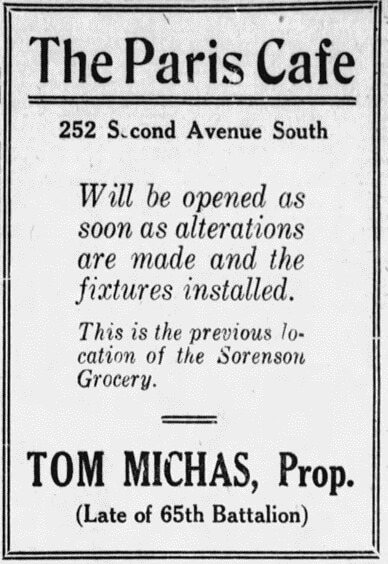
Source: Saskatoon Phoenix, January 3, 1920, p. 12

Source: Saskatoon Daily Star, February 10, 1920, p. 15.
Paris Café, 1920
Source: Saskatoon Public Library, Local History Room (PH-89-203-1)
About 1924, Mr. Michas sold his interests in the Paris Café to Sam Sinis (his nephew) and to Thomas Marines; both men previously worked at this Café before purchasing it. Mr. Michas moved to Florida.
Sam and Thomas renovated the café in 1930. The Star-Phoenix described the café’s new décor in the following quotation from the June 7, 1930 edition:
“The pleasing front of the café has been made even mor attractive with new artistic signs, the woodwork has been done in bronze effect and the tiles have added to the appearance. Within the restaurant a new color scheme has been caried out both along the big lunch counter with its gleaming and spotless bar, and the dining room, divided into booths.
The woodwork is done in a soft yellow effect with tasteful green trimming while the panels are in a mauve effect. Costly new curtains have appeared, these blending with the color scheme. The bar behind the lunch counter, with its freight of dainties and gleaming glasswork, reflected in the large mirrors, has been colored in black and yellow. The mirrors are set between pillars of imitation marble with guilt scroll work.
New equipment has also made its appearance. The attractive new soda fountain, in black and white with a white marble serving counter, is the latest thing of its kind, with the most sanitary and convenient appliances invented. Back of the dining booths is the ladies’ washroom and lavatory. Passing through to spacious and orderly kitchen one goes beyond to the big Frigidaire room, where all the fresh meats and fish and vegetables are kept fresh and sweet even in the hottest weather.”
Paris Café, Street View, 1929
Source: Saskatoon Public Library, Local History Room (PH-2016-200)
Sam and Thomas renovated the café in 1930. The Star-Phoenix described the café’s new décor in the following quotation from the June 7, 1930 edition:
“The pleasing front of the café has been made even mor attractive with new artistic signs, the woodwork has been done in bronze effect and the tiles have added to the appearance. Within the restaurant a new color scheme has been caried out both along the big lunch counter with its gleaming and spotless bar, and the dining room, divided into booths.
The woodwork is done in a soft yellow effect with tasteful green trimming while the panels are in a mauve effect. Costly new curtains have appeared, these blending with the color scheme. The bar behind the lunch counter, with its freight of dainties and gleaming glasswork, reflected in the large mirrors, has been colored in black and yellow. The mirrors are set between pillars of imitation marble with guilt scroll work.
New equipment has also made its appearance. The attractive new soda fountain, in black and white with a white marble serving counter, is the latest thing of its kind, with the most sanitary and convenient appliances invented. Back of the dining booths is the ladies’ washroom and lavatory. Passing through to spacious and orderly kitchen one goes beyond to the big Frigidaire room, where all the fresh meats and fish and vegetables are kept fresh and sweet even in the hottest weather.”
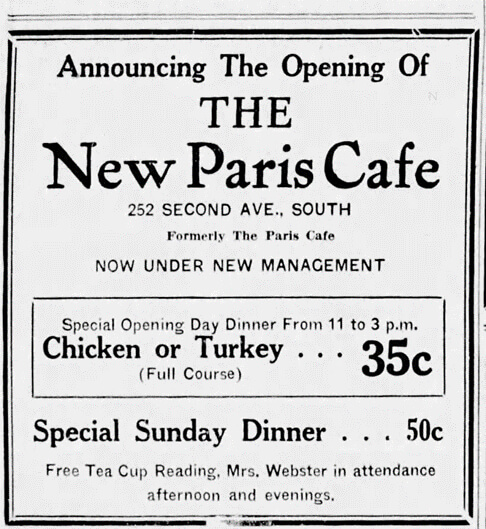 Source: Saskatoon Star-Phoenix, June 24, 1932, p. 16.
Source: Saskatoon Star-Phoenix, June 24, 1932, p. 16.
In 1932, Mr. Marines became the sole owner of the renamed, New Paris Café. He continued his ownership interest in the Paris Cafe until 1935 when he moved and entered the restaurant industry in Quebec City. By that time, the owners had converted their ownership of the building (“Paris Block”) into the Paris Cafe and Paris Hotel. The hotel and cafe were purchased by Thomas Manos and Thomas D. Smith. Before coming to Saskatoon, Mr. Smith was the owner and operator of a business in Moose Jaw which was also named, the Paris Café and Paris Hotel.
THE NEW PARIS CAFE
Reopens Tomorrow at 11 a.m.
UNDER NEW MANAGEMENT
TOM. D. SMITH, Manager; TOM MANOS, Assistant Manager
EVERYTHING about the New Paris Cafe is–as our name
correctly designates it entirely NEW. You’ll be amazed at the changes we have accomplished seating, new counters, new booths entirely new layout, new equipment installed everything that could make a restaurant that is home-like, and convenient. And most important of all, here’s where the food you get and the company you find are equally desirable.
The new management, with a lifetime of experience in catering to the food requirements of a discriminating public, 24 years of it spent in Regina, Moose Jaw, and Saskatoon, have particularly selected their staff with a service eye. We firmly believe that if you had a chef at home, you couldn’t get better cooking or service than that which awaits you at the New Paris Cafe.
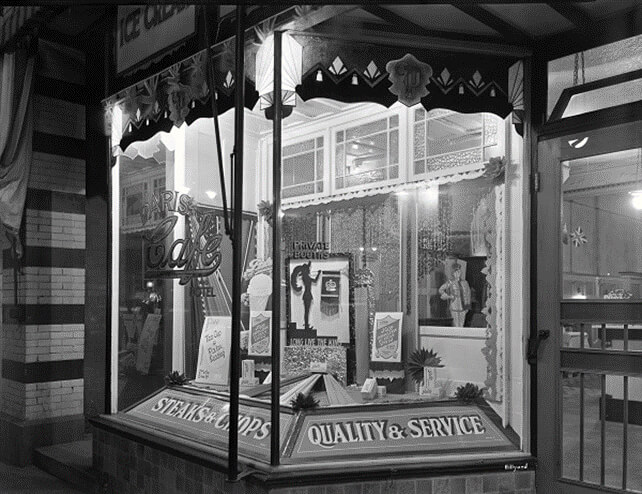
Paris Café, Front Window Display, 1937
Source: Saskatoon Public Library, Local History Room (A-1022)
By 1940, Mr. Manos became the sole owner of the building and the cafe-hotel business. Paul Kortes, Arthur Kranias, and Chris Saks purchased the Paris Cafe in the mid-1940s. They continued to operate the businesses until 1947 when they sold them to “non-Greek” operators.
Researched by Ken Pontikes, July 31, 2023
Sources: Saskatoon Pheonix and Star-Phoenix: various issues; Saskatoon Daily Star: various issues.
Patricia Cafe
Patricia Confectionery and Tea Room (“The Patricia”) (1914 – 1926)
New Patricia Café (1926 – 1933)
265 Second Avenue South and 157 Second Avenue South
Owners/Operators: Barootes (Efthemios) Family: Vasilis (Basil), Nicholas, Christos, and Theopani (Stephen)
Vassili Barootes arrived in Canada from Triglia in Asia Minor in 1903 at the age of seventeen. In Toronto, he learned to make candies and chocolates. Shortly afterward, he and his brothers – Christos, Theopani, Nicholas, Vassili’s wife, Anastisia moved to Winnipeg where they operated the Alberta Café on the corner of Portage and Garry.
Source: Winnipeg Tribune, October 19, 1907, p. 10
In 1914, the Barootes family opened the Patricia Confectionary and Tea Rooms (also known as “The Patricia”) in Saskatoon. Located at 265 Second Avenue South, the business sold home-made candies, chocolates, and luncheon items. Members of the Barootes family moved to Saskatoon to operate their business interests in this city.
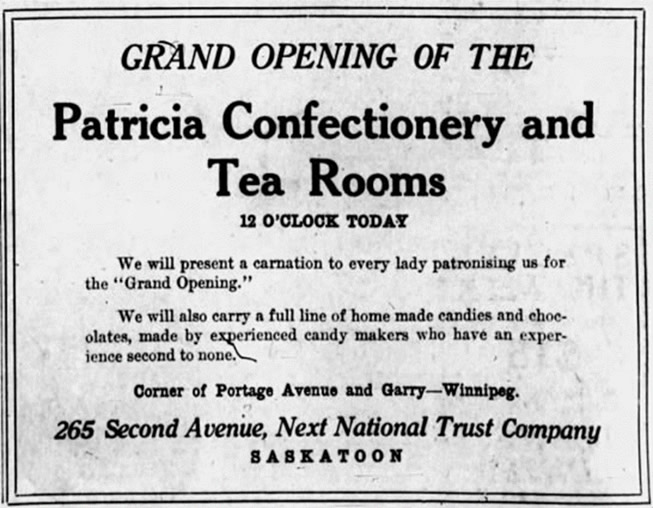 Source: Saskatoon Daily Star, November 16, 1914, p 12.
Source: Saskatoon Daily Star, November 16, 1914, p 12.
Source: Saskatoon Daily Star, December 20, 1915, p. 8.
By 1918, the business expanded to include a candy counter, a soda fountain, and ice cream parlour, as well as a candy factory in the rear of the building.
Source: Saskatoon Daily Star, February 28, 1918, p. 14.
Patricia Café, 1921
Source: Saskatoon’s Greek Community – The Pioneers, 1901 – 1949
Renovations in 1926 reconfigured the business into a restaurant, now known as the New Patricia Café, which continued to sell chocolates and other candies.
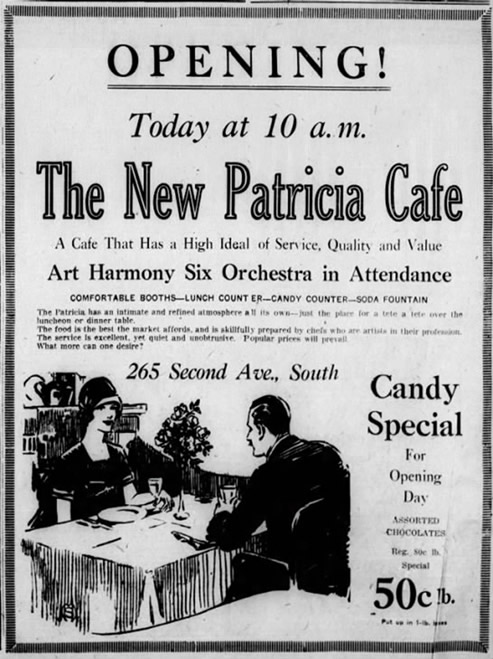 Source: Saskatoon Star-Phoenix, March 22, 1926, p. 10
Source: Saskatoon Star-Phoenix, March 22, 1926, p. 10
New Patricia Café (1928)
Source: Saskatoon Public Library, Local History Room (LH-6284)
In 1933, the New Patricia Café relocated to 157 Second Avenue South. The space at 265 Second Avenue South was occupied by the National Lunch (a business that was not operated by a Greek family) and by the Saskatoon Co-operative Association Limited.
The New Patricia Café was sold in 1934 to the Kortes family who operated the business until 1942 under the name, “Paragon Café”.
Researched by Ken Pontikes (October 31, 2023).
Princess Cafe
Princess Cafe
109 Twentieth Street West
Owners/Operators: Nicholas J. Pappas and Andrew Peters (1926 – 1931)
The Princess Café was purchased by Nick Pappas and Andy Peters in November 1926 from Fred Quong, Alex Quong, and Quong Lung Gam. Andy was a well-known local Greek chef and performed this role at the Princess Café. Renovations of the café were completed in March of 1928.
Saskatoon Star-Phoenix, March 3, 1928, p. 24
Saskatoon Star-Phoenix, June 28, 1928, p. 15.
Nick and Andy operated the café until 1931. At that time, the café was closed and the space was offered for rent.
Researched by Ken Pontikes, January 11, 2024.
Saskatoon Station Place
Saskatoon Station Place
221 Idlywyld Drive North
Owners/Operators (1985 – 2019): Chris, Dave, John, and Stavros Arvanitis
Source: Saskatoon Star-Phoenix, November 12, 1994, p. 45
The Brothers Arvanitis started immigrant life in Canada by washing dishes. Sometimes John, Dave, Chris, and Stavros — owners of arguably the most distinctive restaurant in town — still wash dishes.
“Success is paying attention to detail. If a job has to be done, don’t quarrel about who should be doing it, do it,” says Dave Arvanitis, 49, one of the four brothers who originated the Saskatoon Station Place restaurant. Bankers will tell you that almost every budding entrepreneur in town thinks first of opening a restaurant. They’ll also tell you the worst people to loan money to are chefs and maitre d’s with a great idea for a new eatery. Eight out of 10 restaurants open and close almost before the appetizer and soup are served.
“You have to know this business from the ground up,” says John Arvanitis, 58, the first brother to cross the sea from Greece to Canada, “and you have to know every single phase of it. There are hundreds of restaurants in Saskatoon. If you’re not prepared to offer something absolutely different, why would guests leave one restaurant for your restaurant?”
The Saskatoon Station Place is different. Just last month a visitor walked into it and asked when the next tour was. She actually thought it was a real 1880s train and train station combined. That’s exactly the touch the Arvanitis brothers wanted for their restaurant, and it’s why they employed a Toronto antique dealer to scour the world looking for railroad artifacts and memorabilia from the turn of the century.
The Arvanitis Brothers spent six years planning their restaurant, another year pondering architectural designs, and one-year watching construction come together before their five-room, 300-guest eatery on Idylwyld Drive and 23rd Street became a reality. That, plus a proven track record, was enough to convince the bank.
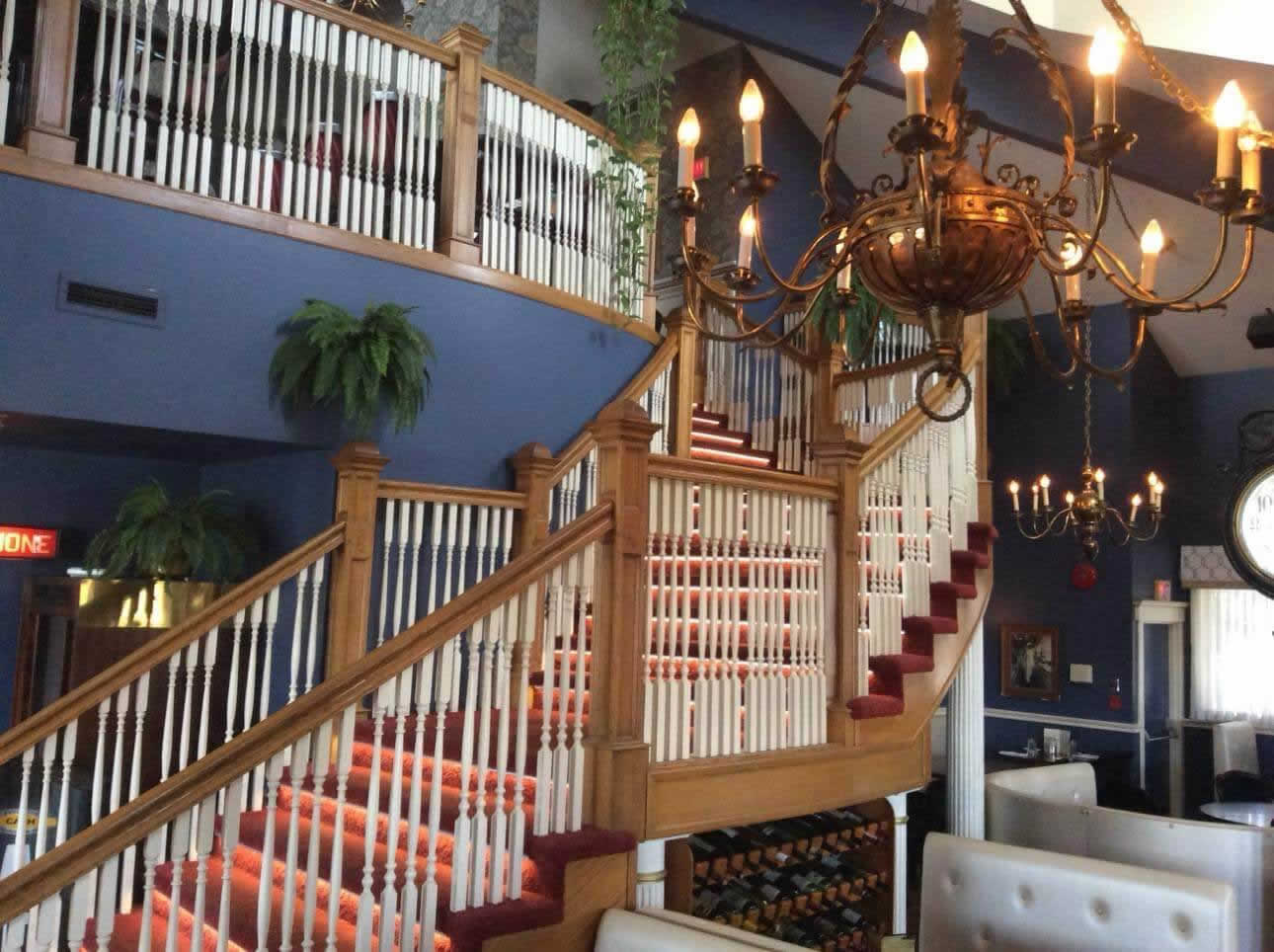
“The reason most people fail in business is that they don’t really know what they’re getting into, and they haven’t planned it,” says Dave. “You have to find a need or develop one.”
The four brothers came over from Greece one at a time between 1958 and 1964. Unable to speak English, they all started off washing dishes, graduated to becoming waiters, and then chefs, and learned everything they could about restaurants.
In 1968, with a few thousand dollars saved, they bought the old Shasta coffee shop on Second Avenue. They spruced it up, and within a few months, it was paying their way. In 1972, they bought the building and changed the Shasta into the A-Four supper club, A-Four standing for Arvanitis Four. Like the Shasta, it was a success from day one. Although after embarking on The Station Place project they closed the A-Four, they and a partner just last month reopened it.
“We put everything we had into it,” says Dave, “and took nothing out. “Too many people think profit, profit, profit. The customer doesn’t think of profits, they think of the best possible deal at the best possible price. You can charge someone $15 for an entree, and then add $5 for an appetizer, $4 for salad, and $3 for a soup, but are they ever going to come back again? Even if they can afford that once a year, they’ll remember it when the economy tightens. I’d rather give them an appetizer, salad, and soup for free, and make sure they remember it.”
The brothers say they realized if they ever wanted to establish a landmark restaurant in Saskatoon it would have to be something really different.
“We’d heard of restaurants on boats, and restaurants designed like boats, and even a restaurant shaped like an airplane. We knew that was the way to go. Initially, we intended to build our restaurant on Eighth Street, but when the land adjacent to the old CPR station became vacant the choice was obvious, ” explains Starvos, 43.
“There were certainly some advantages aside from the obvious. From operating the A-Four, we knew that parking space could make or break a restaurant. It’s points like parking that, if overlooked, can doom your business. In this location, we have parking for almost 200 cars. Let’s face it, whoever heard of a train station without lots of parking?”
Even so, there were worries before opening. Costs mushroomed as elegance increased. The club car and the dining car were built on real locomotive platforms, with no margin for error in design or construction. Railroad artifacts had to be fascinating, but not overbearing. The huge wooden carved bar finally needed a special crew of men flown in from Toronto to erect.
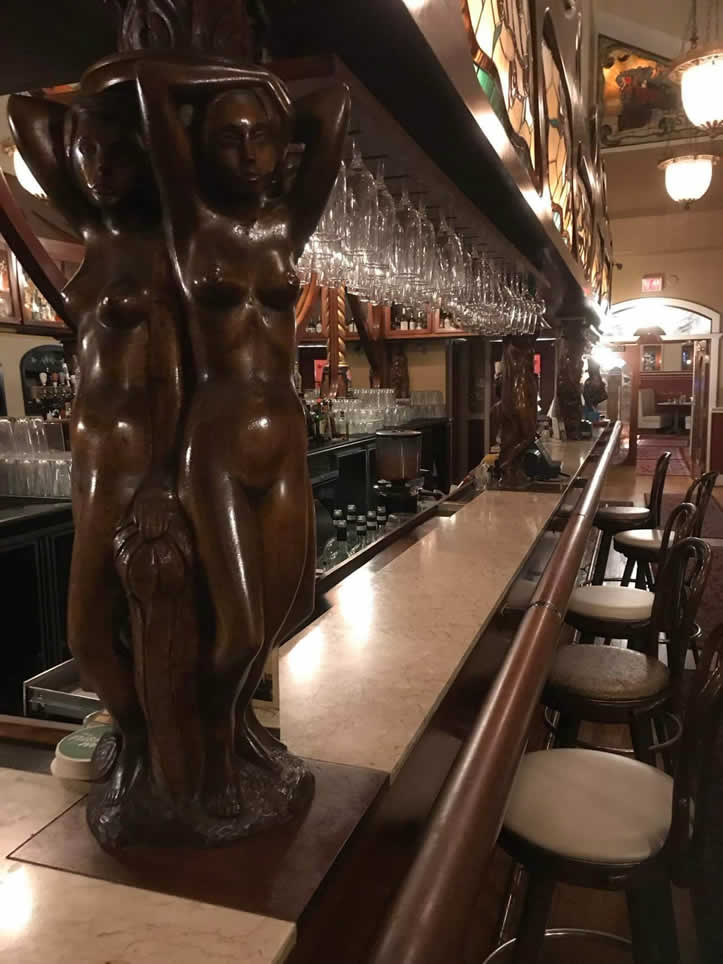
“When you have 80 to 100 employees you have other worries. You feel responsible for their well-being. Some have given up other jobs to join you, some have families to support. You realize if you make a mistake, they suffer.”
“We had to price items for everyone’s pocket. If you want to spend $50 or more for a night out, fine. But if you’ve only got $10 or $20, that’s fine too. We’d rather be full, than empty.”
As it happened, no one suffered.
“The day we opened up in 1983, we were full. We couldn’t believe it. People were lined up just like passengers for a train,” says Stavros.
The brothers’ insistence that success is learning the business from the ground up has been instilled in a second generation. George, the 24-year-old son of John. is now a bartender, but for years he earned his allowance washing dishes at 50 cents an hour.
“I never had it easy, but what successful people do?” says the younger Arvanitis, philosophically.
Saskatoon Star-Phoenix, September 3, 1988, p. 77.
Dave, Stavros, Chris, and John opened their popular dining spot on Idylwyld Drive back in 1964. The planning and building took a huge investment in cash and time, but it was a labor of love for the four transplanted Greek restaurateurs. Their unique architectural achievement has become an integral part of Saskatoon’s culinary landscape.
Painstakingly recreated Pullman carriages anchor the restaurant’s design, and the theme of turn-of-the-century passenger rail transportation flows throughout the 300-seat dining spot The combined visual effects of expensive antiques, authentic first-class CN furnishings, stained glass leaded windows and the solid walnut and oak inlaid tables contribute to the anticipation of a wonderful dining experience.
The Station’s passengers are not to be disappointed thanks to the Arvanitis kitchen, which possesses all the skills needed to serve consistently quality cuisine. That’s good. I figure that, if the elegant surroundings uplift the mood of diners, it only serves to prepare them for the real reason that they came.
Specializing in prime rib, steaks, gourmet chicken dinners, seafood, Greek ribs, and souvlaki meals, Saskatoon Station Place holds its biggest surprise for first-time visitors by having reasonable prices. Despite the expensive decor and artwork, a glance at the menu prices shows why the restaurant attracts a wide audience. Dishes like Filet of Sole ($10.99)- lightly breaded and sauteed in lemon- butter and sprinkled with baked almonds, and Barbecued Spareribs ($13.90) – a slab of tender ribs, broiled with the Station’s special sauce. Like most other entrees, soup, salad, veggie, and your choice of potato or rice are included.
There’s also a selection of pasta dishes including Fettuccine Alfredo ($9.99) -served with garlic toast, and Lasage ($8.49)-with meat sauce and garlic toast.
Famous for the prime rib, which is so tender you really can cut it with a fork, the Station offers a couple of different sizes ($14.90 and $18.99) -again all-inclusive of salad, soup, etc. Steaks are also a popular item, such as the 8 or New York ($13.99) 10 oz. Filet Mignon ($18.99) or the whopping 16 oz T-bone ($16.99)-all are selected from aged cuts of beef and served with sauteed mushrooms.
The gourmet chicken dishes on the menu include Chicken Breast Swiss ($14.99) – a boneless breast of chicken, topped with bacon and melted Swiss cheese and served with mushroom sauce; and my particular favorite, Chicken and Spinach ($14.99) – a boneless breast of chicken, stuffed with spinach, feta cheese, and fresh herbs and splashed with the house specialty lemon-sauce.
If you’re out for a night on the town or you have a big appetite, you might want to check out the list of combo meals offered here under the appropriate title. Couplings. There’s Chicken and Ribs ($17.99), Chicken and Shrimp Scampi ($17.99) Filet Mignon and Lobster Tail ($27.99), and Greek Ribs and Shrimp Scampi ($17.90)
For those with lighter things on their mind, salads abound, including Greek ($7.49), Caesar ($6.99), Shrimp salad ($8.99), and Warm Chicken Salad ($8.99) – broiled chicken breast slices on top of Caesar salad.
As you might expect, you’ll find a variety of souvlaki to choose from, such as Pork ($11.99), chicken ($12.99), or lamb ($13.99) all marinated in special sauces these dishes come with two Souvlakis, soup, salad veggie and a choice of potato. Besides regular menu listings, every evening has a variety of different specials to attract your attention. There’s an inexpensive lunch menu served until 3.30 pm, featuring homemade hamburgers and fries, from $5.45 to $6.45, omelettes, croissants, soups, salads, and sandwiches. The extensive Sunday brunch has also proved a popular addition to the Saskatoon Station Place’s dining activities.
A good wine list, with more than 50 labels, adds to the dining enjoyment.
With more than 30 successful years in the Saskatoon restaurant business, these brothers know just how to turn on the appetites of their customers. John Arvanitis holds the main responsibility for the kitchen production, but Dave is no slouch when it comes to food preparation. When he’s not out mixing with customers, you’ll find this partner mixing his bread dough. His bread rolls are baked fresh daily and are a classy complement to any good meal.
Carrying a huge tray of hot out of the oven bread rolls, Dave, his suit jacket temporarily removed and replaced with a white baker’s smock holds out the still steaming rolls for inspection.
“Try one, tell me if it’s like the bread you had when you visited Greece,” the amiable Dave enquires.
Layering on butter, which melts on contact with the hot bread. I chew off a chunk from the bun. I tell him that the taste takes me back to the wonders of romantic, historical Athens. Dave is pleased.
Stavros pours wine, a fine Boutari red. The two brothers clink their glasses with mine and toast to my health. My glass is refilled and another toast, this time to the friends and customers that have filled the restaurant over the years.
More bread, some delicious appetizers, and quickly the warmth of that Mediterranean feeling washes over the soul as the two brothers talk of food and wine with obvious passion, a passion shared by their customers.
“We have so many loyal customers that visit us, customers that have become friends,” says Stavros. “We spend so much time in this place it’s home for us, and home is where you serve your very best to your guests, “he says. Judging by the long-term success of their restaurant, I’d say the Arvanitis brothers have developed many lasting friendships.
Saskatoon Star-Phoenix, January 26, 1996, p. 52.
Editor’s Note: The Saskatoon Station Place closed in June 2019. The following year, the Old Spaghetti Factory opened in the building and continued to display many of the antiques that had been collected for the former businesses by the Arvanitis family.
Stavros Arvanitis, co-owner of the Saskatoon Station Place, sits in his historic Station Place restaurant.
The Saskatoon Station Place has been a landmark in a prime location on Idylwyld Drive since the 1980s. Ahead of its permanent closure on June 27, the StarPhoenix spoke with co-owner Stavros Arvanitis about some of the staple items on the menu over the years – so make sure to try them all while there is time, writes Alexa Lawlor.
- The Pullman’s Platter comes with 3 appetizers: spanakopita, or a spinach pie; youvarlakia, fresh ground beef, rice, and spic- es topped with a lemon sauce; and dolmathakia, vine leaves filled with rice, ground meat, and topped with a lemon sauce, alongside three entrees: shrimp scampi, Greek ribs, and a boneless breaded chicken breast. It’s topped off with a choice of soup or salad as well.
- Arvanitis says the steaks are also a classic menu staple at the Station Place. From filet mignon. to New York strip steaks and rib eyes, there’s an option for everyone.
- Prime Rib – The secret to the Station Place’s prime rib, according to Arvanitis, is in the slow roasting process. He says leaving the prime rib overnight is key to making it great. The Station Place offers a prime rib sandwich on the lunch menu, which is a 6 oz. cut, or a 10 or 12 oz. cut on the dinner menu.
- Greek Ribs – Prepared with lemon and garlic butter, Arvanitis says the Greek ribs are yet another classic staple on the Station Place menu.
- The Station Place offers a buffet brunch on Sundays from 10 a.m. to 2 p.m. Guests can choose from a variety of appetizers, hot dishes, meat carvings, and various choices of fruits and desserts. “When they give you a comment but don’t come back it’s an issue, but for the brunch, they give a comment and they come back – that means you’ve done a good job,” Arvanitis said. Even now, with the closure, Arvanitis says they’ve been getting overwhelming support, with people coming into the restaurant to give hugs, kisses, and to share memories.
Sasaktoon Star-Phoenix, June 2, 2019, p. A3.
The Dining Car.
2nd Floor View
The Wine Cellar
Suburban Restaurant
Suburban Restaurant
Avenue A (Idylwyld Drive) North, Highway 11 North
Owners/Operators: Peter Bezbes, James Kosmas, Peter Pontikes (1959 – 1973)
Suburban Restaurant, 1964
Source: Saskatoon Public Library, Local History Room (QC-2843-2)
In 1957, a partnership of Peter G. Bezbes, James Kosmas, and Peter Pontikes leased the space in the Barry Hotel on Twentieth Street East and Avenue B South which had previously served as the Hotel’s food service under the name, Dinty Moore’s Eats. The new lessees continued to provide the Hotel’s food service which now became known as the Barry Café.
At about the same time as they opened the Barry Café, the three partners purchased approximately 20 acres of land north of Saskatoon on Avenue A (now known as Idylwyld Drive) and Highways 11 and 12. The properties were in the Rural Municipality of Cory (later to become the amalgamated Rural Municipality of Corman Park and subsequently to be annexed into the City of Saskatoon). They were located approximately three miles north of the Saskatoon airport; they were on the east side of the highways and were separated by a public road which led eastward towards the South Saskatchewan River (currently 71 Street).
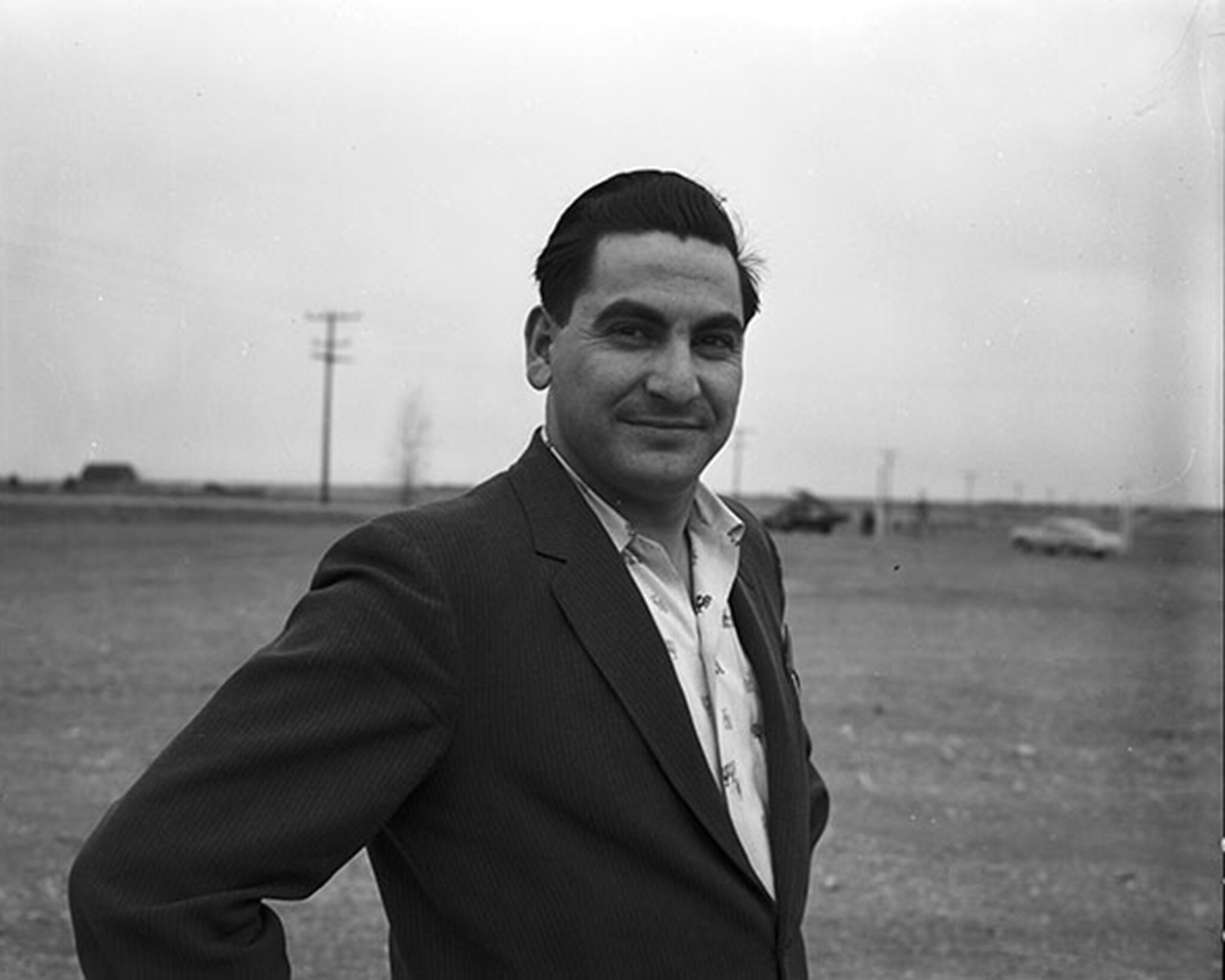
Peter G. Bezbes at the future site of the Suburban Restaurant
Source: Saskatoon Public Library, Local History (QC-613-4)
In the fall of 1957, the partners made an application to the Rural Municipality of Cory and to the Saskatoon/Cory Joint Planning Committee for subdivision approval of their properties for the construction of a restaurant and either an auto service station or motel. The project was estimated to cost $75,000 (Saskatoon Star-Phoenix, November 15, 1957, p. 13).
A year later, construction began on a $150,000 restaurant on the northwest corner of the property south of the current 71st Street. The facility consisted of two banquet rooms, divided by a moveable partition, which allowed the smaller room to serve as a dining room; as well, the building would include a coffee shop and drive-in service. The facility could accommodate banquets of up to 500 people (Saskatoon Star-Phoenix, October 28, 1958, p. 3).
In November 1958, a contest to name the restaurant was initiated through the Star-Phoenix. A $25 prize was offered for the selected name. During the partners’ deliberations, the selection was narrowed to two names – the Prairie Schooner and the Suburban Restaurant. The choices provided a contrast between a name which reflected Saskatchewan’s rural past and the another which was more contemporary and urban. Late on a Sunday evening before Christmas, the name chosen was the Suburban Restaurant.
 Saskatoon Star-Phoenix, November 15, 1958, p. 5.
Saskatoon Star-Phoenix, November 15, 1958, p. 5.
The restaurant was designed by Tinos Kortes. The general contractor was A. L. Adams Construction. There were several challenges in locating a restaurant in a rural environment.
The first challenge was the location of the restaurant. Most of the land around the restaurant was still being farmed. Its location on a busy highway to northern Saskatchewan and Alberta was an advantage. However, its customers living in Saskatoon had to have a personal vehicle and an intent specifically to go to the Suburban Restaurant for a meal. Therefore, the restaurant advertised constantly on radio and in the newspaper to remind people that the restaurant existed. For example, for many years, the Suburban Restaurant ran advertisements once every hour during the day — just before the weather report at 30-minutes after the hour — on CKOM radio. A popular auction facility opened across the highway which became a significant source of drop-in customers. Employees at industrial developments further east on 71st Street also served the restaurant’s lunch trade.
The second challenge was not being connected to treated Saskatoon water and not having access to an established sewage disposable system. Sewage was collected in a lagoon which was dug on the property. Underground streams under the restaurant that flowed eastward to the South Saskatchewan River allowed wells to be drilled; the water was regularly tested and provide water to serve the entire restaurant. The well-water, therefore, had a taste which distinguished it from the water City residents were used to. Unlike other restaurants and businesses beyond the City limits, the partners did not arrange for Saskatoon water to be trucked daily to the Suburban restaurant. As for sewage, large lagoons were constructed in the northwest portion of the property (“downstream” from the restaurant’s water source) to collect all sewage from the restaurant.
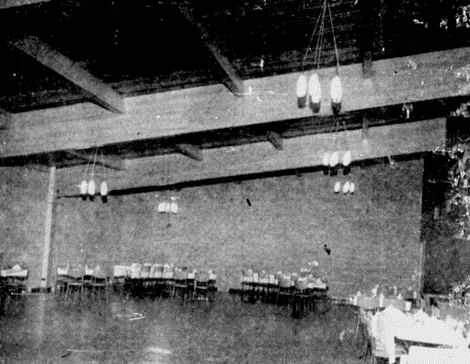
The large banquet room at the Suburban Restaurant (1959)
Saskatoon Star-Phoenix, May 1, 1959, p. 5.
Newspaper advertising for the new restaurant began in the late winter of 1959. The curb service opened first at the beginning of May.

Saskatoon Star-Phoenix, March 14, 1959, p. 4.
The entire restaurant opened on Mother’s Day weekend in May 1959. Reservations filled quickly and to capacity. All went well with the lunch customers who, following their meals, were offered tours of the restaurant, including the kitchen area. However, by the middle of the afternoon, the euphoria of the Mother’s Day opening took a disastrous turn. The kitchen staff reported that the large grill/range, ovens, and broiler stopped working. The propane tank that fueled them had gone dry. Despite being a new restaurant and having just opened, the tanks had inadvertently not been filled completely.
Frantic calls were made to local propane suppliers for more fuel, but no one was open or available to make an emergency delivery on that Sunday. This situation was a marketing and operational disaster for the new restaurant. All the restaurant was able to serve for Mother’s Day supper were salads, sandwiches, and dessert. Some calls were made to the people on the reservation list to inform them that they could not order a hot meal, but many were not reached before they arrived for supper. The owners and staff ended the day tired, frustrated, and worried about the bad first impression they had made. Attempts were made to repair the damage with the inconvenienced customers.

Saskatoon Star-Phoenix, May 14, 1959, p. 4.
The restaurant recovered from its opening day. It enjoyed a brisk business during subsequent Mother’s Days and other holidays. A weekly “supper club” with a live orchestra was well attended and was even broadcast weekly on CKOM Radio. The New Year’s Eve dinner and dance attracted many couples year after year. The banquet rooms were booked for many wedding receptions, trade shows, and other special events. From 1960 to 1962, the annual Kinsmen’s Celebrity Sports Dinner– featuring international and national sports celebrities — was held at the Suburban.
The restaurant was among the first, if not the first, in the province to allow the public to observe the kitchen staff at work. People in the coffee shop could look into the front portion of the kitchen through the glass pastry cabinets. As the restaurant’s banquet bookings increased, many customers enjoyed being in the coffee shop to watch the Suburban’s staff plating the meals in an assembly-line fashion.
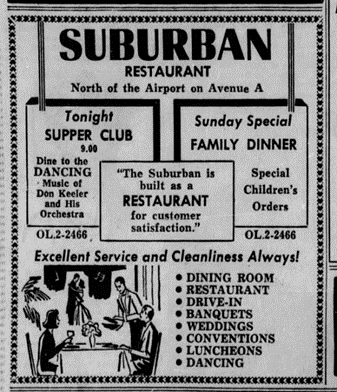
Saskatoon Star-Phoenix, March 19, 1960, p. 4.
In 1963, the Suburban Golf and Recreation Centre opened with a 24-stall, flood-lit golf driving range and two baseball-pitching machines. A nine-hole par 3 golf course with grass greens opened in 1964. The Recreation Centre was promoted both separately and in conjunction with the Suburban Restaurant. The Restaurant’s advertisements emphasized that it provided casual and family-friendly service after a game of golf in the coffee shop, as well as a more formal dining experience (particularly after it received its liquor license) in the dining room. The Restaurant’s motto for advertising became: “Come as you are. The Suburban Restaurant welcomes you.”
When it opened, Jim Kosmas assumed primary management of the Suburban Restaurant. The two Peters remained at the Barry and went to the Suburban to supplement the operations during holidays and when large events were booked into the dining and banquet rooms.
The Barry Café served as the meeting place for Suburban staff who didn’t have personal transportation. The restaurant owned a Volkswagen van which picked them up from the Barry and returned them at the end of their shifts.
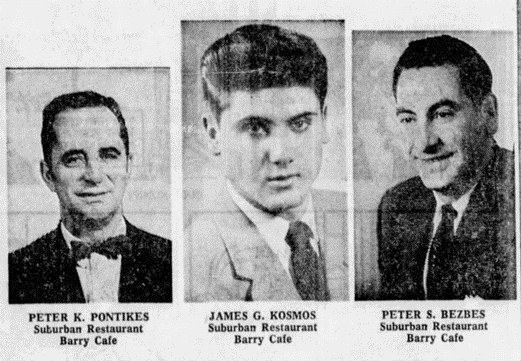
Saskatoon Star-Phoenix, December 31, 1966, p. 31.
The partners ended their lease for the Barry Café in 1968. With the acquisition of a liquor license, the small banquet room/dining room was redecorated in 1969 and renamed as the Normandy Room.
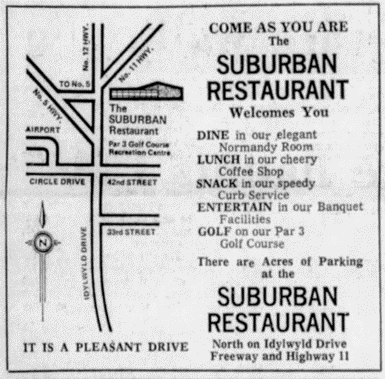
Saskatoon Star-Phoenix, May 16, 1970, p. 2.
All three partners were now working at the Suburban. This created interpersonal challenges for them. Not only did they have to re-establish how to work together, but also their business, financial, and family circumstances had changed. In addition to the Suburban, each had established partnerships in businesses and had invested in properties with other family members. The partnership became strained and near breaking apart when the Suburban in September 1973 caught fire and was burned to the ground.
The fire alarm was called into the Saskatoon Fire Department by a passing motorist at 3:30 a.m. on September 10. By 8:00 a.m., only one wall was still standing. Three units from the Fire Department were sent to fight the fire, which was difficult to extinguish because there were no nearby fire hydrants. A 1,000-foot hose was extended to the lagoons that served as water sources for maintaining the greens on the golf course. (Saskatoon Star-Phoenix, September 10, 1973, p. 3 and September 11, 1973, p. 15).
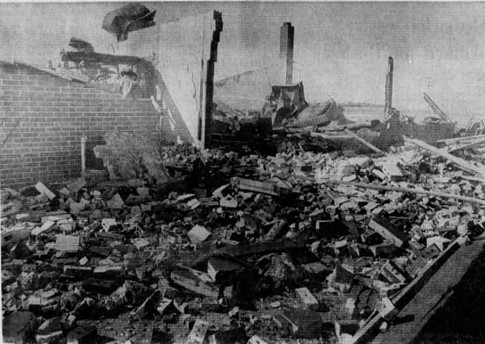
One wall standing among the rubble after the fire at the Suburban Restaurant
Saskatoon Star-Phoenix, September 10, 1973, p. 3.
Following the fire, Peter Pontikes went into retirement and the other two partners established new businesses – James Kosmas joined with his brothers to open the Cave Restaurant on Eighth Street East and Peter G. Bezbes opened the Boston House Restaurant (later Bezbes Family Restaurant) on Second Avenue South.
The recreation centre continued to operate, through various managers who leased the property and equipment from the Pontikes-Kosmas-Bezbes partners. The property was eventually sold and the partnership dissolved in 2005.
Researched and written by Ken Pontikes, August 7, 2024.
Sources: Saskatoon Public Library, Local History; Saskatoon Star-Phoenix, various editions.
Personal Memories: Ken Peter Pontikes, Saskatoon
In 1959, my dad with his partners (James Kosmas and Peter Bezbes) took a huge gamble and built a restaurant (consisting of a coffee shop, formal dining room, banquet room, and curb service) on land located outside of Saskatoon’s city limits and north of the airport. It was far enough from the city to rely on on-site wells for its supply of water and in sewage lagoons in a remoter corner of the property. (Later, the surrounding property was developed into a “recreation centre” including a Par 3 golf course.) The business, known as the Suburban Restaurant, was in addition to an existing successful operation, the Barry Café, which was in the Riversdale business district.
Don Keeler Orchestra (1959)
Left to Right: Harold Smith (sax), Charlie Gentle (trumpet), Doug Stock (sax), George Russell (sax), Don Keeler (drums), John Diduck (bass), Harry Smith (piano)
Saskatoon Public Library, Local History Room (PH-91-48-13)
Every Saturday night, the Suburban operated a dine-and-dance “supper club”. Don Keeler’s orchestra provided the live music and CKOM Radio broadcast a half hour of the “live” music (recorded for broadcast the following week) from the Suburban. The restaurant was not licensed for liquor (which is another story) and customers occasionally brought in hipflasks to spike their soft drinks – fortunately, the police never raided the event.
The Barry Café was closed on Saturday nights and all owners and staff were at the Suburban for the supper club. Tickets were sold in advance and my mother would serve as the hostess who greeted the customers and escorted them to their pre-assigned tables in the banquet room.
My sister (Diane) and I remained at home on Saturday nights, most often without a sitter. (In 1961, we were aged 12 and 7.) We would get lots of “check-in” calls to see how we were and if we could stay awake until after 1:00 a.m., early morning snacks would be brought home for us to eat. As a special treat, my parents occasionally would stop at the Golden Dragon Restaurant for take-out Chinese food.
Advertisement for 1961 New Year’s Eve at the Suburban; dancing could not legally begin until after midnight because New Year’s Eve was on a Sunday.
Saskatoon Star-Phoenix, December 30, 1961, p. 4.
New Year’s Eve was a special night for Diane and me. Since the last customers at the special supper club event (known as the “New Year’s Eve Frolic) didn’t leave until after 2:00 a.m., my parents brought us to the Suburban to participate in the festivities and observe how adults celebrated the new year. (Our assessment as children was there was too much hugging and kissing at midnight — particularly when it involved us!) Our job at the Suburban on New Year’s Eve was to operate the coat check. Often, the coats, particularly the fur coats, were very heavy and we would both carry them behind a wall to the back room where they would end up on the floor before being placed on hangers. We issued claim tickets for quick retrieval of the coats at the end of the event. The best part of the evening was that Diane and I were given the tips from a dish placed on the coat-check counter. We also joined in the staff dinner at the end of the event.
Diane and I operated the coat check for a few years and regular customers came to know us from one year to the next. They often commented on how we had grown over the previous twelve months.
Source: Ken Peter Pontikes, Facebook, December 30, 2023
Cousin Nik's
Cousin Nik’s
1110 Grosvenor Avenue
Owners/Operators: Nik Rizopoulos, Gus Dedaskalou, Jim Tassopoulos,
John Matiakis (1979 – 1988); Nik Rizopoulos, Jim Tassopoulos, John
Matiakis (1988 – 1999)
Cousin Nik’s Restaurant which opened in August 1979 took over space formerly occupied by the Embers. The new restaurant was a partnership of Nik Rizopoulos, Gus Dedaskalou (who died in 1988), Jim Tassopoulos, and John Matiakis. The bright and spacious restaurant was decorated with a natural Mediterranean theme, including courtyards, skylights, hand-woven Greek wall hangings, a fountain, and live plants and trees.
In addition to it’s regular menu, Cousin Nik’s became known for its multi-course gourmet dinner of appetizers, seafood, avgolemono soup, salad, two entrees, fresh fruit, pastries, and coƯee or tea. However, according to a July 9, 1994, article in the Saskatoon StarPhoenix:
“Cousin Nik’s may be best known for its delectable shrimp entrée. ‘Many customers have told us that no one can beat our shrimp’, says Jim Tassopoulos proudly. He and John Matiakis remember former Manitoba [Premier and Governor General Ed] Shreyer commenting that the shrimp dish was the finest he had ever eaten. And when the popular hypnotist Reveen is in Saskatoon, he comes to Cousin Nik’s for their succulent lamb.”
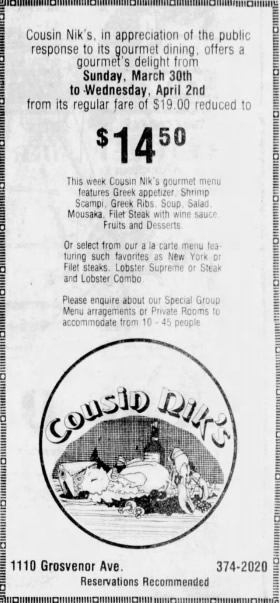
Source: Saskatoon Star-Phonix, March 31, 2980. P. 27.
The restaurant was open only in the evenings (not for lunch). It was a popular destination for celebrating special occasions. In addition to being a restaurant, Cousin Nik’s contained a dance floor and cocktail lounge, with live entertainment from Thursdays to Saturdays.
For many years, Cousin Nik’s was recognized as one of the top 500 restaurants in Canada by Anne Hardy’s “Where to Eat in Canada”. It had also been recommended by readers of EnRoute magazine as one of their favourite 100 restaurants.
For fifteen years, Cousin Nik’s hosted the Greek Gourmet Feast fund-raising events in support of the Royal University Hospital Foundation. When Cousin Nik’s closed in August 1999, the Barlas family took over the sponsorship and hosted the event at Mano’s Restaurant.
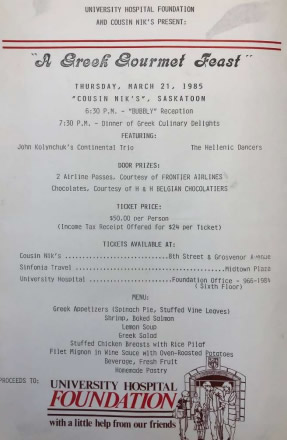
Source: Royal University Hospital Foundation
Following Cousin Nik’s closure, twenty years after it opened, the building was occupied by Primes Restaurant (operated by Peter Danabassis) and then by the Keg Restaurant.
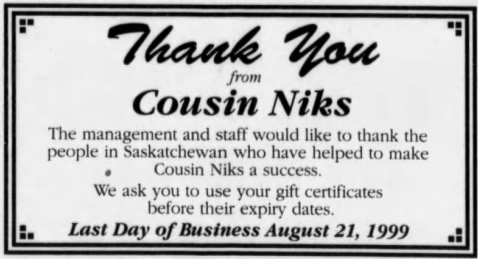
Source: Saskatoon Star-Phoenix, August 19, 1999, p. 2.
Researched by: Ken Pontikes, May 8, 2024.
Source: Saskatoon Star-Phoenix, February 5, 1981, p. 47; January 17, 1987, p. 81; July 9, 1994, p. 16; June 30, 1999, p. 36; and March 20, 2002, p. 31.
A Tribute to Cousin Nik’s
It’s been said sitting in Cousin Nik’s restaurant is like spending time in a Greek village square and feeling the heartbeat and soul of that nation. That’s an apt description, as we found out one night recently.
The transformation from the glare and razzamatazz of Eighth Street East to the warmth and charm of Cousin Nik’s just around the corner on Grosvenor Avenue is like a flight of fancy. Lush plants and real trees spring up everywhere. Red brick and tile present fascinating motifs, complemented by parch white walls. Colorful afghans blend in with wrought metal. Ornate lamps and statues, including an impressive lion with water flowing from its mouth, enhance a world-out-of-this-world atmosphere.
Owner John Matiakis’s menu is finely understated. It’s less crowded than menus in some other restaurants, and I think this is a major reason for its success. The restaurant prefers excellence to a far-to-weighty array of dishes. Superbly conceived, its meat and seafood offerings are unsurpassed in the city.
As we scanned the menu, gentle music soothed our way into the evening and my companion and I sipped on ouzo . . . , that most delightful of liquors, taken straight, without ice. It’s sacrilege to pour ouzo over ice. From the selection of starters, we chose the Greek appetizer plate . . . . It’s a sauce-drenched arrangement of large shrimp, dolmades, and spinach or cheese pie, depending on the chef’s mood that day. Whatever his inclination, it’s always a tasty, nippy, and delightful offering. The sauce is so good, don’t even bother trying to resist dipping the homemade bread in it. We were so enchanted by this dish, we ordered a second helping.
Entrees at Cousin Nik’s come with avgolemono soup, the delicious lemon and rice soup of Greece, a lavish and sparkling Greek salad and, for dessert, a rainbow array of pastries. It’s worth bearing all this in mind when you order; otherwise, you may find an overabundance of food on your table.
In my experiences at Cousin Nik’s, the soup has always been piping hot and slightly tart, and the salad fresh and nicely exotic. Accolades for both. When the time arrived for choosing our main dish, I finally picked the rack of lamb . . . , and my companion the charcoal-broiled chicken breasts . . . . We were tempted to go for two of the restaurant’s other much-acclaimed specialties, the ‘famous’ shrimp dish consisting of an ample supply of shrimp shimmering in buttered sauce with just a touch of garlic and flavoured with other spices . . . , or the pork spareribs . . . , piquantly favoured and like no other ribs obtainable in Saskatoon. We’d had these on a previous visit. But caught in indecision – Cousin Nik’s menu causes a lot of indecision – we threw caution to the winds and accepted the advice of our waiter, Tom Whittaker, who had been graciously patient during one hour of menu scanning and appetizer tasting. It’s good to see waiters exhibit both friendliness and respect.
For wine, we chose a bottle of Naoussa Boutari . . ., mainly to pay homage to the restaurant’s Greek-born owner. If it is a little too basic for many palates, the selection ranges in reds from Gallo Brothers burgundy . . . to Chateau Lafite Rothschild . . . . In whites, there’s a good German selection . . . , up to a French Chateau D’yguem . . . .
Our main courses arrived with great fanfare and flair. Richly garnished plates were as much a treat to the eye as the food proved to be to the tastebuds. Without having to choose, the vegetables included both rice and oven-baked potatoes. The rice was fascinating, amply flavoured with herbs and red pepper bits. Steamed vegetables on side plates are added to the bounty.
The lamb was slightly flavoured with aromatic spices and quite moist. With it came a choice of mint sauce or mint jelly. There should be no choice, for mint sauce with its tartness adds to lamb more than the sweeter jelly.
The chicken breasts, seasoned with herbs and spices, had an intriguing and seductive tang and a fine texture.
After consuming these lavish and rich delicacies, we faced a waitress offering us a plate of fresh fruits and a variety of pastries, including the ubiquitous and syrupy baklava and chocolate cake. We let ourselves be seduced by the offerings.
There are few restaurants one can recommend without reservation, but Cousin Nik’s is an exception Several visits over the past year have always proved enchanting and, as an added fillip, one can always wind up the night with an after-dinner drink in the cocktail lounge and a quick swirl on the dance floor. Worth noting is that on Sunday, Matiakis brings his old country culture to the restaurant with a traditional Greek dinner.
Source: Paul Jackson, “Evening at Cousin Nik’s like enchanting visit to Greece”, Saskatoon Star-Phoenix, September 22, 1987, p. 13.
Zenith Café
Zenith Café
132 Second Avenue North (1919 – 1924)
136 Second Avenue North (1924 – 1938)
Owners/Operators: Sam, John, and Nestor Serif
Before coming to Saskatoon, Samuel George Serif (born in Skopelos, Larissa, Greece) had established the Elite Café in Regina, the Maple Leaf Café in Moose Jaw, and several other cafes in other parts of Canada, including Vancouver. In 1917, he took out a long-term lease in the Kerr Block at 242 Second Avenue South in Saskatoon and commenced renovations to establish a new restaurant, known as the Elite Café. In 1919, this café was sold to the Savoy Café Co. Ltd.
Sam Serif then purchased an interest in the Dominion Block, a two-story masonry building that was built in 1913 at 136 Second Avenue North. A downturn in Saskatoon’s economy had left the building without any tenants when Sam purchased it. However, he saw potential for the suites on the second
floor as soldiers were returning home and looking for places to live following the Armistice that ended World War I. Sam promoted the building as a rooming house, which he renamed the Elite Rooms.
Sam was joined by his brothers, John and Nestor, in 1920. The three brothers opened the Zenith Café at 132 Second Avenue North, near the rooming house. Sam served as the café’s host; he was described as a “dramatic personality” and practical joker. Nestor cooked and John served as waiter.
The establishment of the café resulted in legal action against the Serif brothers. When the Savoy Café Co. Ltd. purchased the Elite Café, an agreement had been entered with the Serif brothers that they would not open another café south of Second Avenue and Twenty-third Street. An out-of-court settlement resolved the dispute.
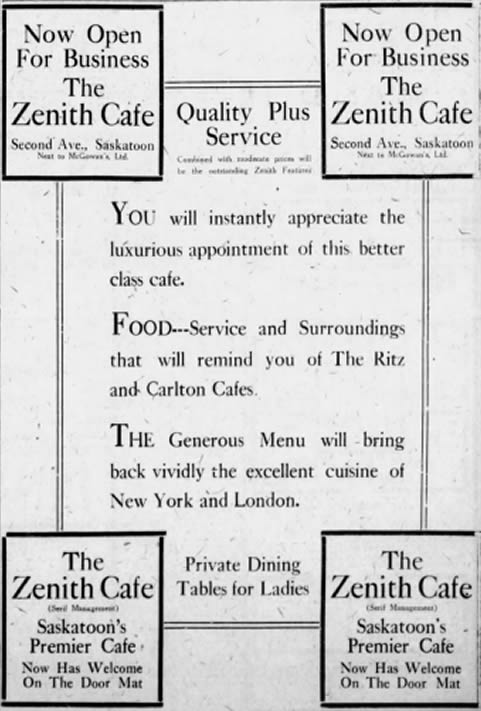
Saskatoon Phoenix, December 13, 1919, p. 13.
The Zenith Café continued to operate in the Zenith Building until 1924 when the building was sold to Robert McGowan, a dry goods merchant. The restaurant relocated to a new two-story building that would be constructed in a vacant lot immediately north of his Café’s present location.

Zenith Café at its original location in the early 1920s; the vacant lot next to the building is where Sam Serif relocated
the café in a newly constructed building built in 1924.
Source: Saskatoon Public Library, Local History Room (PH-93-47)
The new building was constructed with brick, concrete, and steel and had a Tyndall stone facing on the front. The restaurant consisted of a dining room and lunch counter on the main floor; a dance hall was located on the second floor.
Sam Serif considered his latest version of the Zenith Café as further advancing “toward the accomplishment of my ideal restaurant”. The Café boasted having the latest in kitchen technology:
“From the window before entering can be seen new electrical equipment of special interest. One article is a new patent electric toaster that is entirely automatic in its operation.
Another new feature is the electric aluminum waffle iron, which is operated without the use of grease, one of those thoughtful touches of Mr. Serif to ensure cleanliness in food preparation. Beside it stands an aluminum pancake stove with which no grease is needed for cooking the cakes. One of the things that annoys the fastidious diner is to see fingerprints on the butter with which he is served. Thanks to a new machine Mr. Serif has installed, the diner can now eat his bread or toast with relish because no hand touches the butter with which he is served.
In the kitchen, the sight sometimes of men and women washing dishes, often in water that has done service for half an hour, is not in evidence at the Zenith. Instead, there is a square metal box into which the dishes after use are placed. Hot water and steam, running freely all the time, wash the particles of food away and completely sterilize the dishes before their removal from the machine” (Saskatoon Daily Star, December 13, 1924, p. 11).
The owners of the Zenith Café described their business as having “earned the high distinction of being regularly patronized by Saskatoon’s most critical clientele” and “that people of above the average of intelligence have given their preference to the Zenith”. Furthermore, the Café’s menu offered “the choicest edibles such as the most cosmopolitan appetite could fancy”. The Café was popular among women for a “light repast and a chat” in the afternoon and a “quiet meal” in the evening (Saskatoon Star-Phoenix, December 31, 1929, p. 80).
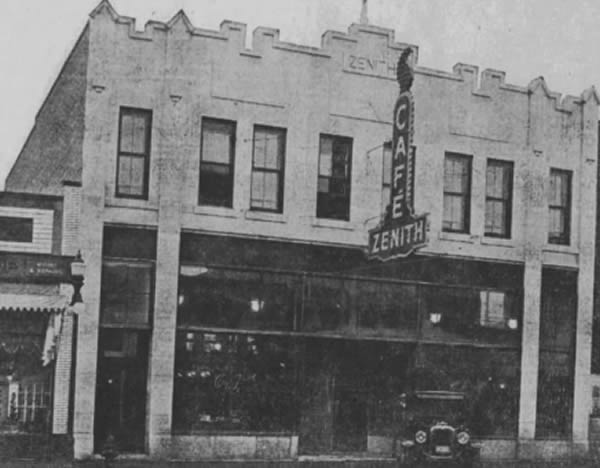
Saskatoon Star-Phoenix, December 31, 1929, p. 80.
The Zenith Café was located across the street from the King George Hotel which contained the studios of Saskatoon’s second radio station, CJWC. Sam invited the station to broadcast live performances of the cafe’s in-house orchestra, as it played for patrons in the dining room. Sam also invited traveling bands, including black jazz musicians, from across North America to play at his Café.
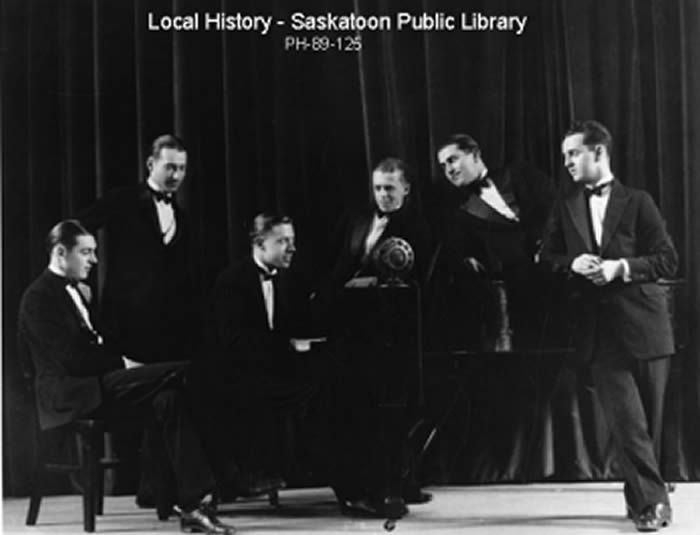
Members of the Zenith Café Orchestra (circa 1926)
Source: Saskatoon Public Library, Local History Room (PH-89-125)
The Saskatoon Musicians’ Association Local 553 objected in the spring of 1926 to Zenith Cafe’s use of non-unionized and non-local musicians. To avoid the threat of withdrawal of affiliation, the musician’s association’s objections were supported by the Saskatoon Trades and Labour Council who urged Saskatonians to boycott the Café. Later, in October, the Café launched legal action against the musicians association, claiming $35,000 in damages and requesting a permanent injunction against suggestions that the Café was “unwilling to employ union labor, that [it] did not pay fair wages or the wages ordinarily paid, that [it] overworked [its] employees and that [it] required [its] employees to work for longer hours than others of a similar class” (Saskatoon Star-Phoenix, October 26, 1926, p. 8).

Saskatoon Star-Phoenix, March 22, 1926, p. 8.
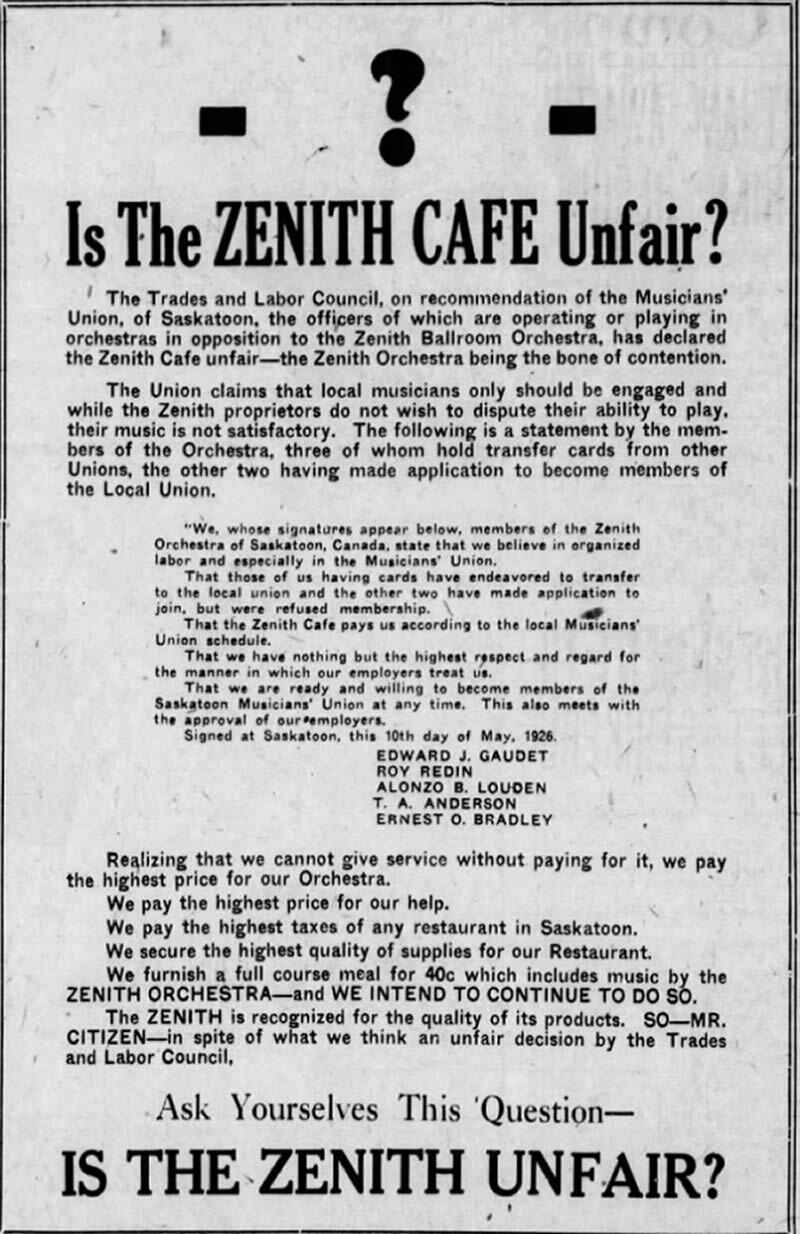
A newspaper advertisement paid by the Zenith Café
Saskatoon Star-Phoenix, May 12, 1926, p. 12
In December of 1926, the Zenith Café and the musician’s association settled their dispute, with the players in the Café’s orchestra taking out membership in the association.
In 1927, a ballroom was added to the second floor of the Zenith Café building. Also, a 24-hour bakery was added which offered cakes, pastries, pies, and other bakery products. In that year, Sam, John, and Nester dissolved their partnership in the Zenith Café and Sam became the sole owner.
In 1928, the second-floor ballroom was divided into separate spaces. One side remained as a hall and the other was converted into a seven-lane bowling alley which specifically catered to female (five-pin) bowlers. The success of the bowling operation led Sam to construct a 27-lane five-pin bowling facility and billiard hall (“Zenith Recreation Academy”) on the corner of Third Avenue and Twenty-third Street.
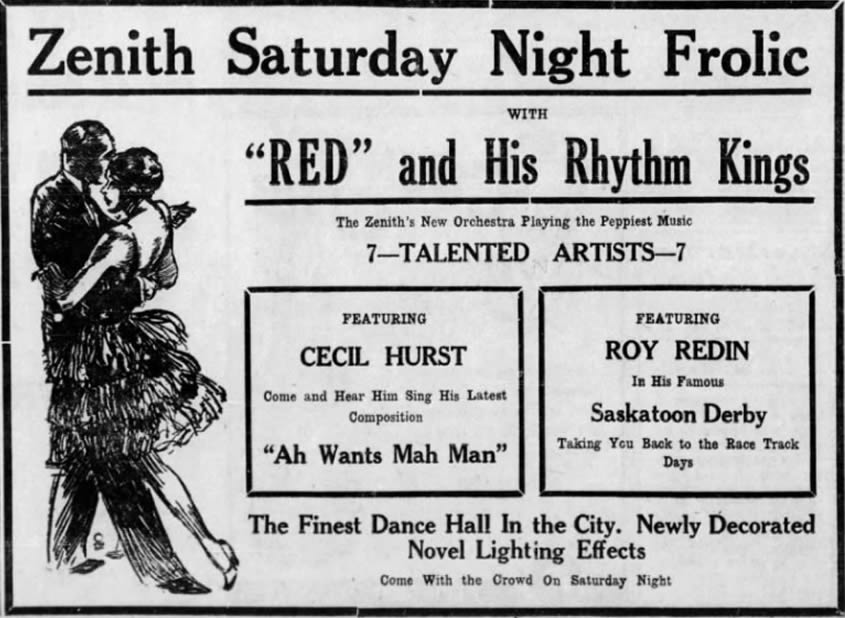
Saskatoon Daily Star, January 27, 1928, p. 11.
In 1929, the Zenith Café made broadcasting history with Canada’s first television transmission from the Café to a home on Avenue G North. Sigurd Sanda, who operated Sanda Medical Instrument and Hearing Aid, had built one of the world’s first television transmission systems, but he was unable to obtain financing to support further development of this technology (Saskatoon Sun, December 22, 1996, p. 32).
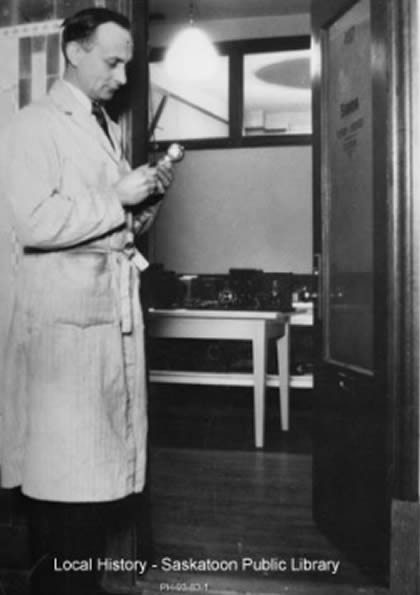
Sigurd Sanda at the doorway of his laboratory in the 1930s
Source: Saskatoon Public Library, Local History Room (PH-93-83-1)
With the pressures of the 1930s’ depression, the Zenith Cafe was forced to close in 1938. Sam Serif and his family moved to Ontario.
Researched by Ken PonƟkes, October 2, 2023
Sources: Data files of Immigration, Refugees, and Citizenship Canada; Saskatoon Daily Star, April 18, 1917, p. 3, March 3, 1919, p. 9, June 16, 1919, p. 10, and June 10, 1924, p. 3; Saskatoon Phoenix, April 15, 1920, p. 3; June 10, 1926, p. 3; August 21, 1928, p. 3 and September 9, 1938, p. 3; Edmonton Journal, November 3, 1954; Province of British Columbia, Registration of Death, March 1, 1972; Saskatoon Sun, December 22, 1996, p. 32; City of Saskatoon, Heritage Register, https://www.saskatoon.ca/community-culture-heritage/heritage-properties-programs/heritage-register; Karen Racine, “The Zenith Building”, A Historical Survey prepared for the Saskatoon Municipal Heritage Advisory Commttee, 1996.
Golf's Steak House
Golf’s Steak Lodge/Golf’s Steak House
317 Twenty-first Street East
Owner/Operator: Bill Golf
Bill Golf opened Golf’s Steak Lodge in 1961. The restaurant was located on the main floor of the Commercial Block at 317 Twenty-first Street East. It had a “log-cabin” décor.
Golf’s Steak Lodge specialized in charcoal broiled steaks, but its menu also included barbecue spareribs and rainbow trout. When it opened, $1.29 was the price of the lunch special which consisted of a small club steak, served with French onion soup or tomato juice, tossed salad, baked potato, ice cream, and coffee.
Golf’s Steak Lodge/Golf’s Steak House – both names, as well as The Corral Room, were used to identify the business (1962)
Source: Saskatoon Public Library, Local History Room (QC-2301-3)
Dining Room, Golf’s Steak Lodge (1962)
Source: Saskatoon Public Library, Local History Room (B-7178
Shortly after opening his restaurant, Bill hosted special dinners for children and adults with disabilities. The dinners were organized through an organization that is known today as SaskAbilities.
Bill Golf serves ice cream to almost 50 children and adults with disabilities who attended a dinner he hosted for them at Golf’s Steak House
Source: Saskatoon Star-Phoenix, December 22, 1961, p. 7.B
In 1962, the restaurant (through Bill Golf’s company, Skyline Restaurants Ltd.) received a license to sell liquor with its meals. Coincidently, the business began to promote itself under the name, Golf’s Steak House.
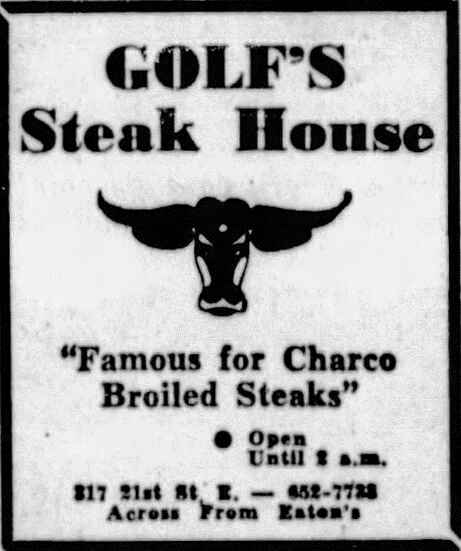
Saskatoon Star-Phoenix, July 26, 1963, p. 4.
In 1967, Golf’s Steak House received a major expansion and redecoration. The exterior of the restaurant now had a “modern European” style. This renovation was undertaken in conjunction with the restaurant receiving a cocktail license. In 1968, an addition was constructed at the rear of the building.
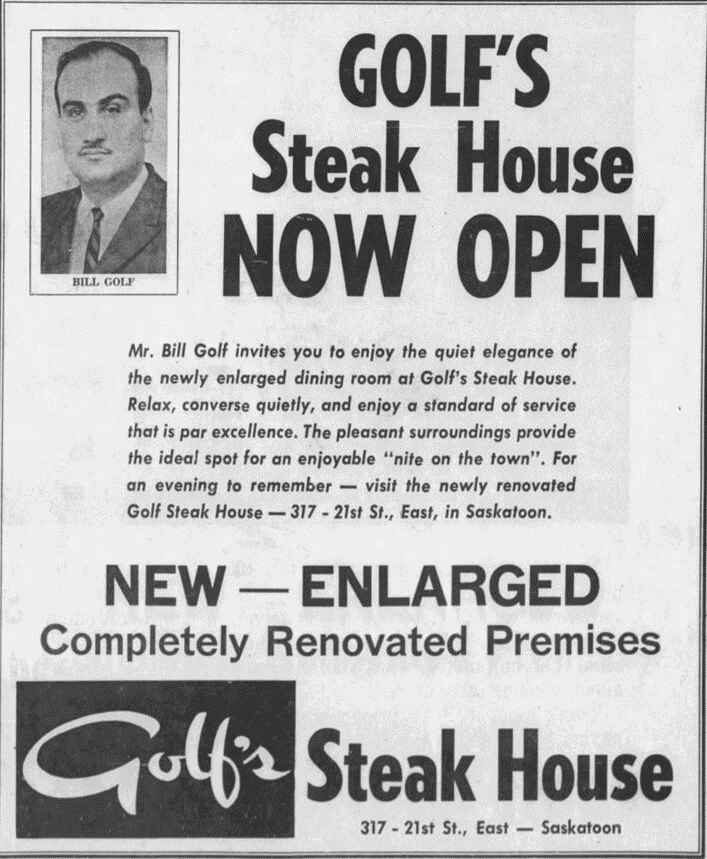
Saskatoon Star-Phoenix, August 15, 1967, p. 8.
The renovated exterior of Golf’s Steak House
Source: Saskatoon Star-Phoenix, January 2, 1968, p. 10.
By 1970, Chris Kokkas was identified as the manager of the steak house. Musicians were also hired to play in the dining room after 8:00 p.m.
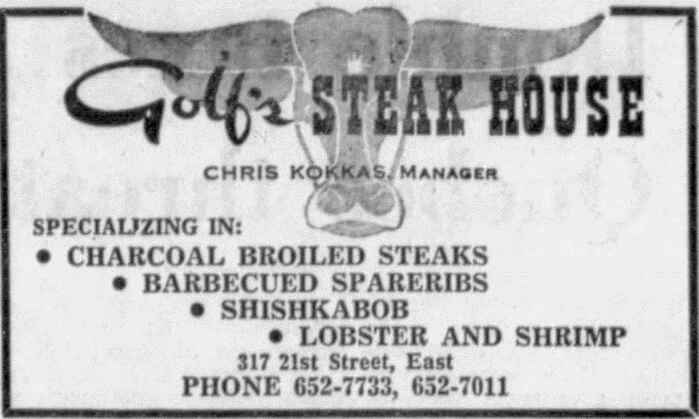
Saskatoon Star-Phoenix, April 23, 1970, p. 19
In 1971, Bill Golf and his brother, Peter Golf, as well professional engineer, John Yannikostas, purchased property at 1945 Victoria Avenue (Victoria Avenue and Hamilton Street) in Regina to build a restaurant, which would also be known as Golf’s Steak House. The property was the former site of Bremner Funeral Home. Construction began on the new building – consisting of one storey and a full basement – in September of that year. The owners called for tenders through their company, Golf’s Steak Houses Limited.
The Regina restaurant, with a capacity of 180 customers, opened in May of 1972 with John Yannikostas as its manager. Chris Kokkas (through his company, Kokkas Restaurants Ltd.) continued as the manager of the Saskatoon restaurant.
Golf’s Steak House in Saskatoon was listed in Anne Hardy’s “Where to Eat in Canada”. In 1974-75, it was the only restaurant in Saskatoon to make the list. The restaurant in Regina was listed in subsequent editions of Ms. Hardy’s book.
In 1980, the Regina restaurant was sold by Peter Golf and John Yannikostas to the Kolitsas brothers – John, Tony, George, and Gus — who operated several restaurants in Regina, Moose Jaw, and Yorkton under the name, Houston Pizza. The new owners continued using the name, Golf’s, after taking ownership of the Regina restaurant.
Regina Leader Post, July 25, 1988, p. 17
In 1981, a fire caused considerable damage to Golf’s Steak House (as well as the suites and offices on the second floor) in Saskatoon. The fire started in the basement, moved upward along the west wall, and then spread through the ceiling on the second floor. The fire broke out shortly before midnight and took approximately three hours to extinguish. Firefighters cut holes in the walls and pulled down ceilings to fight the fire. The cause of the blaze was careless smoking.
The Saskatoon restaurant was not replaced. Skyline Restaurants Ltd. still owned the property and therefore, received the proceeds from the sale, by public auction, of all its salvaged contents in November 1983. (The property was sold in 1984 and redeveloped into a Dairy Queen/Taco Time fast food outlet.) Meanwhile, the Regina restaurant – still known as Golf’s Steak House — continues to operate under the ownership of Maria Kolitsas-Lang, daughter of George Kolitsas.
Saskatoon’s firefighters required oxygen tanks to fight the fire and extensive smoke at Golf’s Steak House
Saskatoon Star-Phoenix, September 18, 1981.
Researched by Ken Pontikes, July 9, 2024
Sources: Various editions of the Henderson Directory (Saskatoon), the Saskatoon Star-Phoenix, and the Regina Leader-Post.
Memories of Golf’s Steak House (Saskatoon)
Golf’s Steak House is one of the more expensive dining spots in town. But, based on a recent visit there, one should perhaps hasten to add that the adage ‘you get what you pay for’ is most appropriately applied in this case.
We wined and dined on a recent Saturday night and enjoyed it thoroughly. We also walked away with one of the highest tabs we’ve experienced since starting the column a year ago. But again, it wasn’t entirely the restaurant’s fault. We just went a little overboard with our ordering.
A little common sense could have saved a little on the waistline and the pocketbooks. But oh, how we enjoyed the over-indulgence.
As a change, we decided to eat a little earlier this particular night in order to grab a show later. When we arrived downtown at 6:30, there were even plenty of empty parking stalls on 21st Street directly in front of Golf’s.
The four of us were directed to a table toward the centre of one of the dining room sections, but after being seated, we asked if it might be possible to move to one of the tables near the wall which was not so brightly lit. It was not the problem, being that we were one of the evening’s earlier parties.
The waiter was quick to ask if we cared for a cocktail and was back in a flash with my Manhattan “straight-up” – without ice. Made of vermouth, rye, and bitters, it’s perhaps too dry for many. They sort of grow on you, however.
The menu offers a wide assortment of appetizers, albeit slightly expensive. There are such things as jumbo shrimp ($4.25), seafood cocktail at $4.65, hearts of artichokes at $3, baby dry ribs at $4.10, shrimp scampi at $4.25, and stuffed mushrooms at $3.95.
Not being able to pass these all by, the seafood cocktail, dry ribs, artichokes, and baked onion soup were delivered to our table. The seafood dish, which has all sorts of goodies such as shrimp, clams, and lobster minced together, is served in a large bowl and is deliciously applied to a chunk of garlic toast. I didn’t order the dish, but because of its size, was asked to give a helping hand to finish it off. I was also asked to try a dry rib. It was spiced with what was probably oregano and lemon and was excellent.
My French onion soup was burning hot. “Watch out for it”, warned the waiter. The soup was also spicy and loaded with cheese. It was good, but I could well have saved the $2.45 it cost if I had given a little more consideration to what was coming.
Of course, we also all had to have the fresh salad served with the meal. But we finally began to catch on that perhaps one should take it easy at this point and left most of the salad as we sipped our wine.
We decided on a bottle of Mouton Cadet – a dry, red Rothschild from the Bordeaux region of France. This is served at room temperature and is excellent with steak. At $11.50, it is about the average price on the wine list.
Two of us decided to try the chateaubriand at $29.95. This is beef tenderloin, brought to the table as a large piece, then sliced up there into two portions and surrounded by a bouquet of vegetables and delectable mushrooms.
A feast in itself and at a price of $15 each, still not any more expensive than most individual meals. The vegetables included a stuffed tomato, green and white asparagus, baby carrots, cauliflower, and small roasted potatoes. If we had known the dish included potatoes, we would never have ordered the baked ones which are offered with all main courses. They went to waste.
The beef tenderloin was ordered ‘medium’ and came slightly red and juicy. It was tender enough to almost cut with a fork. Super.
My wife had Steak Neptune – filet mignon topped with Alaska King Crab legs and asparagus, then smothered with Hollandaise sauce. The waiter suggested having sliced tomatoes with the dish rather than the potato. This was appreciated.
Also appreciated was the fact the waiter had earlier pointed out the artichokes were canned, not fresh. But they were still enjoyed. And, the dining room is probably the only one in the city which notes on the menu that their lobsters are of the African variety, not the Atlantic. Fresh, Atlantic lobster is a rarity in Saskatoon. (Not that it makes that much difference because few can probably appreciate it.)
The bill for my wife and I came to $52. This included $5 for aperitifs, $5.45 for the soup and artichokes, $30 for the main course, and $11.50 for the wine. For four of us, the total topped the $100 mark before a tip. However, the comments made while we wandered up 21st Street to the theatre were all complimentary.
Next time around, the appetizer will have to be passed by. Of course, the stuffed mushrooms, even at $3.95 sound great. As a main course, the Beef Wellington – filet mignon topped with pate-de-fois gras and baked in puffed pastry – might be tried.
Less-expensive main courses included chicken cordon bleu, grilled pepper steak, and barbecued spare ribs at $9.95.
The dining room is comfortable and set in what is easily described as a steak-room atmosphere with a Mediterranean touch.
Source: Art Robinson, “Bill of Fare”, Saskatoon Star-Phoenix, April 21, 1979, p. 9.
Silver Gray Cafe
Silver Gray Café and Gray Haven
142 Second Avenue South
Owners/Operators: James Frangkis (“senior partner”), Mike Zootis, Nick Lappas, and Angelo Boulis
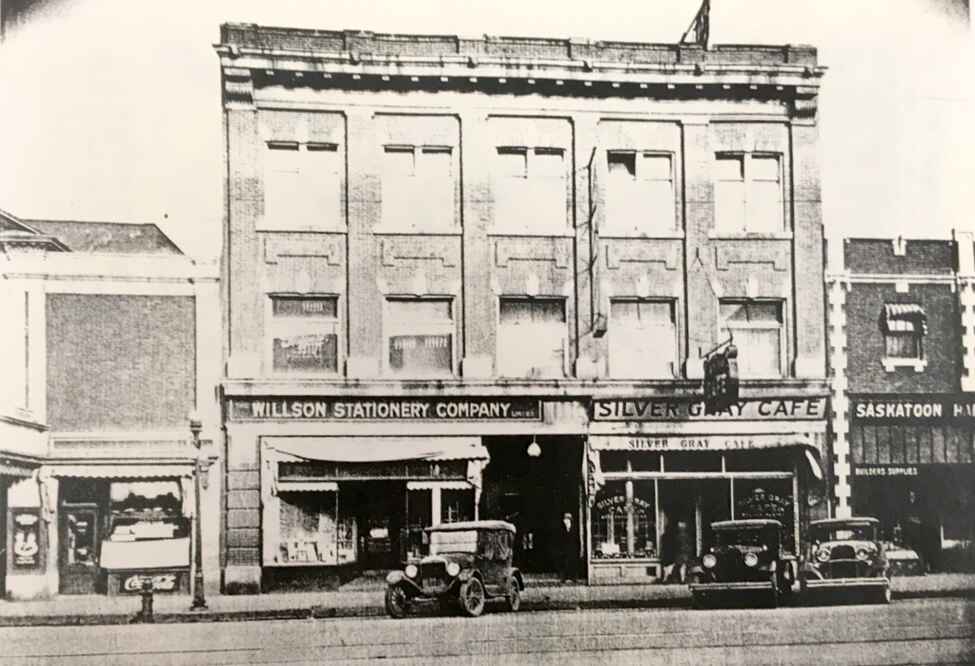
The Silver Gray Café (early 1930s)
Source: Cleo Girgulis, “Greek Immigrants in Saskatoon”, Saskatoon History Review, Number 6 (1991), p. 6.
The Silver Gray Café opened on March 28, 1924, on the main floor of the Ferguson Block. The name of the Café was chosen through a contest that attracted over 1,000 entries, with the winner receiving a $10 gold piece for suggesting “Silver Grey Café”. To celebrate the opening, the owners donated one-quarter of the first day’s receipts to the Red Cross Society and the Saskatoon Sanatorium (Anti-Tuberculosis League). Each organization received $31.08 (Saskatoon Daily Star, April 8, 1925).
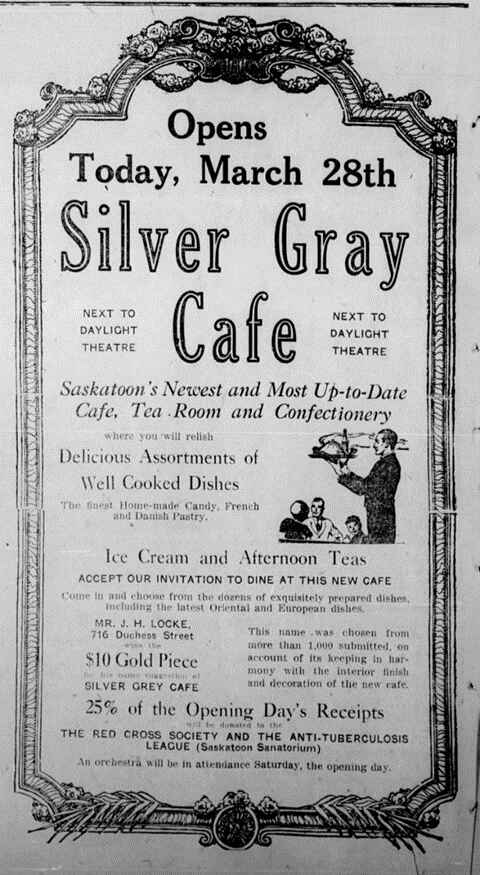
Saskatoon Star-Phoenix, March 28, 1925, p. 8.
The Silver Gray Café was among the first Greek-owned restaurants located on Second Avenue to recognize a trade union representing waiters and waitresses. In 1927, the Café agreed, in a written agreement, to terms whereby employees would work a maximum of six-day weeks and nine hours per day; they would be paid $50 per month, plus meals.
In 1928, the Café expanded to include a dining room (accommodating 75 people)/banquet room (accommodating up to 100 people), which was named (following another naming contest), the Gray Haven. The difference in accommodations was due to the ten booths in the addition which served dining customers and which could be removed for banquets. The Gray Haven was located behind the restaurant and had access to natural light through a light well, as well as windows at the rear of the building.
The restaurant included a balcony that contained a piano and was used for orchestra performances. A second piano was in the Gray Haven.
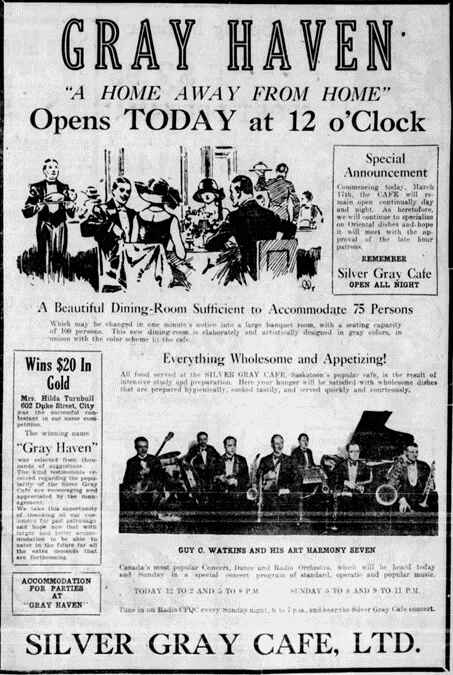
Saskatoon Star-Phoenix, March 17, 1928, p. 13
The Art Harmony 7 Dance and Radio Orchestra played frequently at concerts and dances in the Gray Haven. It was a dance band that specialized in “jazz rhythms”.
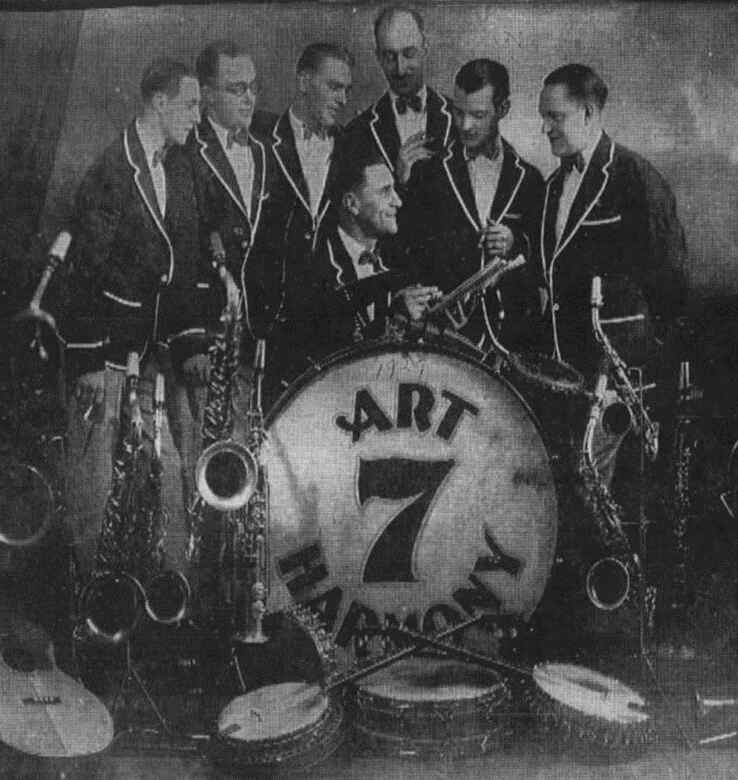
The Art Harmony 7
Left to right: Jay van Buskirk (banjo, guitar, and trumpet), Herb Neve (tenor and soprano saxophone and clarinet), Virgil Meyers (tenor, soprano, and baritone saxophone and clarinet), Ken Moore (banjo, mandolin, baritone saxophone and clarinet), Landon Muirhead (trumpet and bass saxophone), Stewart Roberts (piano and accordion), Guy Watkins (leader and percussion)
Source: Saskatoon Star-Phoenix, November 14, 1970, p. 21.
In 1928, the restaurant was open 24 hours a day. It specializes in Asian and other imported foods. By 1930, the restaurant was promoting that its meats and vegetables were sourced locally and therefore, was supporting local farmers. Daily specials were offered that were completely locally sourced.
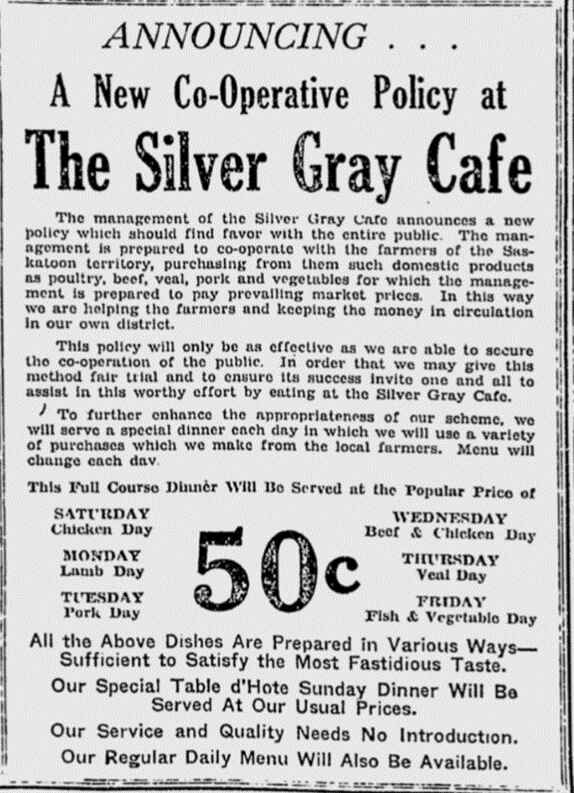
Saskatoon Star-Phoenix, November 22, 1930, p. 10.
In 1931, a fire “wiped out” the Silver Gray Café and Gray Haven. The entire Ferguson Block, which was constructed in 1910, was gutted. The building contained several businesses, in addition to the Café; the upper floors served as a rooming house (the Daylight Apartments).
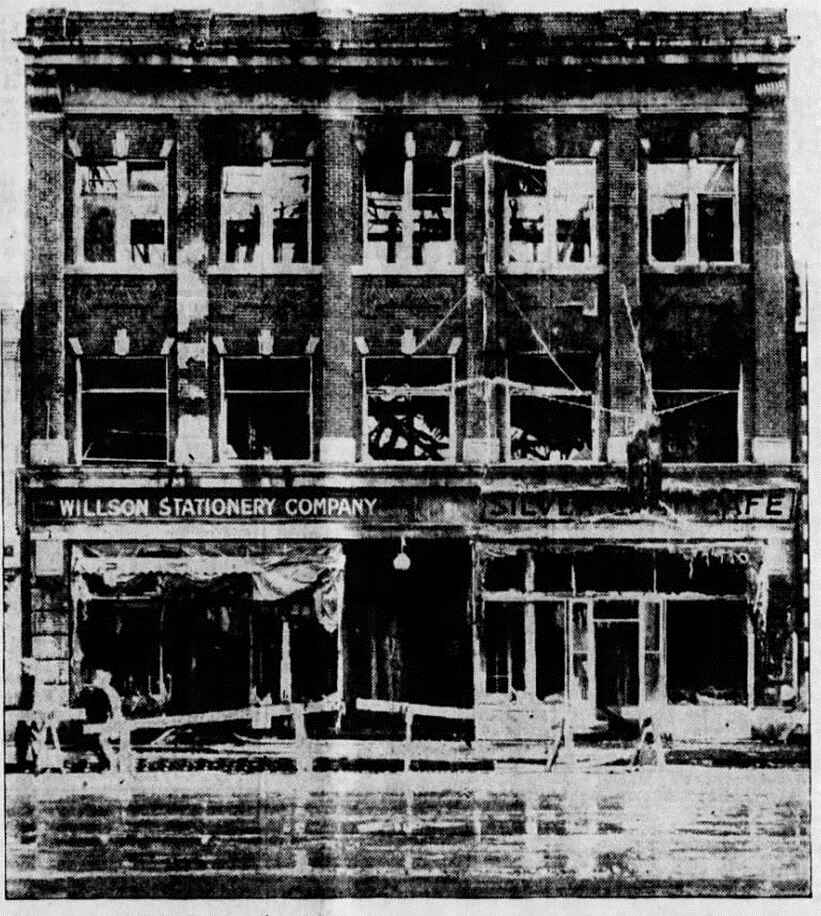
Saskatoon Star-Phoenix, February 2, 1931, p. 3.
James Frangkis (identified as the “senior partner”) estimated the Café’s value of the loss at $45,000, with only 30% covered by insurance. Immediately following the fire, he indicated that his business would be re-established as soon as the Ferguson Block was rebuilt. However, he soon changed his mind and left Saskatoon with his family for Montreal. In 1934, James was reported to have opened a large restaurant, known as the Silver Gray Restaurant, located on Bank Street in Ottawa.
Researched by Ken Pontikes
Sources: Saskatoon Phoenix, March 28, 1925, p. 9; Saskatoon Daily Star, April 8, 1925, p. 3; Saskatoon Star-Phoenix, July 23, 1927, May 28, 1928, p. 13, February 2, 1931, p. 3, March 13, 1935, p. 4, and October 30, 1962, p. 3; Ottawa Citizen, January 5, 1935, p. 13.
Barry Cafe
Barry Café
201 – 20th Street West, Saskatoon
Owners/Operators: Peter G. Bezbes, James Kosmas, and Peter K. Pontikes (1954 – 1968)
In 2008, the Barry Hotel on 20th Street West was demolished. The Hotel had acquired an unsavory reputation as “a home for prostitutes, drug dealers, and general thuggery” (Saskatoon Star-Phoenix October 10, 2013, p. E1). Yet, before the 1980s, it was among Saskatoon’s most reputable hotels, with a rich history that anchored the development of the city’s “west side” business district and that provided a venue for many important events and celebrations. From 1954 to 1968, a partnership consisting of Peter G. Bezbes, James Kosmas, and Peter K. Pontikes, leased space in the Hotel to operate the Barry Café and an associated hotel banquet room.
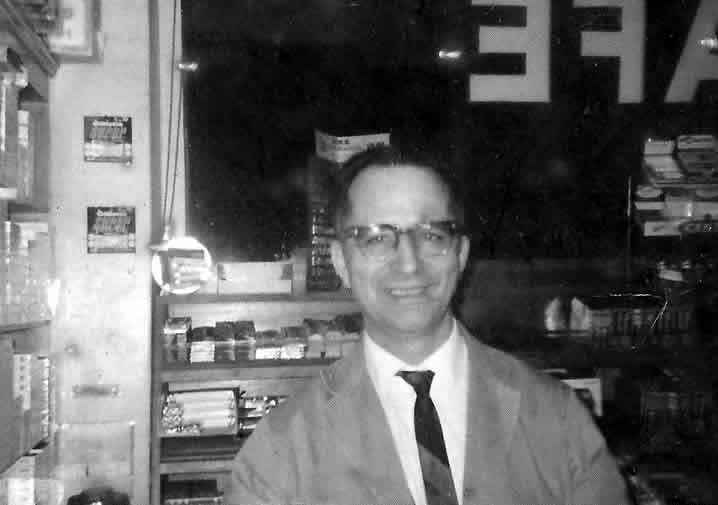
Peter K. Pontikes inside the Barry Café (1966)
Source: Pontikes Family Photo
The Barry Hotel opened in 1913, at the corner of Twentieth Street West and Avenue B South. It was built as a three-story reinforced concrete structure, with a brick and stone exterior. The main entrance to the Hotel led to a rotunda, with a cigar stand located on one side and a 120-seat dining room and bar room on the other. One hundred and fifty guest rooms, consisting of single rooms and suites, were located on two upper floors. The basement included “Turkish bath” facilities, which the Saskatoon Phoenix described as “the last word in this luxury” (Saskatoon Phoenix, October 24, 1913, p. 3).

Barry Hotel (1913)
Source: Saskatoon Public Library, Local History Room, General Photographers Collection (PH-2000-3-4)
An early morning fire at the Barry Hotel on a cold December 8, 1946, claimed eleven lives and injured another 8 people. The exterior walls were mostly still standing.
The building was listed for sale in July 1947 and was sold by the following November to Rothstein Enterprises of Winnipeg, represented by Nathan (Nat) Rotshtein/Rothstein and his son, Dave Rothstein. The Rothsteins owned theatres and hotels, including the Roxy Theatre in Saskatoon and Marlborough and St. Charles Hotels in Winnipeg. The Barry Hotel was rebuilt and officially re-opened on March 27, 1948.
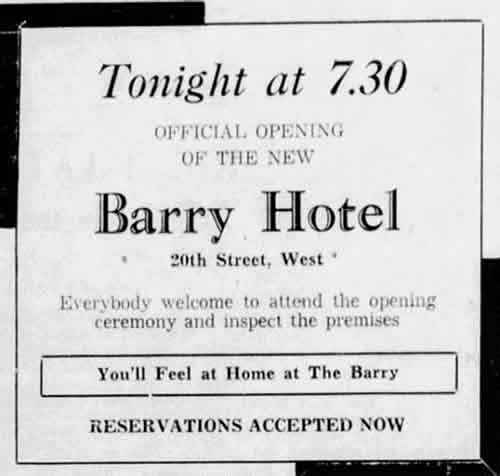
Source: Saskatoon Star-Phoenix, March 27, 1948, p. 2.
The food service in the renovated Hotel was known as Dinity Moore’s Eats and was advertised as having the capacity to “cater to banquets, private parties, and wedding parties” (Saskatoon Star-Phoenix, November 17, 1949, p. 7). Dinty Moore’s Eats continued to provide the Barry Hotel’s food service until 1954 when the ground-floor space in the northeast corner of the building was leased to Peter G. Bezbes, James Kosmas, and Peter K. Pontikes and became the Barry Café. Included in the lease was a separate room that could be used for meetings, banquets, and other celebrations. Shortly after leasing the space, the café and banquet room were renovated. The café consisted of a double-loop counter with rotating stools in the middle of the café space. There were several booths along the exterior walls and a sandwich bar, coffee urns, pastry display case, milk dispensers, and ice cream freezers along the interior wall that included a window to pass through meals prepared in the adjoining kitchen.

The Barry Hotel and Barry Cafe (1963)
Source: Saskatoon Public Library, Local History (PH-91-179-331)
During the 1950s, the Barry Café was open six days a week (6:00 a.m. to midnight) and closed on Sundays. By the end of 1961, the Café opened on Sundays (11:00 a.m. to 7:00 p.m.) and therefore, was better able to support the Barry Hotel’s “complete hotel service” every day of the week.
Sometime after opening the Barry Café, the three partners purchased property north of Saskatoon where they built the Suburban Restaurant. This restaurant and banquet facility opened in 1959. Jim Kosmas assumed primary management of the Suburban; the two Peters remained at the Barry and went to the Suburban to supplement the operations during holidays and when large events were booked into the dining and banquet rooms.
The Barry Café served as the meeting place for the Suburban Restaurant’s staff who didn’t have personal transportation. The restaurant owned a Volkswagen van which picked them up from the Barry and returned them at the end of their shifts.
The partners ended their lease at the Barry Hotel for the Barry Café in 1968. All three were now working full-time at the Suburban Restaurant.
Researched by Ken Pontikes (July 29, 2024)
Sources: Saskatoon Public Library, Local History Room; Saskatoon Phoenix, Saskatoon Daily Star, and Saskatoon Star-Phoenix, various editions; Pontikes family files and photos.
Personal Memories: Ken Peter Pontikes (August 2024)
The Barry Café served the customers, owners, and employees of many family-owned businesses in the Riversdale business area. Mornings and noon-hour lunch were the busiest time of the day at the Cafe. Customers came for coffee, breaks, to read the morning edition of the Star-Phoenix (a couple of copies were offered by the café to share), and to discuss the news and other events of the day with anyone who would listen. In the late evenings, the patrons of the Hotel’s beverage room purchased meals or dropped by for coffee to “sober up” before going home.
There were several permanent residents in the Hotel – that is, people who rented rooms by the month and considered the Hotel their home. The Hotel also accommodated travelers doing business in Saskatoon and the surrounding area. The Barry Café was often where they had their meals.
The Hotel also provided overnight accommodations for celebrities, of which the most well-known were the wrestlers who staged weekly live matches at the Arena Rink. My sister and I regularly watched these wrestlers on a weekly television show broadcast from Calgary. It was always a thrill to see them in person when they ate their meals at the Barry Café. It was also confusing to see them outside of their “show business persona”. My mother would often comment about how the wrestlers who seemed threatening, abusive, and untrustworthy on television were “perfect gentlemen” at the Barry Café.
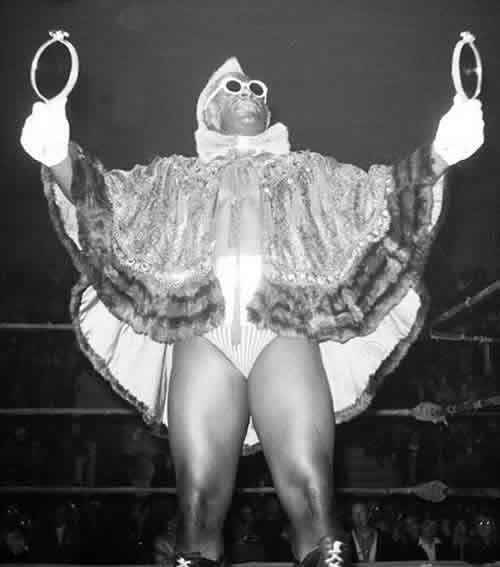
Sweet Daddy Siki: a regular customer at the Barry Café
Source: ProWrestling Stories (https://prowrestlingstories.com/pro-wrestling-stories/sweet-daddy-siki/)
Peter Bezbes opened the café at around 6:00 a.m., after which he prepared the kitchen for the day’s noon-hour business. My dad worked a split shift which began at around 10 a.m., with a break for supper between 5:30 p.m. and 9:00 p.m., and then continued until closing after midnight. He arranged his two shifts so that he could always be at home for supper with his family. We were fortunate to have a father who placed his children as a priority in his life.
My mother drove my dad to the café where she typed the daily lunch menu which was printed every day. (My mother often noted that her salary for typing the daily menu was a cup of coffee.) While the breakfast and supper menus did not change, the lunch menu followed a weekly schedule of entrees, soups, and desserts. Changes were often made to reflect the meats and other ingredients that were available. Nevertheless, customers came to expect certain items every week on specific days, e.g. spaghetti and rice pudding on Monday. A popular weekly item was turkey wings and rice in a creamy sauce.
The Barry’s banquet room was in the centre of the main floor of the Hotel and was not directly accessible from the streets. Entrance to the room was oly possible through separate doors from the Hotel lobby, the Cafe, and a barber shop/magazine and smoke shop. The banquet room also contained the washroom facilities for customers of the Cafe and for the people working within the buildings. The room served as a venue for numerous events, meetings, and celebrations. My sister’s baptism ceremony and banquet were held there. A frequent user of the room was the Riversdale business association which worked to lobby the City to improve the services and infrastructure of the area, as well as to support and promote the annual week-long outdoor show (Pion-Era) of the Western Development Museum when it was located on Eleventh Street West.
My dad did not want me to follow in his footsteps in the restaurant business. Therefore, unlike many other family-operated businesses, he did not encourage me to become a regular employee in his restaurants. However, he did believe that there were a few skills that I could learn alongside him. For example, every month, I helped him take inventory in the Café’s stockroom which was in the basement of the Hotel; my dad would climb up and down the shelves and shout out the items and amounts which I would then record into the inventory book. I also occasionally helped by “taking cash” during the Cafe’s regular operating hours. One summer, I would arrive daily at the Cafe at 11:00 p.m. to manage the cash area during the “rush” after the beverage room closed and lasted until just after midnight. Customers (mostly men) would stop for a coffee or to buy cigarettes before going home. As my dad served coffee to his customers, he would encourage them to direct any complaints to me — particulary if I messed up making their change, hesitated in finding the tobacco product they wanted (cigars were the most confusing for me), or failed to say “thank you” when they paid. This was part of my dad’s plan to make me decide against making a career in the restaurant business.
Christmas was a special time at the Barry Cafe and in the Riversdale business district. The street and the shops were seasonally decorated. My sister (and often one of her friends) would help my dad decorate the Cafe in late November or early December. The decorations included a Christmas tree in the banquet room and seasonal greetings and the famous “Bambis” (sparkly silhouettes of reindeer ) which my dad hung on the walls. During weeks prior to Christmas Day, the Cafe held their “turkey draws”; tickets were sold on a chance to win a box of “Pot of Gold’ chocolates. For a couple of years, I volunteered to “ring the bells” for the Salvation Army’s Christmas fund-raising “kettle” located on the sidewalk in front of Adilman’s Department Store and across the street from the Cafe; I shook sleigh bells to encourage people to drop their spare cash in a container, thereby adding to the season ambience of the street and keeping myself warm in freezing temperatures. Just a day or so before Christmas, my dad would invite nearby business owners who were regular customers to come to the Cafe for “coffee”; everyone sat in the booths at the back of the restaurant with smiles on their faces and with their hands folded over the top of their cups.
The Barry Café was a significant part of my life in the 1950s and 1960s. Today, I have fond memories of many of the Barry Café’s customers and the owners of the nearby Riversdale businesses.
Written by Ken Pontikes, August 5, 2024.
Golden Gate Cafe
Golden Gate Cafe and Confectionary
145 Second Avenue North
Owners: Agellos G. (“Charlie”) Kallops and Nicholas Lappas (1929 – 1930); Agellos G. Kallops and Minnie Pappas (1931 – ca 1934)
In December 1929, Charlie Kallops and Nick Lappas (formerly from the Silver Gray Café) opened the Golden Gate Cafe and Confectionary. It was in the former location of the Princess Confectionery and Tea Room.
The Princess Confectionery and Tea Room was operated by the Chrones brothers — Gus and George. This business closed in 1929 following George’s death. Gus continued to own the building and leased the space to Charlie and Nick to operate the Golden Gate Café and Confectionery.
The Golden Gate was advertised as a café, tearoom, and confectionery, with a “modern candy kitchen” that produced “home-made candies and chocolates” (Saskatoon Star-Phoenix, December 13, 1929, p. 6 and December 19, 1929, p. 19). Like many other tea rooms and cafes in Saskatoon, the Golden Gate also had a resident tea-cup reader, offering customers an entertaining glimpse into their futures.
Saskatoon Star-Phoenix, December 13, 1929, p. 6.
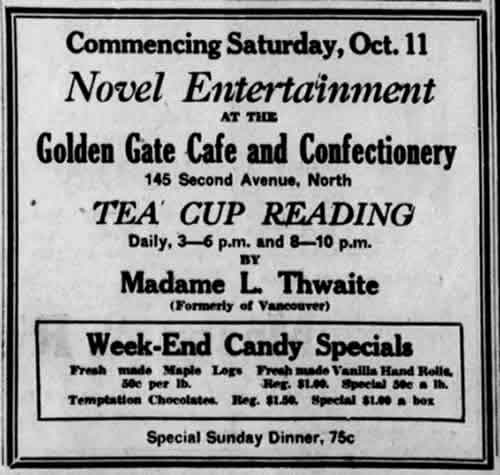
Saskatoon Star-Phoenix, October 10, 1930, p. 8
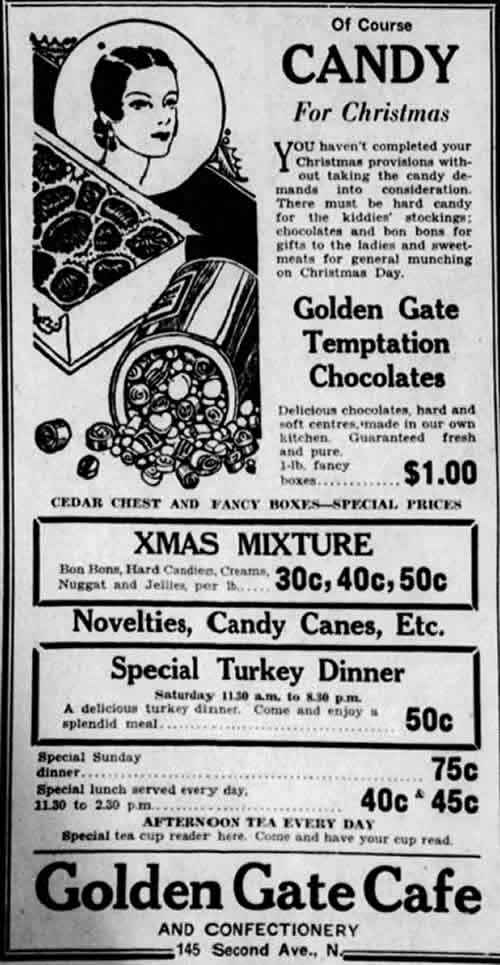 Saskatoon Star-Phoenix, December 20, 1930, p. 10.
Saskatoon Star-Phoenix, December 20, 1930, p. 10.
The interior of the café was redecorated in 1934. However, by 1935, it faced financial difficulties. The building was still owned by Gus Chrones. The Café’s operators (Kallops and Minnie Pappas) had fallen behind in their rent and were being investigate for violating the Minimum Wage Act.
There is no record of the Golden Gate Café and Confectionary operating beyond 1934. No businesses appear to have operated in the space between 1935 and 1936. In 1937, Ted Gardiner opened the Cameo Café in this location.
In 1935, Charlie moved to Prince Albert, but returned three years later, to operate the Broadway Luncheonette.
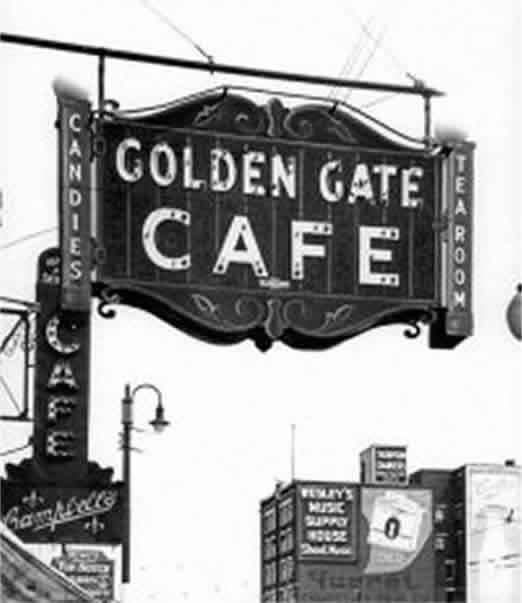
Golden Gate Cafe’s exterior sign (early 1930s)
Source: Hillyard Photographs Collection, Saskatoon Public Library, Local History
Researched by: Ken Pontikes, September 23, 2023.
Sources: Saskatoon Public Library, Local History; Saskatoon Star-Phoenix, various editions; Henderson Directory, various Saskatoon editions.
Embassy Cafe
Embassy Café
D.C. Block, 213 Second Avenue South
Owners/Operators: James Green and John Mirras (1939)
The Embassy Café opened in March of 1939 in the D. C. Block (213 Second Avenue South). It was one of several Greek-owned establishments to operate in this location. For example, prior to the opening of the Embassy Café, the Gem Cafeteria operated in this location. The Gem opened in the D.C.Block in 1930 and then relocated in 1939 to 242 Second Avenue South when the Elite Café relocated to a newly-constructed building at 244 Second Avenue South.
The Embassy Café had a lavish grand opening event on March 25, 1939. Flowers and cigars were given free to female and male customers, respectively. Special permission was given by Saskatoon City Council for releasing 1,000 balloons containing coupons which could be redeemed at the Café, Tivoli Theatre, Avenue Ballroom, Canada Shoe Rebuilders, or Grey Cabs.
An airplane also flew overhead to celebrate the grand opening.
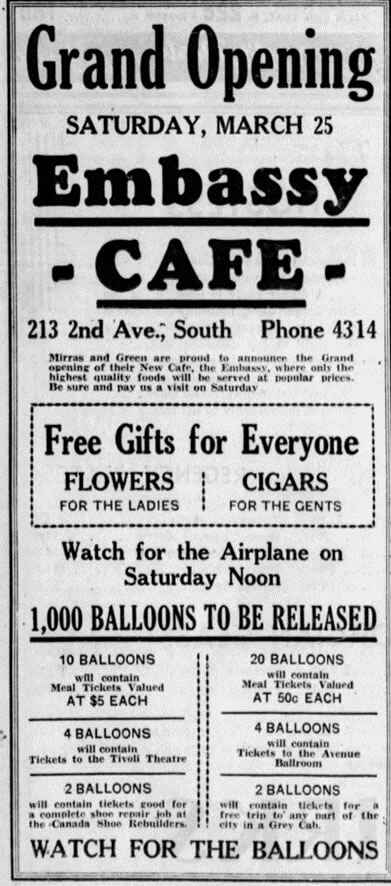
Source: Saskatoon Star-Phoenix, March 24, 1939, p. 5.
The Embassy Café had a seating capacity of 164. Twenty-six 26 air-pressured seats were at the lunch counter and the rest in dining booths running in two rows along the length of the café; another 46 seats were in an adjacent banquet/dining room. The Café’s décor was “Spanish style”.
A fruit counter was located on the right side of the entrance. A candy counter was located on the other side. There was also a tobacco counter and a soda fountain area.
The kitchen included new stoves (operated by two cooks) and a large electric refrigeration room A large “prep table” was in the centre of the kitchen for the cooks. Several other tables were available for use by the cooks’ assistants.
However, despite the enthusiastic grand opening, the Café closed a few months later. A distress warrant was issued by Mary Mirras for unpaid rent against John Mirras and James Green. (Mary Mirras, the wife of John Mirras, had purchased the D. C. Block in December 1938.) The distress sale occurred in August 1939.
By December of 1939, the space was occupied by the Gardener Brothers, led by Ted Gardener, who opened the Shasta Café.
Researched by: Ken Pontikes, August 23, 2024
Sources: Saskatoon Star-Phoenix, December 13, 1938, p. 1, March 24, 1939, p. 3, and August 12, 1939, p. 16.
Main Cafe / Savoy Cafe
Main Café and Savoy Cafe
118 – 21st Street East
Owners/Operators (Main Café): Chris Thanagan and M. Canell (1917)
Owners/Operators (Savoy Café): William K. Shourounes, Tony Varves, and James Girgulis/ Gourgoules (1917 – ca 1919 ); William K. Shourounes, Tony Varves, James Gourgoules, Athanacies (Tom) K. Varvietsiotis, William H. Girgulis (Gourgoules), and James Pontikis (1919 – 1922); William Shourounes, Tony Varves, and Athanasios Varvistsoitis (1922 – 1924); Tony and Tom Varves (1924 – 1928); Tony and Annie Varves (1928 – 1930); Harry Condidis (1930); Gus Thanagan (1931); Tony Bardelis (1931); “The Big Seven” restaurants, known as The Savoy Company Limited (1931)
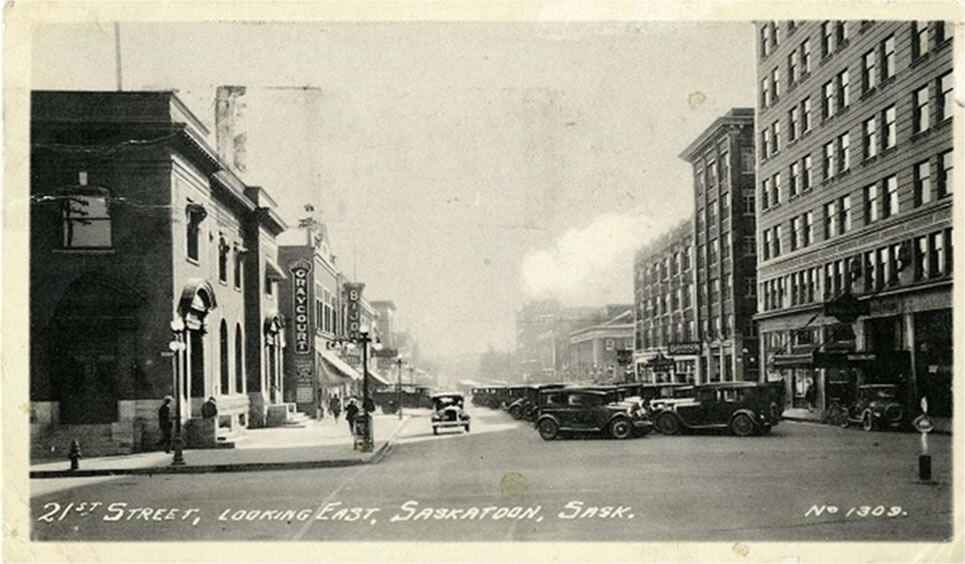
A postcard photo of 21st Street East, facing east from the Railway Station: The Clinkskill Block is on the left, with signage for the Graycourt Hotel and the Bijou Theatre; the Savoy Café is on the ground floor beside the theatre and under the second-floor hotel (ca 1930)
Source: Saskatoon Public Library, Local History Room (LH-5319)
The Clinkskill Block (located at 118 – 21st Street East) was constructed in 1906 for a general store operation owned by James Clinkskill – a prominent businessman and local politician who served as mayor of Saskatoon. In 1908, Clinkskill engaged an architect (W.W. La Chance) to manage a renovation and enlargement of the original building.
By 1910, the Clinkskill Block consisted of a clothing store, a café (Clinkskill Café), and a grocery store. In January of that year, Clinkskill announced that he would no longer operate a general store, but rather would focus his business on clothing (Saskatoon Morning Capital, January 6, 1910, p. 7). Therefore, the fixtures of the Clinkskill Café were sold by auction in November of 1910 and the space was subsequently leased to several different café operators.
In May 1917, James Clinkskill closed his retail business in the Clinkskill Block and consolidated the clothing business at another location (the Grainger Building, 129 Second Avenue South). The area vacated by the retail clothing operation in the Clinkskill Blook was leased to accommodate a larger café (Saskatoon Daily Star, April 18, 1917, p. 8.). The expanded cafe – now known as the Main Café – was operated for less than two months by Chris Thanagan and M. Canell.

Source: Saskatoon Daily Star, June 16, 1917, p. 2.
In August of 1917, the Main Café was sold to William K. Shourounes, Tony Varves, and James Girgulis (Gourgoules), who together were identified by the Saskatoon Daily Star as “a Greek company” (Saskatoon Daily Star, April 18, 1917, p.8). The café was now named as the Savoy Cafe. These men were previously employed at the Elite and Savoy Cafes in Regina. However, there was no formal business connection between the Regina Savoy and Elite Cafés (owned by Peter Girgulis, an uncle of brothers James and James Girgulis) and the Saskatoon Savoy (Saskatoon Daily Star, August 18, 1917, p. 2). In an article in the Saskatoon Phoenix, the Saskatoon owners pledged to “maintain a high-class restaurant . . . [which specialized in] quick service and cleanliness” (Saskatoon Daily Phoenix, August 18, 1917, p. 3).
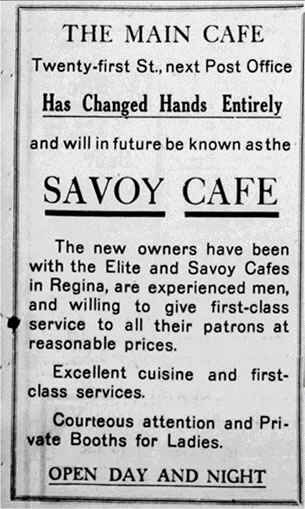
Saskatoon Phoenix, August 18, 1917, p. 3
In March 1919, the Savoy Café Company purchased the Elite Café Company. The latter company, owned by Samuel Serif, operated the Elite Café at 246 Second Avenue South. Mr. Serif indicated that he sold the café in light of an extended “business trip to Europe”, after which he hoped to return to Canada ( The Saskatoon Phoenix, March 3, 1919, p. 3). The new owners operated and marketed the two cafes together under the company name, Savoy-Elite Company.
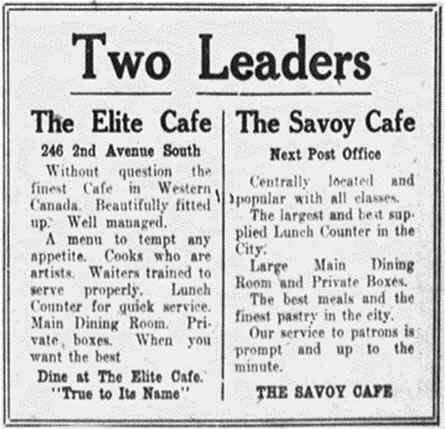
Source: Saskatoon Daily Star, September 8, 1919, p. 15
By early July, the Savoy Café was open 24 hours each day. An article in the Saskatoon Star-Phoenix described the Savoy Café as “a popular place at which all classes dine …” (The Saskatoon Phoenix, July 5, 1919, p. 5 and August 5, 1919, p. 2). Its location contributed to its popularity:
“The Savoy is next door to the Saskatoon post office, and it is likely that more persons have been served in this one café than any other two in the city, because it is in the heart of Saskatoon and so near the new Union station. Travellers who alight from the transcontinental trains and while waiting for other connections, usually enter this restaurant, as the big sign in the front is so noticeable from the station in day or nighttime, to have their appetites satisfied” (The Saskatoon Phoenix, July 9, 1920, p. 4).
In June 1920, the Savoy Café was renovated. The renovated exterior consisted of a “mahogany veneer, so treated that it will withstand the rigorous Canadian winters” and a “larger window display”. Inside, the woodwork was of “well grained birch . . . and the finish [was] artificial, but it so closely [resembled] the best mahogany wood that it would be a difficult task for a person unaccustomed to the various finishes to differentiate.” The maximum seating capacity in 13 booths was 52 patrons, plus another 22 people at the lunch counter. Eight booths, each seating four people and “fitted with mirrors” and an electric light, were available for “the ladies, theatre parties, and family dinners”. Management of the Savoy Café was the primary responsibility of James Girgulis, within the ownership of the Savoy-Elite Company.
When describing the opening of the Savoy Café and its link to the Elite Café, a reporter at the Saskatoon Star-Phoenix pointed out that the owners were skilled hunters:
“During duck season it is a hard task to locate any one of the proprietors of these two restaurants, as they delight in hunting the elusive mallard with their retrieving dogs, supplemented with waders and a warehouse of ammunition. Other hunters know where to take their chickens, geese or ducks when they want them ‘done up’ in fine style” ( Saskatoon Star-Phoenix, July 9, 1920, p. 4).
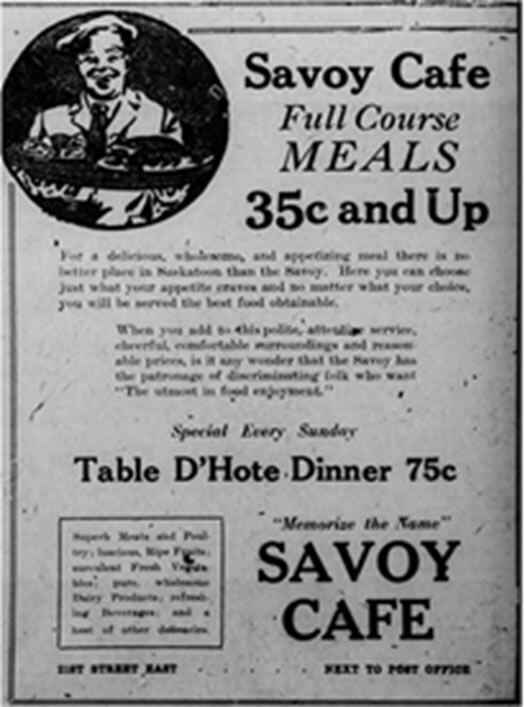
Source: The Saskatoon Star-Phoenix, November 20, 1922, p. 5.
In May 1922, the six-person partnership constituting the Savoy-Elite Company was dissolved. The ownership of the two cafes was split between William Shourounes, Tony Varves, and Athanasios Varvistsoitis (Tom Varves, who was Tony’s Brother) for the Savoy Café and James and William Girgulis for the Elite Café. In September 1924, William Shourounes sold his interest in the Savoy Café to Tony and Tom Varves. (Tom’s wife Annie was also very involved in the operation of the Savoy.) Mr. Shourounes indicated in an article in the Saskatoon Star-Phoenix that his plans included “hunting in the north for a time and after that . . . winter in Vancouver” (Saskatoon Daily Star, September 13, 1924, p. 7).
In 1927, waiters and waitresses at several Saskatoon restaurants had joined local unions. In July, employees at the Savoy Café, along with the Elite and Paris Cafes, walked off their jobs and established picket lines to demand union recognition and improvements to their hours of work and wage rates. The Trades and Labour Council argued that these employees “were being forced to work under a contract in direct violation of the provincial minimum wage act” (Saskatoon Daily Star, July 25, 1927, p. 3). A “compromise” was negotiated for the employees of the Savoy, Elite, and Paris Cafes where employees “would work nine hours a day, six days a week, for a wage of $50 a month”, but the proprietors would not be required to recognize the union ( Saskatoon Daily Star, July 26, 1927, p. 3).
In 1928, Tony Varves ended his partnership with his brother. He and Annie remained as the owners of the Savoy.
In May 1929, Thomas D. Smith, Aristotle L. Geatros, William L. Geatros, and Louis P. Chrones agreed to invest $65,000 in the Clinkskill Block. A caveat on the title secured their interests in the property which continued to be owned by James Clinkskill. Aristotle and William Geatros were brothers and along with their cousin, Louis P. Chrones, lived in Weyburn. Smith relocated to Saskatoon to manage the newly acquired property on behalf of the four owners.
At this time, the Savoy Café continued to operate on the main floor. At about the same time, the Savoy Café began a period of management and operational instability.
An auction sale of the Savoy Café’s restaurant equipment was scheduled for April 17, 1930. The sale was necessary under a “distress warrant for rent, contents” of the café (Saskatoon Star-Phoenix, April 14, 1930, p. 10). We know that Tony Varves and Annie Varves were also being sued for non-payment of bills by creditors, such as City Creamery (Saskatoon Star-Phoenix, December 3, 1930, p. 3).
By May 27, 1930, the Café had reopened following renovations and was managed by Harry Condidis (Saskatoon Star-Phoenix, May 27, 1930, p. 10). Management changed again in 1931 when Gus Thanagan was listed in that year’s Henderson Directory as the Café’s manager. Mr. Thanagan’s sister was Tony Varves’s wife.
Shortly afterwards, the operation of the café was taken over by Tony Bardelis, who also faced difficulties in operating the business profitably. His creditors were threatening to take over the business. His landlord, Thomas D. Smith, offered Bardelis $2,800 to buy the business’ stock and fixtures. Other restauranteurs thought that the assets were worth approximately $20,000 and if Bardelis accepted Smith’s offer, the amount would not be sufficient to cover all the outstanding debts. Therefore, seven café owners (referred to as “The Big Seven” and involving the owners from the Silver Grey [James Frangkis and Nick Lappas], Paris [Sam Sinis], Patricia [Barootes Family], Elite [William Girgulis], Commodore [Harry Terzakis], Chocolate Shop [Gus Golf], and Princess [Andrew Peters] Cafes) formed a separate company, The Savoy Company Limited, which bought Bardelis’ fixtures for $4,000. They took this combined action because, as articulated by Harry Terzakis of the Commodore Café, they considered Smith’s offer as “not right”. Sam Sinis of the Paris Café considered the action by the “Big Seven” as necessary to “keep on the right side of the wholesalers” (Saskatoon Star-Phoenix, January 8, 1932, p. 3),. Mr. Smith accused the seven cafes of creating a “combine” to put him out of business, including taking over his café lease at the Clinkskill Building. (Mr. Smith’s accusation was made during an inquiry undertaken by the Provincial Fire Commissioner under the Fire Protection Act. At the end of December 1931, suspicious fires had caused damage to the Chocolate Shop, the Gem Café, and the Eden Café. There was concern about an arsonist causing these fires [ Saskatoon Star-Phoenix, February 4, 1931, p. 14].) In addition to owning the Clinkskill Building, Smith also was a partner in the Gem Café.
The Savoy Café “reopened” again under “new management” (that is, the Big Seven’s Savoy Company Limited) in early February 1931 (Saskatoon Star-Phoenix, February 4, 1931, p. 14). Terzakis reported that during their ownership, the Savoy Company “made no money” in operating the Savoy Cafe.
On February 13, 1931, an advertisement in the Saskatoon Star-Phoenix indicated that the Savoy Café was available for sale, through the Canadian Credit Men’s Trust Association, as a “good going concern” (Saskatoon Star-Phoenix, February 13, 1931, p. 23). Then, on June 1, 1931, the Savoy Café was closed due to receiving a “notice to move” from the landlord (Saskatoon Star-Phoenix, May 30, 1931, p. 10). A September 1931, advertisement in the Saskatoon Star-Phoenix indicated that bids would be accepted until September 25 for the Café’s furniture and equipment which were valued at $20,000. This advertisement was followed by another, indicating that the furniture and equipment would be sold by auction on September 28, 1931.
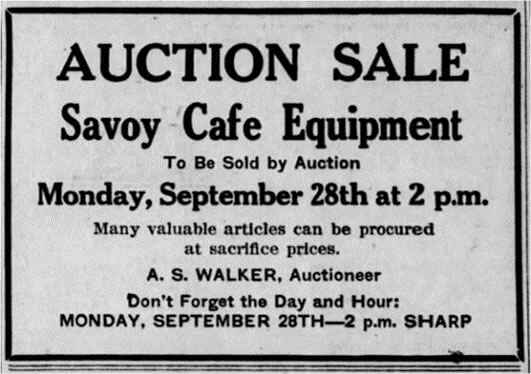
Source: Saskatoon Star-Phoenix, September 21, 1931, p. 2.
On November 14, 1931, the Savoy Café was renovated and “reopened” again, but under a new name – the Ritz Café – and new managers, William Geatros who had relocated from Weyburn and James Green who came from Estevan. The entire building was rebranded under the Ritz name – including the Ritz Hotel and the Ritz Theater.
Researched and written by Ken Pontikes, August 9, 2024
Sources: Saskatoon Morning Capital, The Morning Phoenix, Saskatoon Daily Star, and Saskatoon Star-Phoenix; various editions.
Cameo Cafe
Cameo Café
145 Second Avenue North
Owners: Gardener Brothers – Ted, Joe, and Effie (1936 – 1943); Gus Chrones (1943)
With the closure of the Golden Gate Cafe due to financial difficulties, the commercial space at 145 Second Avenue North became vacant until the Gardener brothers (Ted , Joe, and Effie) occupied it to operate the Cameo Cafe in July 1936. However, they faced challenges in opening the business, when they overlooked obtaining the required operating licence from the City of Saskatoon. After a summons was issued to appear in municipal court, the brothers paid the license fee, as well as a cost for its issuance and a service fee of $2.50 each, and legally opened their café.
Ted was born in Constantinople in 1911 and moved with his family to Saskatoon in 1923 where he completed his elementary and secondary education. He was initially employed at the Patricia Confectionery, but later moved to Edmonton where he established Teddy’s Confectionery. He returned to Saskatoon in 1936 to establish and manage the Cameo Café.

Saskatoon Star-Phoenix, July 18, 1936, p. 54.
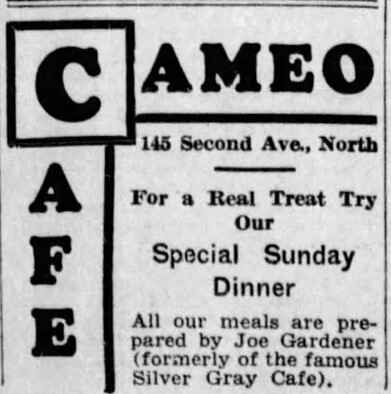
Saskatoon Star-Phoenix, September 19, 1936, p. 12.
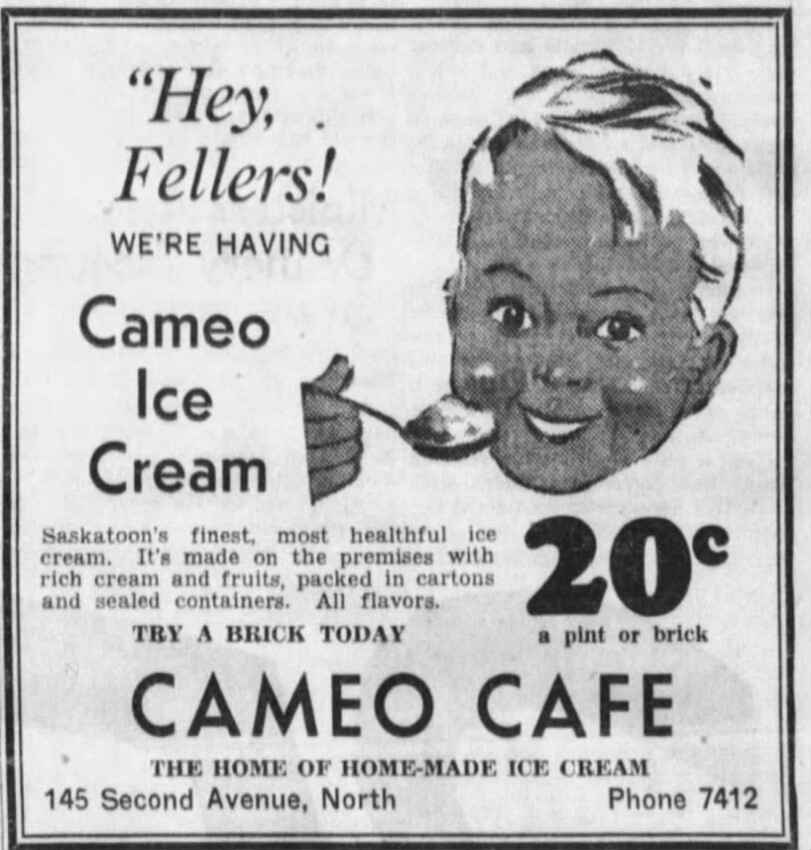
Saskatoon Star-Phoenix, June 12, 1937, p. 9.
In addition to the Cameo, the Gardener brothers operated the Cameo Café and Cabaret in 1938 on Jasper Avenue in Edmonton. Effie was the manager of the Edmonton café and caberet. Joseph Gardener, “noted for his appetizing dishes and for his skill in making home-made ice cream”, was the head chef for this business (Edmonton Journal, April 27, 1938, p. 17). Ted operated the brothers’ Saskatoon business in Saskatoon, the Cameo Café.
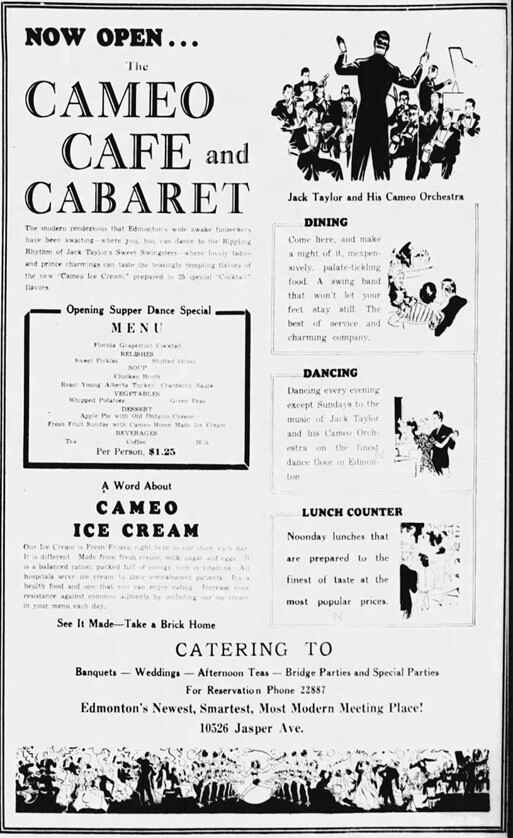
Edmonton Bulletin, April 27, 1938, p. 11.
In 1940, the Gardener brothers opened the Shasta Café at 213 Second Avenue South, in the space formerly occupied by the Embassy Café.
The Gardener brothers operated both Saskatoon cafes until 1943, when the Cameo was sold to Gus Chrones. There is no record of this Café being in operation beyond 1946.
Researched by Ken Pontikes, September 20, 2024
Sources: Saskatoon Star-Phoenix, Edmonton Bulletin, and Edmonton Journal, various editions.
Night Hawk Drive-In
Night Hawk Drive-In
2911 Eighth Street East
Owner/Operator: Peter Golf (1956 – 1959)
Opened in 1953 by Norman and Emma Kemp, the Night Hawk Drive-In was an independently owned, fast food drive-in restaurant. Its menu featured “hamburgers, jumbo dogs, chips, coffee, milk, soft drinks, ice cream” (Saskatoon Star-Phoenix, July 3, 1951, p. 10). In 1956, the Kemps sold the restaurant to Peter Golf. (The Kemps then acquired the rights in Saskatoon for the Dairy Queen ice-cream franchise.)
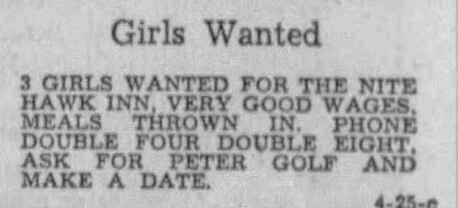
Saskatoon Star-Phoenix, April 23, 1955, p. 26.
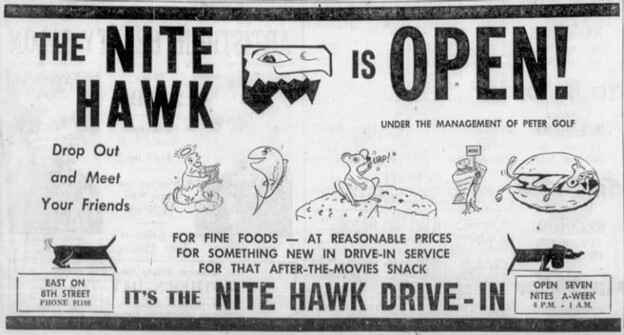
Saskatoon Star-Phoenix, April 30, 1955, p. 5.
The Night Hawk consisted of a small building within a large parking lot. Customers drove to the restaurant, ordered and picked up their food and drinks at a walk-up window, and ate in their vehicles. Music was played on loudspeakers to create a party atmosphere in the parking lot, which became a popular spot for showing off personal vehicles.
Peter operated the Night Hawk until 1959 when the small building was replaced by Canada’s first Dog ‘n Suds Drive-in, Peter had acquired the Dog ‘n Suds franchise for all of Canada in 1958.
Researched by Ken Pontikes, September 28, 2024.
Sources: David Geary, “Stories from the Heyday of the Drive-In Era in Saskatoon, 1950s – 1960s”, Saskatoon History Review, No. 32 (2022), pp, 26 – 40; Fuddruckers Family Fun Centre, “Celebrating Fuddruckers 33rd Anniversary as Saskatoon’s Favourite Family Restaurant”, December 28, 2018: https://www.fudds.ca/whats-new/celebrating-fuddruckers-33rd-anniversary-as-saskatoons-favourite-family-restaurant ; Saskatoon Star-Phoenix, various issues.
Gem Cafe & Hotel
Gem Cafe/Gem Cafe and Hotel
213 Second Avenue South (1930 – 1939)
242 and 244 Second Avenue South (1939 – 1971)
Owners: James Chrones and Thomas D. Smith (1930 – 1931) ; James Chrones, William Geatros, Aristotle L. Geatros, and John Mirras; (1931 – 1938); James Chrones 1939 – 1971)

Lunch Counter at 213 Second Avenue South (F. W. Woolworth Co. Ltd), sometime after 1914
Source: Saskatoon Public Library, Local History Room (A-1021)
James Chrones moved from Weyburn to Saskatoon in 1930 to operate the Gem Cafe in partnership with Thomas D. Smith. Prior to coming to Saskatoon, James and his brother Louis had operated a café in Weyburn.
The Gem Cafe was opened in February of 1930, initially as a cafeteria in the former Woolworth Building at 213 Second Avenue North. A “formal” re-opening as a café, which could serve 130 customers, occurred the following April. The Saskatoon Star-Phoenix described the redecorated café as “striking and impressive” with a “color scheme unequaled in the city, while numerous colored lights [added] charm to the scene” (Saskatoon Star-Phoenix, April 22, 1930, p. 16). By the end of 1930, Smith was replaced as an owner by William Geatros, Aristotle L. Geatros, and John Mirras.
James Chrones’ arrival to Saskatoon was welcomed by the local sports community. James was described by the Saskatoon Star-Phoenix as a “mentor” for the Weyburn hockey team. As part of the grand opening of the Saskatoon business, the Gem’s owners had committed to give 10% of the day’s receipts to the Saskatoon Quaker Rugby team and to the Saskatoon Football Association. James applauded the “sporting instincts of Saskatoon citizens, both players and fans” and looked forward to meeting them “shortly” (Saskatoon Star-Phoenix, April 22, 1930, p. 16).
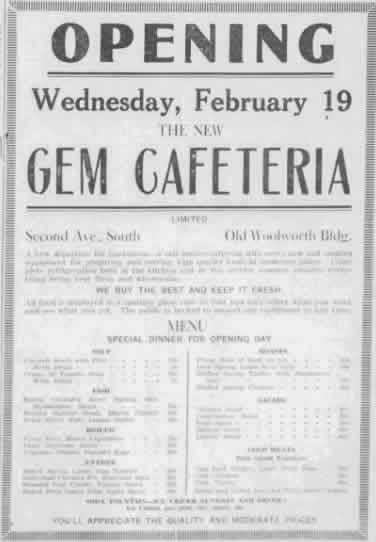
Saskatoon Star-Phoenix, February 18, 1930, p. 13.

Saskatoon Star-Phoenix, April 22, 1930, p. 16.
On December 30, 1931, a fire caused approximately $50,000 of damage to the building where the Gem Café was located. The Café operated on the main floor. All its stock and fixtures were destroyed. Two second-floor businesses (Chambury’s Photo Studio and Steiger’s Art Show Card Studio) and a toy repair shop operated by the Boy Scouts were also destroyed. The Saskatoon Star-Phoenix describes the fire as follows:
“All firemen on duty went to the scene of the blaze and the men on the off shift were called out from their homes. The latter reached the fire 20 minutes after the alarm was turned in [at 4:55 a.m.] and for four hours, all firefighters in the city available were on duty. When they first reached the building the back of the structure was described as a ‘raging inferno’. . . . The most spectacular part of the fire confined itself to the rear part of the building, where three lines of hose were used. Flames shot high in the air there, forming dense clouds of smoke which made visibility impossible . . . . At 6:20 [a.m.], however, those who had watched from Second Avenue were rewarded as the roof caught fire and showers of sparks careened crazily into the air and formed brilliant fountains against the water which fought them” (Saskatoon Star-Phoenix, December 30, 1931, p. 3).
The fire was subsequently deemed by the Provincial Fire Commissioner to be “accidental”, but his conclusion was not “definitive”. An investigation determined that the fire began in “an alleyway at the rear of the building” and followed suspicious fires that had recently damaged several other cafes within several days (Saskatoon Star-Phoenix, January 9, 1932, p. 3).
As the fire burned, James Chrones was described by the Star-Phoenix as “almost frantic” when he rushed into the building to retrieve “more than $400 hidden in the restaurant”. He attempted twice to enter the building, but smoke forced him back. At third attempt, with the support of a fire marshal, was successful (Saskatoon Star-Phoenix, December 30, 1931, p. 3).
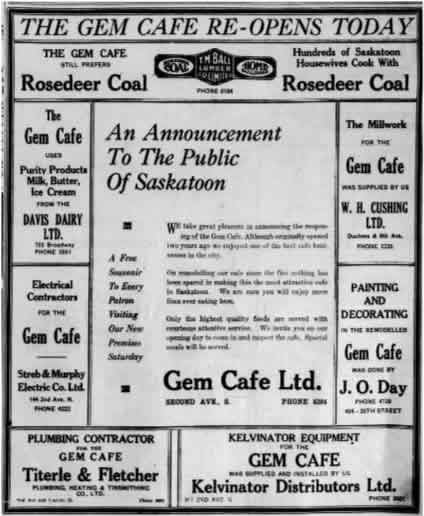
Saskatoon Star-Phoenix, March 12, 1932, p. 9.
In March 1932, the Gem Cafe reopened at the same location. The Cafe’s decor consisted of 35 mauve and light brown booths, huge fans suspended from the ceiling, and a lobby that featured potted plants.
In 1938, John Mirras was voted out of the business as a shareholder and employee. This resulted in a legal dispute, which was resolved in favour of the remaining shareholders (Chrones and the Geatros brothers). James Chrones was a nephew of the Geatros brothers.
By 1939, James Chrones became the sole owner. The Gem Cafe was relocated to the building that was previously occupied by the Elite Cafe (known as the Elite Block) at 244 Second Avenue South. (The Elite Café had moved to a newly constructed building at 224 Second Avenue South). The Gem Cafe occupied the northern half of Elite Café’s former location; the rest of the building was converted into retail space.
The Saskatoon Star-Phoenix described the redecorated lunch counter space now occupied by the Gem Café in the following manner:
“Twenty-four red leather stools surround the red and black three-sided lunch counter. The lunch counter at the front of the building and the entrance to the counter has been finished in a new way with lights of various colors. Part of the very large window at the front has been closed in and finished in colored blocks. The walls of this room are in five shades, ranging from white to a very light tan. Zigzag strips of silver give a finishing touch. There is a long mirror along one wall. Inside the lunch counter proper, glassed-in shelves have been built for keeping pies and pastries. Lighting comes from white glass chandeliers, bearing a red design” (Saskatoon Star-Phoenix, February 10, 1939, p. 5).
Meanwhile, the Gem Café’s dining room consisted of 35 cream-coloured booths. The room’s walls were finished in similar colours as the lunch counter. In addition to the lunch counter and dining rooms, the new cafe included a separate banquet room (“Blossom Room”) to accommodate private gatherings, with seating for up to 40 customers (Saskatoon Star-Phoenix, January 31, 1940, p. 25). In addition to providing meals for its customers, the Gem Café employed two teacup readers (Saskatoon Star-Phoenix, September 28, 1940, p. 5).
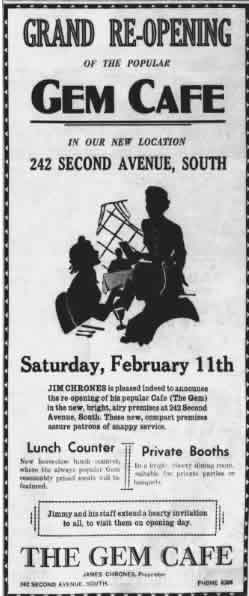
Saskatoon Star-Phoenix, February 10, 1939, p. 5
James continued to build his local reputation as a supporter and promoter of local sports and other community initiatives. He was described in 1940 as having “an active interest in . . . such games as baseball, softball, and hockey [as well as] an ardent supporter of the manly art of fisticuffs” (Saskatoon Star-Phoenix, January 21, 1940, p. 25). During World War II, James supported the city’s regiment, the Saskatoon Light Infantry, by sending cigarettes to the troops (Saskatoon Star-Phoenix, October 10, 1947, p. 19).
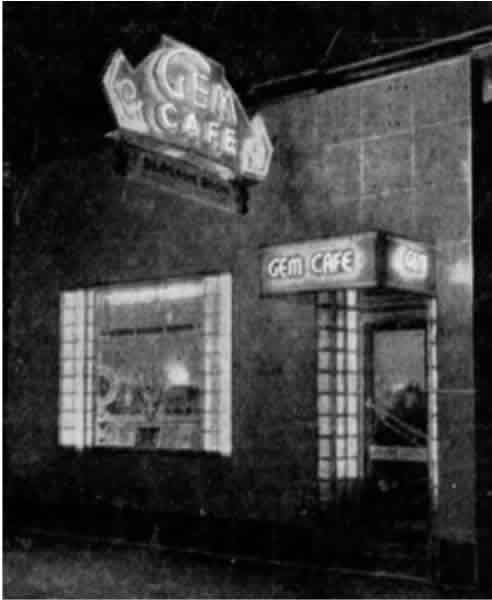
Saskatoon Star-Phoenix, September 21, 1940, p. 5.
In 1947, the Gem Café was again remodelled. The suites on the upper two floors were converted into a hotel, with the entrance at 244 Second Avenue South. Furthermore, the building, which had previously been identified as the Elite Block, was now known as the Gem Block. The newspaper advertisements of the official opening indicated that James had been joined by his son, Jack, in the operation of the Café.
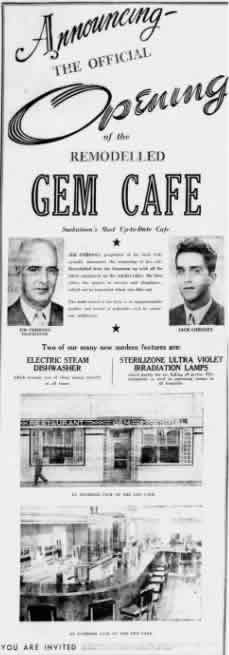
Saskatoon Star-Phoenix, October 10, 1947, p. 19.
The street front of the building was refinished with a façade of beige terra cotta brick and aluminium. The main floor restaurant included a 28-seat counter and seventeen booths. The Saskatoon Star-Phoenix described the redecorated café as “very beautiful” due to its “birch panelling, with an inlay of black walnut [which] has been combined with grey panels of Arborite, to a height of six feet six inches from the floor”. The café had installed “two new ultra-violet irradiation lamp features . . . one at the front of the restaurant and the second over the door leading to the kitchen”. The purpose of the lamps was for “killing germs” (Saskatoon Star-Phoenix, October 10, 1947, p. 19).
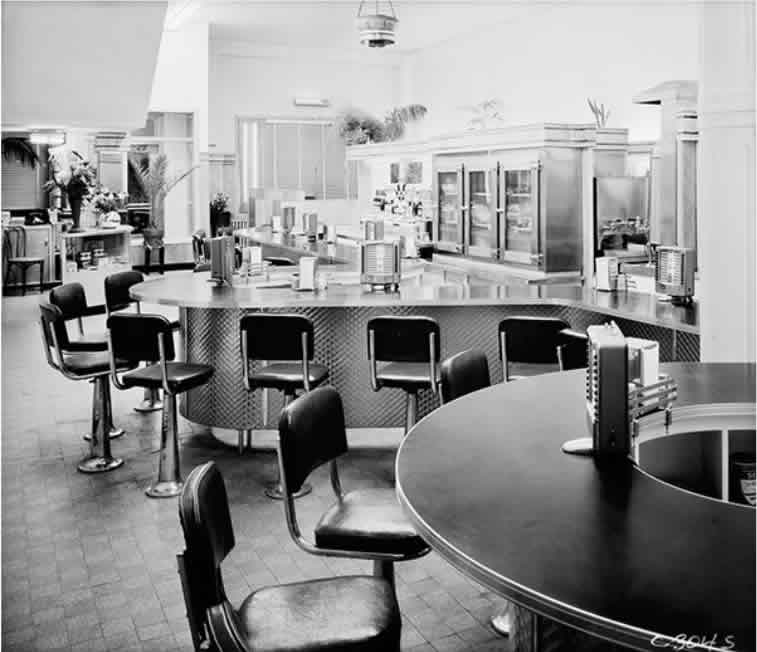
Counter Seating Area, Gem Café, 1949
Saskatoon Public Library, Local History Room (C-304)
The Gem Hotel had 25 single rooms, equipped with hot and cold water. The Saskatoon Star-Phoenix reported that each room was decorated in “a different color scheme with the steel beds to match”; the furnishings were of steel and chromium (Saskatoon Star-Phoenix, October 10, 1947, p. 19).
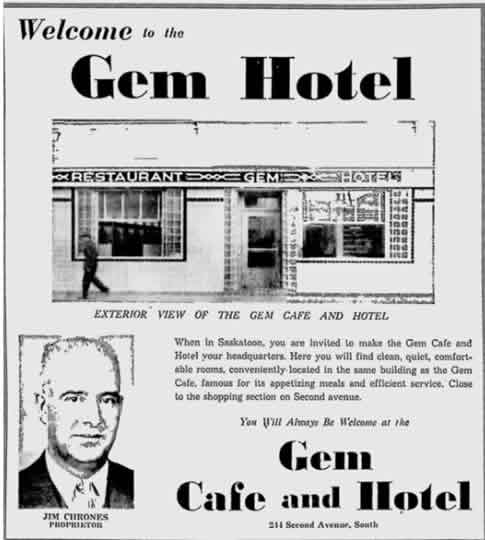
Saskatoon Star-Phoenix, October 23, 1948, p. 14.
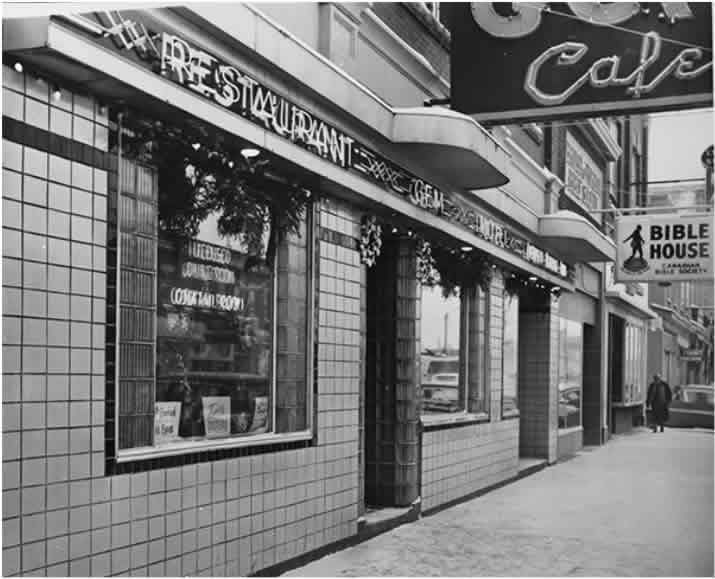
Exterior of the Gem Café and Hotel, circa 1950
Saskatoon Public Library, Local History Room (LH-6026)
In 1950, James Chrones successfully applied to the provincial government for a license to operate a beer parlor in the hotel. The reception desk was at the front end of the beer parlor which was on the main floor of the Gem Block and was adjacent to the Gem Café.
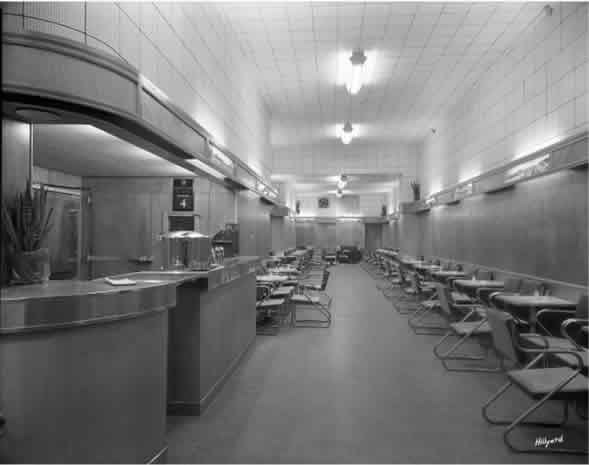
Reception and Beverage Room of the Gem Hotel (1950)
Source: Saskatoon Public Library, Local History (A-2889)
Further renovations were undertaken in 1957. By that time, James and Jack had added Jay Dees Restaurant, located on Eighth Street East, to their business operations.

Saskatoon Star-Phoenix, May 16, 1955, p. 84.
In 1959, the Gem Café opened its Diamond Room, which was the first provincially licensed dining room in Saskatchewan to serve beer, wine and hard liquor with meals (Saskatoon Star-Pheonix, December 23, 1959, p. 3). By 1967, the Gem Café also included a cocktail lounge.
In 1959, the Gem opened the Diamond Room. It was the first dining room in Saskatoon to be licensed to serve beer, wine, and hard liquors with meals.
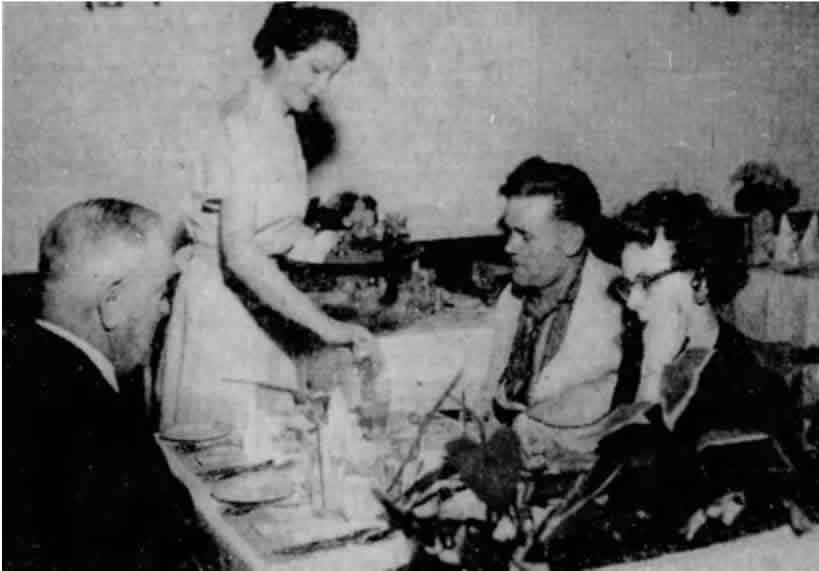
The Diamond Room: The first licensed dining room in Saskatchewan
Saskatoon Star-Phoenix, December 23, 1959, p. 3.
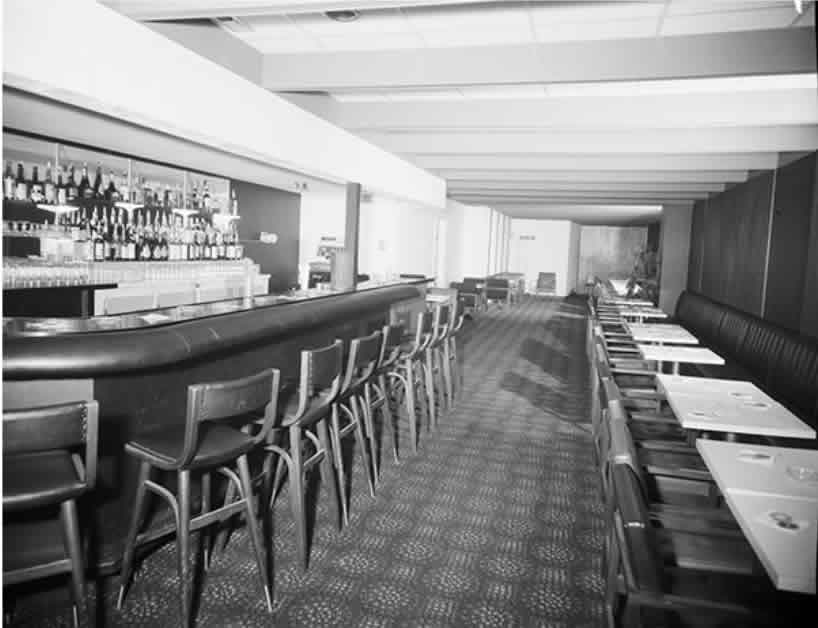
Saskatoon Star-Phoenix, Local History Room (CP-5207-3)
Throughout its history, the Gem Café promoted itself through the quality of its food and the skills of its chefs. In 1947, the Café suggested that its customers would lick their plates clean because the food tasted so good. In 1954, the Café boasted about its new gas broiler which ensured “no more greasy meals”. In 1965, Gem’s newspaper advertising profiled its “two jolly chefs”, Peter Widizizowksi and Peter Symak.
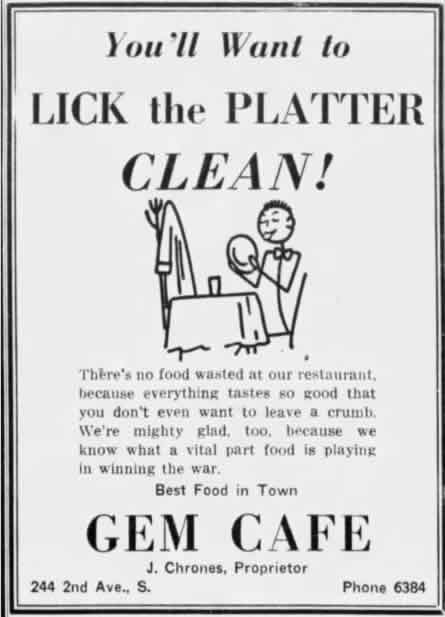
Saskatoon Star-Phoenix, January 31, 1946, p. 22.
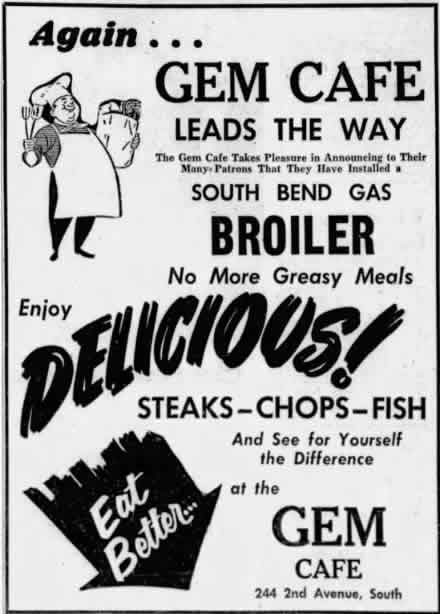
Saskatoon Star-Phoenix, September 10, 1954, p. 18.
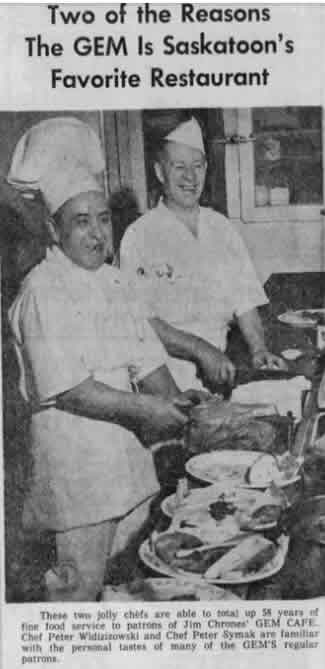
Saskatoon Star-Phoenix, April 17, 1965, p. 7 (modified)
In 1970, changes to the operations and ownership of Gem Café were being hinted. Jack Chrones explained, in an article in the Saskatoon Star-Phoenix, that like many other down businesses, traffic patterns had altered and there was less incentive for shoppers to visit stores on Second and Third Avenues. He attributed a 30% drop in the Gem Café’s noon business and a 50% decline in its Thursday night business to the opening of Midtown Plaza. Also, with respect to a younger population (which he described as 55% of Saskatonians being under 25 years of age), “they’re spending money on food, sure, but they’re not interested in the superb soups and prime ribs of beef chefs like ours turn out. They want pizzas and hamburgers and chips, served up with loud music . . . .” He described the restaurant as “thinning” out to national speciality houses, with the “big fish eating the little ones”. However, he pointed out an advantage held by the “seasoned, experienced restaurant men” like himself— they know “how to work 16 hours a day, every day of the week” (Saskatoon Star-Phoenix, October 24, 1970, p. 13.

Saskatoon Star-Phoenix, July 5, 1971, p. 5.
The Gem Café closed in 1971. Following the closure of the Gem Café, Jack Chrones renovated, rebranded, and reopened the business as Jack’s Food House, which included nightly entertainment. A year later, he had sold the business on Second Avenue. He then established a new business, John’s Prime Rib House, on Fourth Avenue South and Twenty-first Street East.

Saskatoon Star-Phoenix, March 10, 1971, p.2
Researched and written by Ken Pontikes, October 1, 2024
Sources: Saskatoon Star-Phoenix, various editions; Saskatoon Public Library, Local History Room; Henderson Directory, Saskatoon, various editions.
Diana Grill
Diana Grill
142 Second Avenue South
Owner: James Danabassis

Saskatoon Star-Phoenix, April 22, 1968, p. 3.
The Diana Grill opened in October 1958. The cafe was located in the Ferguson Block at 142 Second Avenue South. (The same address where the Silver Grey Café had previously been located.) The grand opening-day special was a $1.00 turkey dinner, consisting of soup or tomato juice; a roast turkey with rice almond dressing, buttered peas, creamed potatoes, and cranberry sauce; sesame roll, a plum pudding or jello dessert; and coffee, tea, or milk. Female customers were given flowers and children dining with their parents received free theatre tickets.

Saskatoon Star-Pheonix, October 17, 1958, p. 5.
The Diana Grill initially advertised as specializing in “inexpensive” dinners and encouraged families to dine at the café on Sundays.
Renovations in 1961 included an “open kitchen” and a redecorated dining room. The Café advertised its “many varieties of pancakes” and its after-theatre “Diana 65er”, consisting of a hamburger, shoestring potatoes, and a 10-ounce milkshake. The price of the hamburger special was 65 cents, but the price was reduced to 33 cents during the café’s fifth anniversary celebration in 1963.

Saskatoon Star-Phoenix, November 24, 1961, p. 14.
The Diana Grill continued to operate until about 1969.
Researched by: Ken Pontikes, November 18, 2024
Sources: Saskatoon Star-Phoenix, various editions; Saskatoon Henderson Directory, various editions.
Shasta Cafe
Shasta Café
213 Second Avenue South
Owners/Operators: Ted and Joseph Gardener (1939 – 1951); Joseph Gardener and Jim Boulis (1951 – 1954);
Joseph Gardener, Gus Togias, and Connie Dennis (1955); Connie Dennis and Gus Togias (1955 – 1960)

Source: Saskatoon’s Greek Community – The Pioneers (1901 – 1949), p. 17.
Brothers Ted and Joseph Gardener opened the Shasta Café in December 1939 in the D. C. Building (213 Second Avenue South). The Café took over the space previously occupied by the Gem Cafeteria/Café, followed by the Embassy Café.

Saskatoon Star-Phoenix, December 22, 1939, p. 2.
Like other restaurants operating at that time, the Shasta Café had a teacup reader. For example, “Professor Kunell” who had come to Saskatoon from Montreal read customers’ teacups from 2:30 to 6:00 p.m. and from 8:30 p.m. to midnight in 1940. In December of that year, “Madam Jeanette” took over. She was described as a psychologist who could foretell customers’ future by reading teacups and palms, as well as analyzing handwriting. She was followed in September 1941 by “the Great Carma” who was described as a “spiritual advisor” and “psychic master”.

Saskatoon Star-Phoenix, September 18, 1941, p. 10.
In December of 1941, a fire mysteriously broke out in the boiler room located n the basement of the D. C. Building. The Shasta’s supplies which were stored in the basement were “ruined”. The rest of the building was damaged by dense clouds of smoke. According to the janitor who discovered the fire, wastepaper on top of the coal heating the boiler was alight. He tried to smother the fire was not successful. Joe Gardener was then informed and he, in turn, phoned in the alarm to the Saskatoon Fire Department. After cutting holes in the floor above the boiler, hoses were inserted, and the fire was extinguished within half an hour of the firefighters’ arrival. Two feet of water in the basement then had to be pumped out. (Saskatoon Star-Phoenix, December 4, 1941, p. 3).
A year later, another fire broke out at the D. C. Building. The afternoon blaze created dense clouds of smoke which prevented firefighters from entering the building. Therefore, they fought the fire from the street and from the rear lane. Several people on the second storey escaped by leaping from a window; other slid down a telephone pole. Three people were injured, including a firefighter who was pinned under falling timbers when the second floor collapsed (Saskatoon Star-Phoenix, December 31, 1942, p. 3).

After the fire at the D. C. Block: Mayfair Ladies Wear on the left and the Shasta Café on the right of the main floor (December 1942)
Saskatoon Public Library, Local History Room (B-3231, B-3232)
Because of the fire, the Shasta Café was not able to reopen until June of 1943. Half of the opening day’s receipts were donated equally between the Kinsmen Milk for Britain Fund and the Greek War Relief Fund.

Saskatoon Star-Phoenix, June 1, 1943. P. 8.
The Gardener brothers sponsored several sports teams. These local teams included the Shasta Café Blue Devils and the Shasta Café Spartans (women’s softball teams), and the Shasta Blackhawks (a women’s basketball team).
In 1945, the Shasta Café closed for renovations during two weeks. In the same year, employees of the Shasta became certified under the Hotel Service and Restaurant Employees’ Union, Local 725, The Labour Relations Board then issued an order for collective bargaining to proceed between management and the union (Saskatoon Star-Phoenix, October 25, 1945, p. 4).

Saskatoon Star-Phoenix, February 21, 1946, p. 14
The Gardener Brothers bought the D. C. Block in the late 1940s from its original owners, Dykes and Charles of Winnipeg (whose initials were in the building’s name). By 1951, the Shasta Café was operated by Joseph Gardener and Jim Boulis. The Gardeners then sold their interest in the building to Harry Wine in 1953 (Saskatoon Star-Phoenix, February 7, 1953, p. 3).

Interior of the Shasta Café (1954)
Source: Saskatoon Star-Phoenix, Local History Room (A-1787)
While Ted relocated permanently to Edmonton, Joe continued to be involved in the operation of the Shasta. In 1955, he operated the Café in partnership with Gus Togias and Connie Dennis. This was in addition to his participation in the Gardener family’s ownership of the New Edmonton Hotel in Edmonton. In June 1955, Joe was found dead of a self-inflicted knife wound (Saskatoon Star-Phoenix, June 7, 1955, p. 1).
In 1960, the Shasta Café was sold to Woo Tape. Following renovations, the café reopened as the “Miami Restaurant” (Saskatoon Star-Phoenix, June 22, 1960, p. 2).
In 1969, the café was reopened under its former Shasta Café name. The Arvanitis Brothers (John, Chris, Dave, and Steve) bought the café. In 1972, they renovated the café and converted it into a supper club, renamed as the New Shasta Café, with live entertainment. The club was designed to accommodate 180 people on the lower-level dining room and another 70 people in the raised cocktail lounge are, just inside the main entrance. Phillip Hills was appointed to manage the club (Saskatoon Star-Phoenix, December 21, 1972, p. 8).
The following year, the club changed its name to the A.Four which they operated at the Second Avenue location until 1985.
Researched by Ken Pontikes, November 25, 2024.
Sources: Saskatoon Star-Phoenix, various editions; Saskatoon Public Library, Local History Room; Saskatoon Henderson Directory, various editions; Saskatoon ‘s Greek Community – The Pioneers (1901 – 1949), p. 17.
Club Lunch
Club Lunch
123 Twentieth Street East
Owner/Operator: Chris Saks
Chris Saks came to Saskatoon in 1944. He had previously operated the Victoria Lunch/Café in Edmonton.
In Saskatoon, he joined Paul Kortes and Arthur Kranias in purchasing the Paris Café. They operated the Café until 1947 when they sold it to “non-Greek” operators.
Chris then became the proprietor of Club Lunch, located at 123 Twentieth Street East. He continued to operate this business until he died in 1951.
The Club Lunch continued to operate, but under a “non-Greek” proprietorship.
Researched by Ken Pontikes, March 14, 2025.
Sources: Edmonton Bulletin (various editions), Edmonton Journal (various editions), Saskatoon Star-Phoenix (various editions); Ancestry.ca
Ritz Cafe and Hotel
Ritz Café and Hotel
118 Twenty-first Street East
Owners/Operators:
- Hotel: William Geatros (1937 – 1949); Peter K. Pontikes (1949 – 1954); Diane Stratas (1954 – 1957); Effie Geatros (1957 – 1984); Diane Stratas (1985)
- Café: William Geatros and James Green (1931 – 1935); Diane Stratas (1954 – 1957); Effie Geatros (1957 – 1984).
The Clinkskill Block was constructed in 1904 by James Clinkskill (the city of Saskatoon‘s first mayor) as a department store, consisting of clothing, grocery, and café components. In 1910, Clinkskill announced that except for the clothing component, he would no longer operate the remainder of the department store but instead would lease the building to third-party businesses.
He initially rented the second floor to small companies and organizations. In 1918, the entire upper floor was leased to Mrs. E. C. Coker who relocated her existing hotel operation, known as the Graycourt Hotel from 212 Twenty-fifth Street West to the Clinkskill Block. The managers of the hotel changed frequently until 1924, when Mrs. Mabel E. Blair became the hotel’s operator.
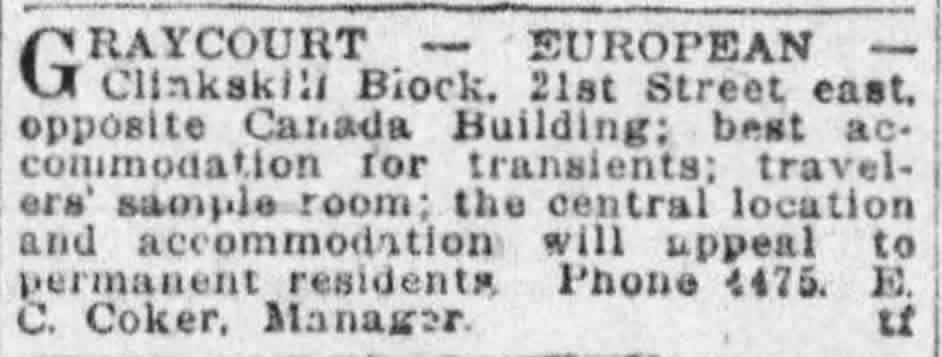 Saskatoon Daily Star, September 10, 1918, p. 14.
Saskatoon Daily Star, September 10, 1918, p. 14.
In 1937, the Graycourt Hotel received a new name – the Ritz Hotel — to be consistent with other businesses operating in the same building. Mrs. Blair continued to operate the hotel – a position she would continue to hold until 1937.
Meanwhile, the Savoy Café operated, through leases, in the westerly half of the building’s first floor. (The other half was occupied by a 300-seat movie theatre.) In 1931, the Café closed following its ownership by a separate company jointly owned by seven Greek restaurants in Saskatoon. The furniture and equipment were sold by auction on September 28, 1931.
The café reopened, after the completion of renovations, on November 14, 1931, under a new name – the Ritz Café. It was managed by William Geatros and James Green. William relocated to Saskatoon from Moose Jaw and was one of the investors in the building. James relocated from Estevan.
By 1937, William Geatros had become the general manager of the Ritz Hotel and of the Ritz Building. He was also one of the owners of the Ritz Building, along with the estate of James Clinkskill (who died in 1936), Thomas D. Smith, Bill’s brother Aristotle/Ted, and Bill’s nephews, Louis and James Chrones.
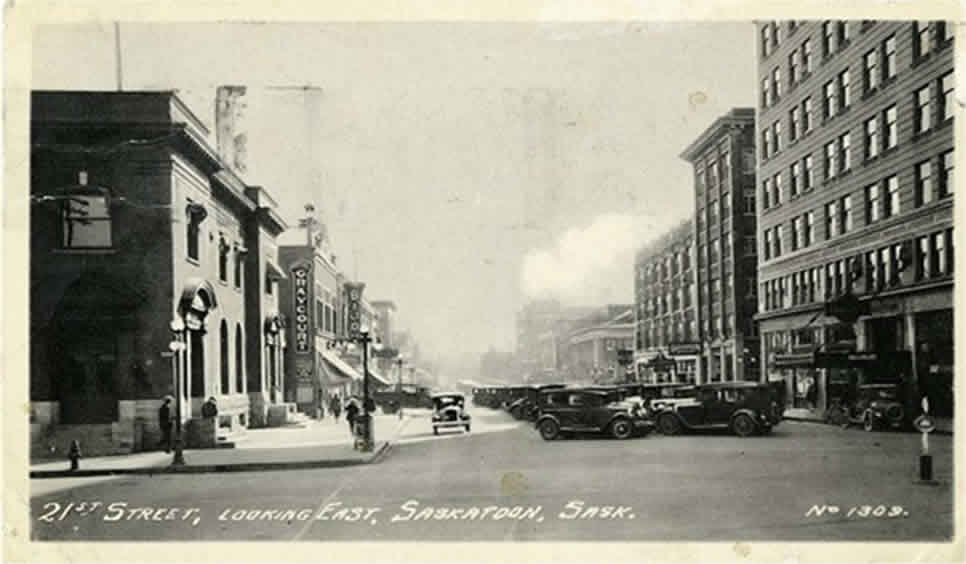
A postcard of Twenty-first Street East with the Clinkskill Block on the left and signage on the building for the Graycourt Hotel, the Bijou Theatre, and the Savoy Café (ca 1930)
Source: Saskatoon Public Library, Local History Room (LH-5319)
“Prohibition” refers to the time in Saskatchewan when the private sale of alcohol was illegal and all bars were forced to close. Residents quenched their thirst with illegally produced alcohol or by having alcohol prescribed for medicinal purposes. In the 1930s, hotels lobbied the provincial government for permission to sell beer by the glass. The hotels argued that without the revenue from beer sales, their existence as viable businesses would be threatened; in turn, their closure could contribute to the demise of many smaller communities where these hotels were located.
Taking direction from the results of a province-wide plebiscite, the Saskatchewan government began issuing licenses to operate beer parlours in hotels, with the number of licenses established in relation to the population of each community. In 1935, the Ritz Hotel applied for a license and received one of the fourteen that were available for Saskatoon.
To accommodate its beer parlor, the Ritz Café was closed and renovated to accommodate the new Ritz Beer Parlour. Food services were reduced to a seven-stool luncheonette, operated by Peter K. Pontikes. The Luncheonette also sold magazines, candy, and tobacco products.
Meanwhile, the owners of the Ritz Building (the estate of James Clinkskill, Thomas D. Smith, Bill and Ted Geatros, and Louis and James Chrones) were seeking leasing opportunities for the basement. The Ritz Social Club, a municipally licensed poker parlor, was shut down when City Council in 1942 no longer issued licenses for these operations. The owners decided to expand the hotel by constructing additional hotel rooms in the basement of the Ritz Block. However, following hotel inspections precipitated by a deadly fire at the Barry Hotel in 1946, Saskatoon’s medical health officer determined that the Ritz Hotel’s basement hotel rooms violated Provincial regulations, particularly concerning not providing access to natural light and to being constructed lower than four feet below ground level.
Another report from Saskatoon’s Fire Chief recommended in 1947, that a new floor could be added to the building to replace the bedrooms now prohibited from the basement. The Fire Chief also recommended that the beer parlor could be moved into the basement and that the resulting freed space on the main floor could be re-established as a café.
However, before any of these suggestions could be given further consideration, a fire at the Ritz Theatre caused sufficient damage to convince the operator that continued operation was no longer feasible. The space on the easterly half of the main floor was now vacant.
Meanwhile, William Geatros was diagnosed with cancer and following months of surgery and experimental treatments, died in July 1949. Bill’s wife, Effie, assumed the role of general manager. She and her brother-in-law, Ted, were now the sole owners of the building.
In 1950, the owners decided to redevelop the theatre’s space as a café. A café manager and chef were recruited to operate the new, “upscale” version of the Ritz Café. Two banquet rooms were constructed in the basement.
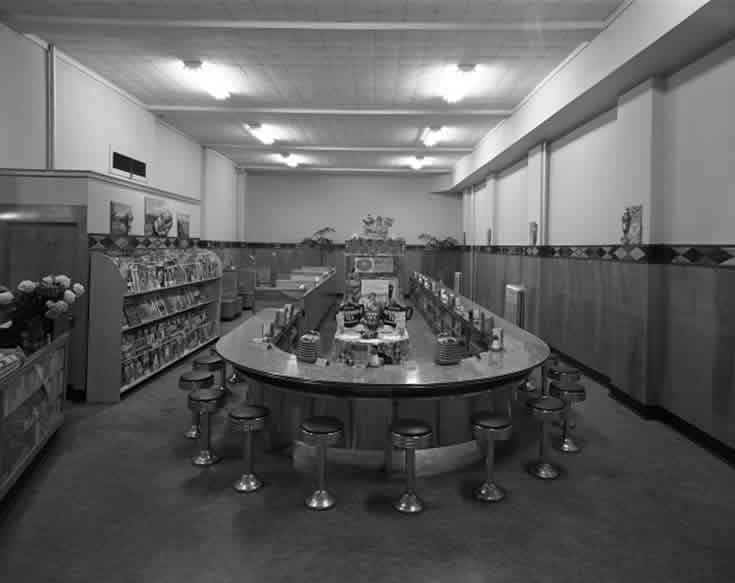
Ritz Café (1950)
Source: Saskatoon Public Library, Local History Room (A-2112)
Initially, Peter K. Pontikes was the general manager of the Ritz Hotel. However, by 1954, he had resigned from this position to pursue other business opportunities. Effie Geatros’ daughter, Diane, became the manager of the hotel and café. Ownership of the building was now with Geatros Holdings, a company consisting of Effie and her three daughters.
Diane moved to Toronto in 1957, after she married her husband, Bill Stratas. Effie took on the role of general manager of the Ritz Hotel and Café.

Source: Saskatoon Star-Phoenix, July 20, 1959, p. 57.
Under Effie’s leadership, the hotel and café continued to operate, but with little promotion or responsiveness to the contemporary competitive business environment. The beverage room, on the other hand, became the primary source of revenue for the Ritz Hotel and Café. Without the beverage room, the rest of the business would not have financially survived.
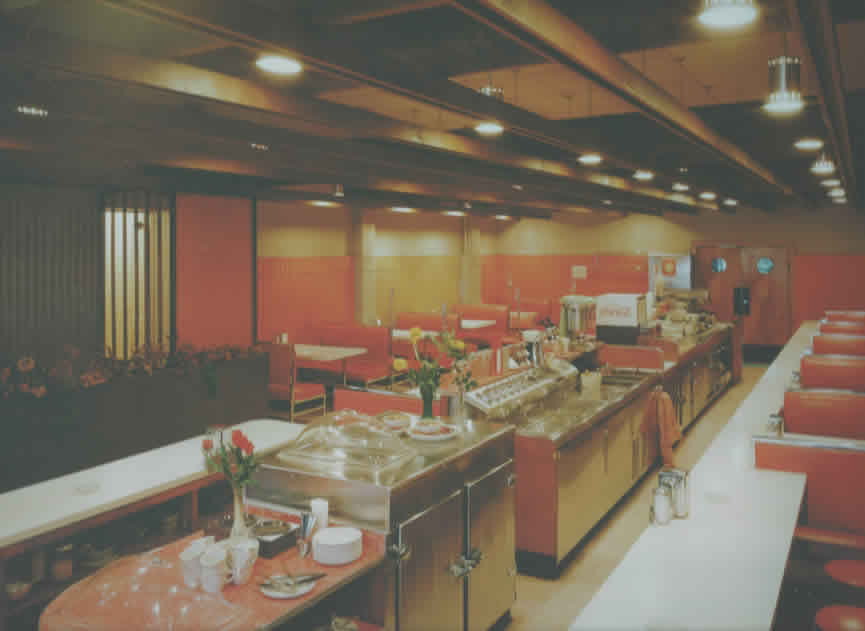
Ritz Café (ca 1970)
Source: Creative Professional Photographers
Renovations to the beverage room were responsive to changing liquor laws. Then, in 1970, a major rebranding and renovation created the Apollo Room, a business concept conceived by Effie’s daughters and featuring large mural photographs of NASA’s Apollo 15 moon landing. The Apollo Room attracted younger drinkers, many of who were not welcomed at other downtown bars because of their appearance, sexual orientation, or attire.
Effie died in 1984, during the night after putting in a full day’s work at the front desk of the Ritz Hotel. Her daughters decided that they could no longer operate the business because they lived in Toronto and that extensive renovations would be required to bring the building to modern-day standards. Therefore, the Apollo Room, café, and hotel were closed.
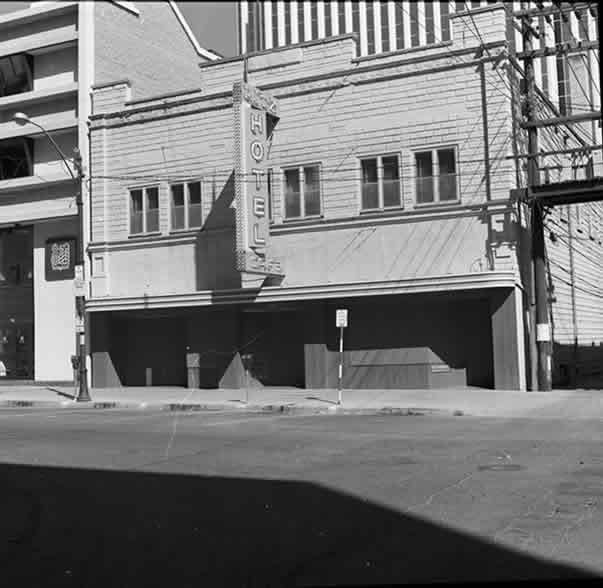
Ritz Hotel and Café following their closure (1985)
Source: Saskatoon Public Library, Local History Room (LH-8708)
The Ritz Block was sold to the adjacently located Royal Bank of Canada in 1985. The building was demolished in 1987,
Researched by Ken Pontikes, April 10, 2025
Sources: Saskatoon Daily Star and Saskatoon Star-Phoenix, various editions; Saskatoon Henderson Directory, various editions; Saskatoon Public Library, Local History Room; City of Saskatoon Archives
Princess Confectionary & Tea Room
Princess Confectionary and Tea Room (“The Princess”)
127 Second Avenue North (1914 – 1921)
145 Second Avenue North (1921 – 1929 )
Owners/Operators (1914 – circa 1925): George Chronis and Nick Lappas
Owners (circa 1925 – 1929): Gus and George Chronis
In 1912, the Chronis brothers, George and Gus, worked with the Golf brothers in operating the Royal Confectionery in Saskatoon. In October of that year, the Chronis and Golf brothers were among approximately 50,000 Greek reservists in North America who had been ordered by the Greek government to return and defend their homeland during the Balkan War of 1912-13.
George Chronis returned to Saskatoon and in 1914, with Nick Lappas, opened the Princess Confectionary and Tea Rooms at 127 Second Avenue North. This business included a candy factory that supplied confectionery products to retail businesses in Saskatoon and beyond.
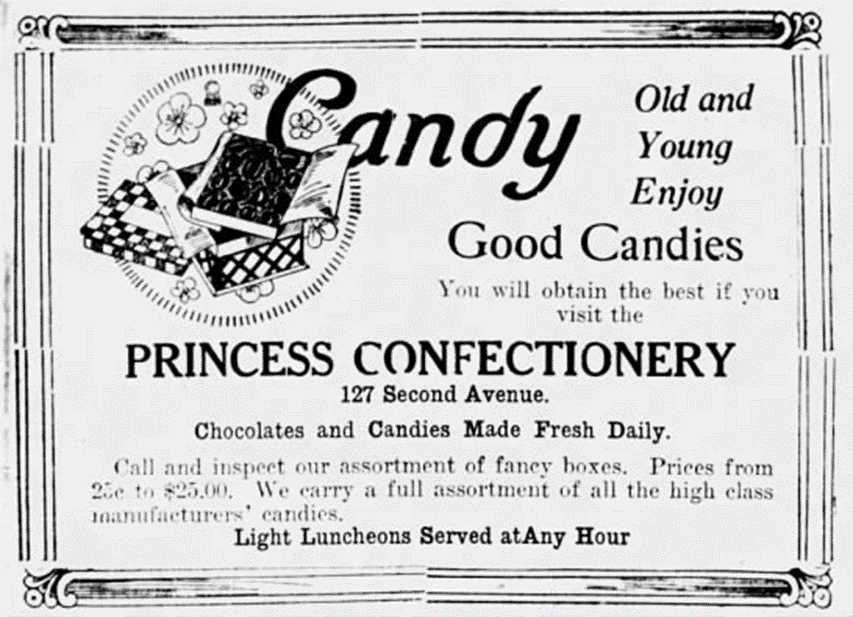
Source: Saskatoon Daily Star, February 28, 1918, p. 14.
By 1920, the Confectionery had expanded to include a tearoom, ice cream parlour, and soda fountain. Light lunches were served in the tearoom. However, the business was centred on the manufacturing and wholesale distribution of candies. By 1921, the business had expanded so much that it had to relocate to new quarters at 145 Second Avenue North, also known as the Gillespie Block.
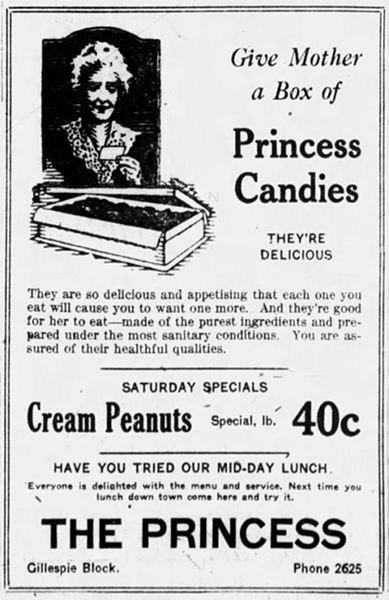
Source, Saskatoon Daily Star, May 11, 1923, p. 10.
By 1925, Nick Lappas had left his partnership with the Chronis brothers and joined other business partnerships.
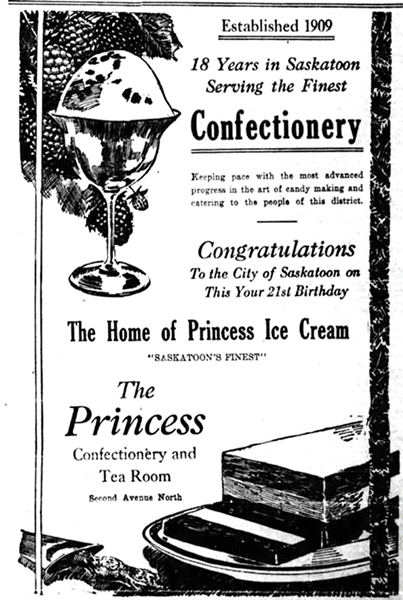
Source: Saskatoon Phoenix, June 30, 1927, p. 11.
The Princess Confectionary and Tea Room continued to prosper under the ownership of the Chronis brothers. In 1929, they purchased the Gillespie building, which their Confectionery shared with a clothing store. Plans were underway to undertake renovations, but tragedy struck in November 1929, when George Chronis passed away suddenly.
Gus sold the business to Charlie Kallops, and Nick Lappas, who by 1930 had rebranded the business into the Golden Gate Café. In addition to a full dinner menu, the café continued the Princess’s traditions of candies and teacup readings. Gus continued to own the building into the 1940s. At that time, the restaurant in the building was known as the Cameo Café and was operated by Ted Gardiner.
Royal Confectionary & Golf's Chocolate Shop
Royal Confectionery, Golf’s Chocolate Shop and Cafe, Golf’s Electric Bakery, Golf’s Pastry Shop, and Golf’s Grill and Sweets
167, 266, and 268 Second Avenue South; 224 Twentieth Street East; 134 Twenty-first Street East; 109 Twenty-third Street East; 116 Third Avenue South
Owners/Operators: Golf Family (Gus, Bill, and Helen Golf)
Gus Golf learned to make candy from his uncle in Aegeon, Greece. He emigrated to the United States in 1904 when he was 21 years old. A year later, he moved to Canada (Hamilton, Toronto, and Winnipeg). His brother, Bill, followed in 1907 when he was 18 years old and together they settled in Saskatoon in 1910.
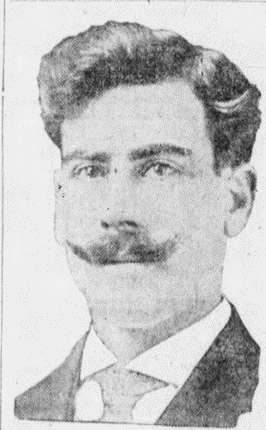
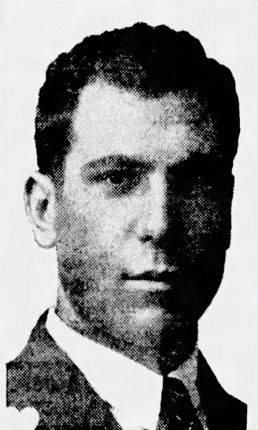
Mr. G. A. Golf Mr. W. (Bill) Golf
Shortly after their arrival, the Golf brothers, along with their nieces, Helen Golf and Mary Golf, were successfully operating the Royal Confectionery Company. It was among the first Greek-owned businesses in Saskatoon. In 1915, the Royal Confectionery was the “only wholesale confectionery business, including manufacturing, between Winnipeg and the coast” (Saskatoon Daily Star, April 23. 1925, p. 12.) It supplied chocolates and candies to retailers throughout Saskatchewan. During the First World War, it also could arrange to send its chocolates and candies as gifts to the Canadian soldiers fighting in Europe.
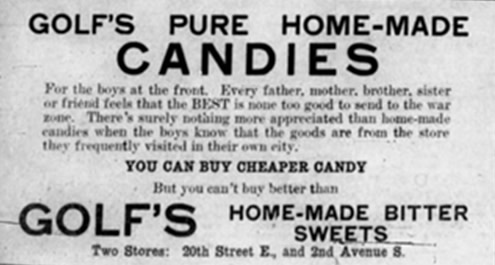
Source: Saskatoon Daily Star, November 6, 1916, p. 2.
The Royal Confectionary Company initially, in 1910, operated a candy-making factory in the Hunt Block at 109 Twenty-third Street East. Rapid growth and expansion of the Golf brothers’ business interests resulted in numerous relocations and property acquisitions. The Company relocated to a “shack” (according to the Golf brothers) located on property at 116 Third Avenue South, which later would be redeveloped in the Ross Block. By 1912, they had moved again to 224 Twentieth Street East.
By 1916, the brothers had two retail stores – the Royal Confectionery at 224 Twenty Street East and the Golf Brothers Confectionery at 266 Second Avenue South. A third store, known as Golf’s Tea Room which sold confectioneries and ice cream, opened at 134 Twenty-first Street East in 1917. The three outlets sold candies and chocolates manufactured in the Golf family’s candy factory, which was relocated from its original Twenty Street location (which it had outgrown) to the second floor of their building on 21st Street. Approximately 30 people were employed in these stores and in the factory.
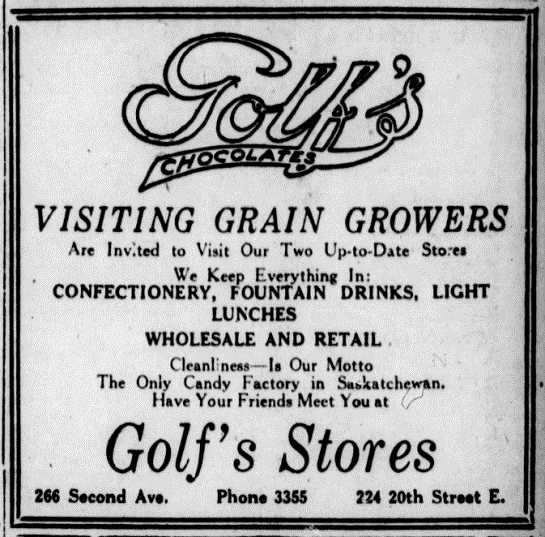
Saskatoon Phoenix, February 15, 1916, p. 9
Golf’s Confectionery and Royal Confectionery Company, 266 Second Avenue South (circa 1917)
Source: Saskatoon Public Library, Local History Room (LH-7118)
In 1918, the retail stores on Second Avenue and on Twentieth Street were closed. However, the second floor of the building on Twentieth Street (which continued to be owned by the Golf family) was remodelled into living quarters for the Golf brothers. The main floor was leased in 1920 to George Gimakas and became the Royal Confectionery and Tea Room; it had several Greek operators until it closed around 1925. By 1920, the remaining Golf-owned outlet on Twenty-first Street had been rebranded as Golf’s Confectionery and Tea Rooms. It is unclear what subsequently happened to the chocolate factory, although it is known that large chocolate factories located in eastern Canada were beginning to dominate the market and were making smaller factories uneconomical to operate.
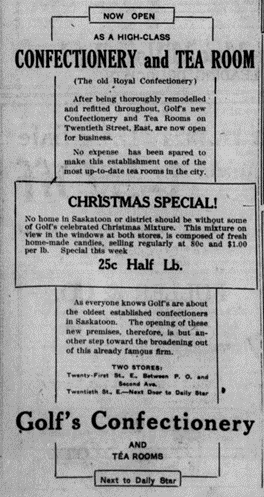
Saskatoon Daily Star, December 22, 1920, p. 12.
Golf’s Chocolate Shop and Cafe was established in 1922. It was located at 167 Second Avenue South (near the corner of Second Avenue and Twenty-first Street East). Gus, Bill, and Helen were identified by the Saskatoon Henderson Directory as the proprietors of the business.
Golf’s Chocolate Shop and Cafe, 167 Second Avenue South, circa between 1922 and 1933
Source: Saskatoon Public Library Local History Room (A-1007)
Golf’s Electric Bakery was opened by the Golf brothers at 134 Twenty-first Street East in 1922 , the former location of Golf’s Confectionery and Tea Rooms. The bakery was Saskatoon’s first bakery using electric ovens, which were considered, in comparison to other bakeries which used steam, to provide a more evenly distributed heat, to be more easily regulated, and to more rapidly reach the required temperature (Saskatoon Phoenix, December 31, 1929, p. 41). The Electric Bakery produced pastry, cakes, and bread — all baked in full view of its customers. The bakery promoted its “English methods” of pastry-making and acquired an electric hot-plate that could produce crumpets. The bakery was an immediate success, requiring the employment of “a large staff to handle the crowds who came to buy and to watch the bakers at work” (Saskatoon Daily Star, January 23, 1923, p. 9).
Frederick D. Kirkby, a prize-winning baker, was recruited to manage the baking processes and recipes. Mr. Kirkby received his training in the United Kingdom. In October of 1922, Gus Golf spoke glowingly about attracting Mr. Kirkby to his business: “With an ordinary baker, I wouldn’t attempt such a venture, but with this man in charge, I am not afraid of what the result will be. He has a most brilliant record, he understands the business right through, and he will have every help that can be given him in the way of materials to work with and equipment” (Saskatoon Daily Star, October 20, 1922, p. 3). Later, an advertisement for the bakery declared that Mr. Kirkby was the recipient of “68 gold, silver, and bronze medals and other first class awards for excellence in pastry and bread making” (Saskatoon Phoenix, March 23, 1923, p. 5). Yet, despite these credentials, Mr. Kirkby lasted in this position only until September of 1923. (In subsequent years, he was employed as a baker in the Paris Cafe and the Zenith Cafe, as well as the Hudson’s Bay Company’s Saskatoon store.)
Golf’s Electric Bakery, 1923
Source: Saskatoon Pubic Library, Local History Room (PH-2016-30)
Golf’s Pastry Shop, established in 1926, was located next door to the Chocolate Shop and Cafe on Second Avenue. It served as a retail outlet for the Electric Bakery’s production.
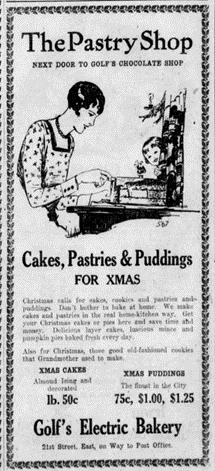
Saskatoon Daily Star, December 20, 1927, p. 22.
In 1925, the Golf brothers purchased two properties adjacent to the Chocolate Shop was located. The additional properties would accommodate a three-fold expansion to the Chocolate Shop. Members of the Golf family occupied the second floor of the building as their residence. Gus Golf described the rationale for this purchase and expansion as follows: “I made my money in Saskatoon . . . and this is where I am going to spend it. The citizens of Saskatoon have been good to me; they have appreciated the many innovations in the candy and confectionery business which I have introduced here, and I find that I cannot accommodate my customers in the present Chocolate Shop” (Saskatoon Daily Star, March 7, 1925, p. 3).
In 1925, Gus Golf was asked what made him and his brother successful businessmen in Saskatoon. He replied: “In the future, as in the past, I intend to be first. We have been successful because we started young and grew up with the business. We adopted our business as a permanent occupation, not just as a gamble. We have aimed to maintain clean establishments, from the front entrance to the back yard, and the public has appreciated this standard” (Saskatoon Daily Star, March 7, 1925, p. 3.). Their business success has also reflected their conviction that Saskatoon would grow and have a strong economic future.
In May of 1926, the Blossom Fruit Store was established within Golf’s Electric Bakery. Blossoms Flowers, managed by John Natt, was added within the Bakery in March of 1927.
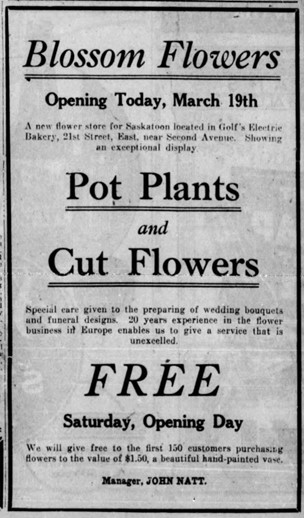
Saskatoon Phoenix, March 19, 1927, p. 7.
In 1928, the Golf brothers sold Golf’s Chocolate Shop, Golf’s Electric Bakery, and Golf’s Pastry Shop to a partnership consisting of Harry Terzakis (recent owner of the Balmoral Cafe in Regina), Gus Natsos (owner of the Union Confectionery in Moose Jaw), and Nick Giokas (owner of the Cameo Cafe in Regina). The stated reason for this sale was that Gus Golf planned to focus his efforts on establishing a new import-export business in Saskatoon for trading products between Canada and Greece.
The partnership continued to operate the Chocolate Shop at 167 Second Avenue South. However, the space occupied by the Electric Bakery and the Pastry Shop on Twenty-first Street was redeveloped into the Commodore Cafe.
Around 1930, the Terzakis-Natsos-Giokas partnership dissolved. Nick Giokas’ brother, John, was subsequently identified as the manager of Golf’s Chocolate Shop. Harry Terzakis and Nick Lappas managed the Commodore Cafe, which was sold in 1932 to Steve Leakos.
In the 1930s, Gus moved his family to Greece where he felt the climate would better suit the health challenges faced by one of his daughters. In 1932, 45-year-old Bill Golf (described as “genial”, “popular” and “devout”) died in Greece following a lengthy illlness (Saskatoon Star-Phoenix, September 9, 1932, p. 6).
By July 1933, Gus Golf was again advertised as the manager of the Chocolate Shop — “after eight years abroad” (Saskatoon Star-Phoenix, July 22, 1933, p. 6). The Chocolate Shop included a bake shop and candy kitchen, which specialized in making bread, cakes, and confectioneries. By the late 1930s, the business had transformed into a “distinctly high-class restaurant” under a new name, Golf’s Chocolate Shop and Cafe, which continued to sell “homemade chocolates, candies, bread, cakes, and pastries” (Saskatoon Star-Phoenix, July 23, 1938, p. 33).
Gus travelled frequently between his family in Greece and his businesses in Saskatoon. When World War II broke out, Gus was in Saskatoon but was separated from the rest of his family who were still in Greece and unable to leave. A family reunification in Saskatoon did not occur until 1946.
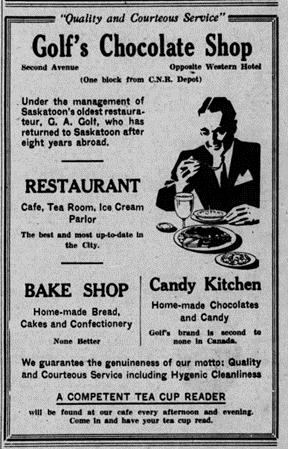
Saskatoon Star-Phoenix, July 22, 1933, p. 6.
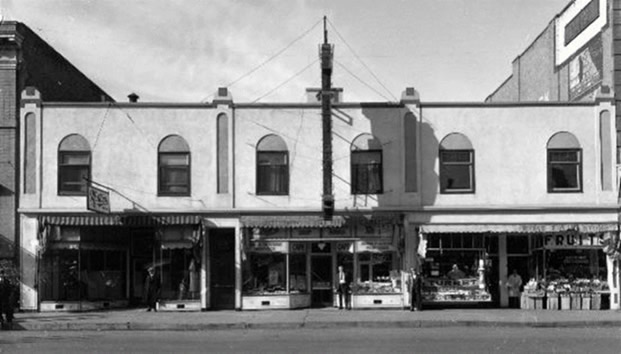
Golf Block, 167 Second Avenue South, circa 1933
Source: Saskatoon Public Library, Local History Room (A-222)
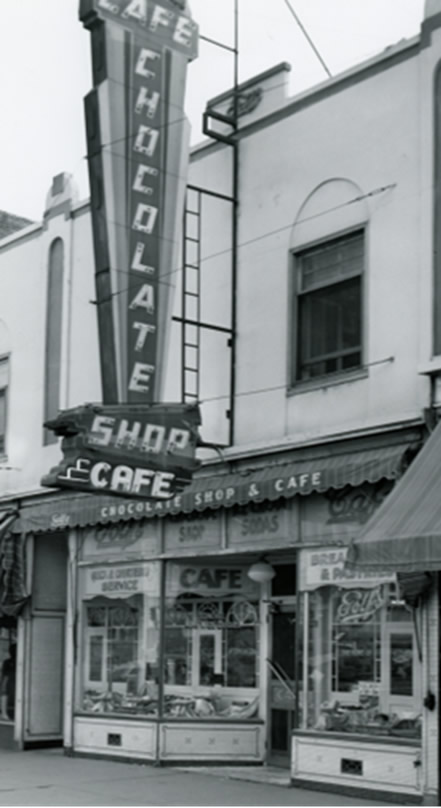
Golf’s Chocolate Shop and Café, 167 Second Avenue South, 1949
Source: Saskatoon Public Library, Local History Room (B-2202-2)
Gus Golf continued to operate the Chocolate Shop and Cafe until December 1952 when it was closed for “alterations”. In 1953, Gus Golf, with his three sons George, Frank, and Peter, renovated and rebranded the Chocolate Shop and Cafe into Golf’s Grill and Sweets.
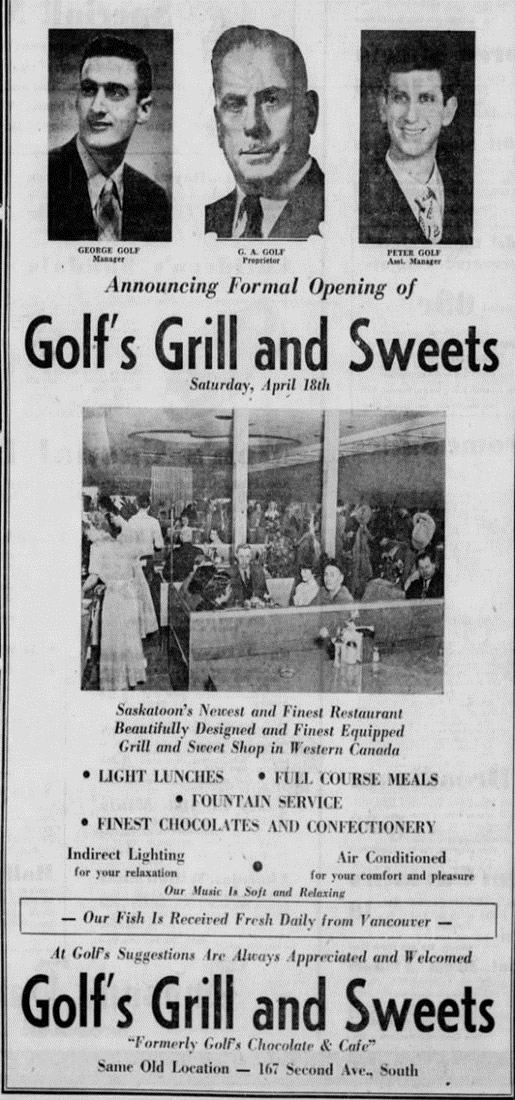
Source: Saskatoon Star-Phoenix, April 17, 1953, p. 17

Golf’s Grill and Sweets (1953)
Source, Saskatoon Star-Phoenix, April 17, 1953, p. 15.
In 1954, a banquet and private dining room (“Zebra Room” was added and the restaurant was renamed as Golf’s Restaurant. Another banquet room (“Terra Bamboo Room” was added in 1957.
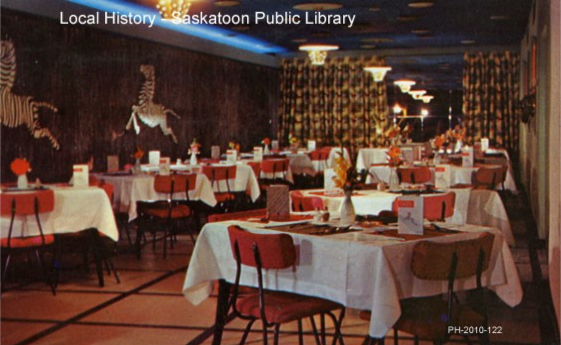
Zebra Room at Golf’s Restaurant
Source: General Photographs Collection, Saskatoon Public Library (ca 1954)
Gus retired around 1956. He turned the operation of his busineses over to his sons. Golf’s Grill and Sweets was soon after renamed as Golf’s Restaurant.
In 1958, Golf’s Restaurant offered a $100 (100 silver dollars) prize for the best “Saskatchewan type Bar B-Q chicken recipe”. The best six submissions would then be prepared by the restaurant’s chefs and judged by a panel of prominent Saskatonians to determine a winner. The winning entry would be incorporated into the Restaurant’s daily menu. Through this process, Betty McCaw’s recipe was chosen.
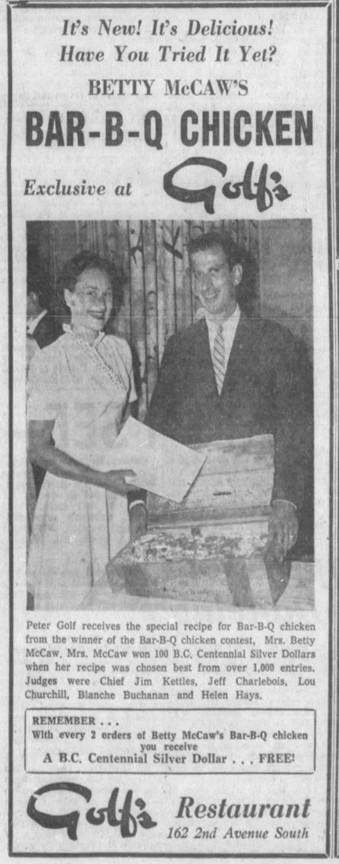
Saskatoon Star-Phoenix, August 9, 1958, p. 4.
In April of 1959, an afternoon fire, caused by an explosion in a nearby automobile, damaged the building where Golf’s Restaurant was located. Other tenants of the building, including the clubrooms of the Young Men’s Hebrew Association, which now occupied the second floor, also incurred fire, smoke, and water damage. The building was insured and Golf’s Restaurant was able to reopen.
However, by the end of the year, the Golf family was negotiating the sale of the business. In February 1960, the family announced that the premises were sold to Pinder’s Drug Stores, effective in March. In April 1960, Pinder’s relocated its cafeteria (previously operating in the King George Hotel) to the space vacated by Golf’s Restaurant.
Gus‘ sons, Peter and Bill, subsequently established, owned, and operated several businesses, including Dog ‘n Suds, Golf’s Steak House, Putt ‘n Bounce, Fuddruckers, and Golf’s Car Wash.
Researched by Ken Pontikes, March 21, 2025
Sources: Various Editions of the Saskatoon Daily Star, Saskatoon Phoenix, and Saskatoon Star-Phoenix; Various editions of the Saskatoon Henderson Directory; Ancestry.ca
